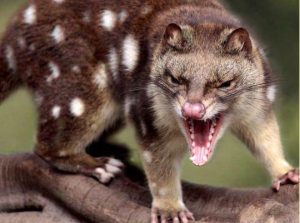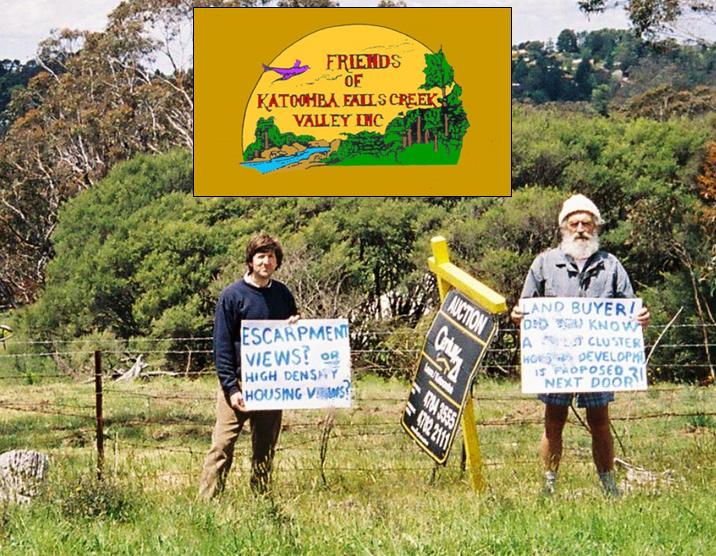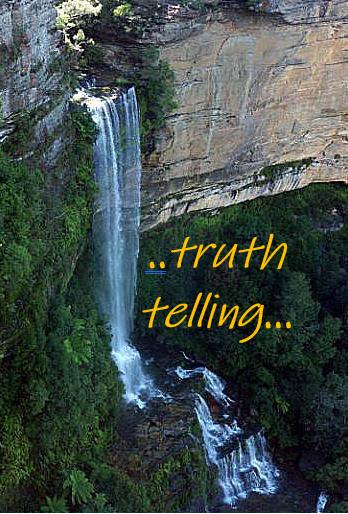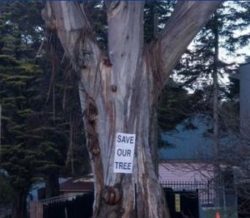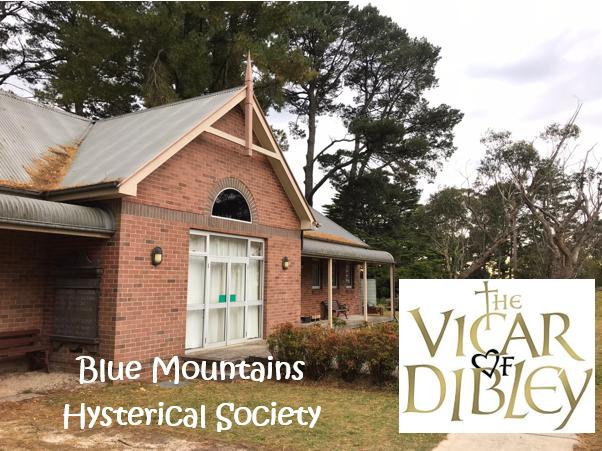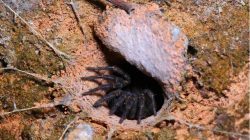Archive for the ‘Habitat Threats’ Category
Saturday, June 22nd, 2013
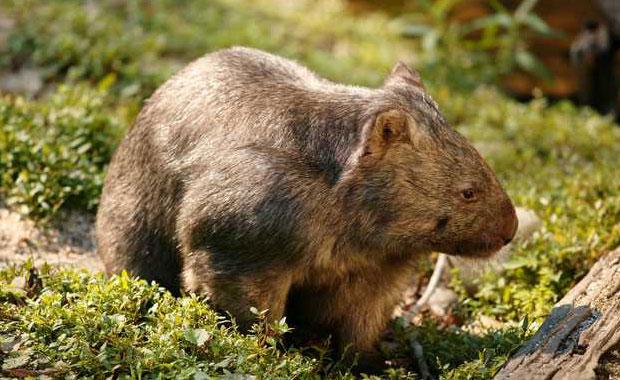 Common Wombat
(Vombatus ursinus)
A legally protected native animal throughout Australia
[Source: Healesville Sanctuary, Victoria, Zoos Victoria,
^http://www.zoo.org.au/healesville/animals/wombat] Common Wombat
(Vombatus ursinus)
A legally protected native animal throughout Australia
[Source: Healesville Sanctuary, Victoria, Zoos Victoria,
^http://www.zoo.org.au/healesville/animals/wombat]
.
June 2013:
.
Tragically, a native Wombat has been deliberately poisoned this month in Mount Wilson in the Blue Mountains, and so the New South Wales National Parks and Wildlife Service (NPWS) is appealing for information from the local community.
Ranger Neil Stone of the NPWS Blue Mountains Region:
“A Wombat was recently found at Mount Wilson village (population 220), suffering from what a local veterinarian thinks was poisoning and sadly the animal had to be euthanized.
“Wombats become unpopular with landholders when they damage fences and infrastructure or trample on gardens. But there are methods, including installing Wombat Gates, that enable Wombats to pass through properties without damaging them.”
.
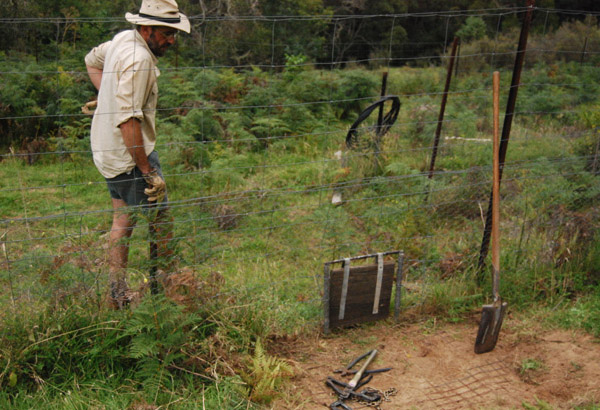 An example of a purpose-built Wombat Gate
If one can afford property at exclusive Mount Wilson with average prices currently $750,000 [^Source]
then one can afford to contribute a few purpose-built Wombat Gates across their property,
constructed by wildlife experts who know what they are doing!
[Photo Source: Rocklily Wildlife Refuge, Taralga, NSW,
^ http://rocklilywombats.com/blog/rocklily-history/] An example of a purpose-built Wombat Gate
If one can afford property at exclusive Mount Wilson with average prices currently $750,000 [^Source]
then one can afford to contribute a few purpose-built Wombat Gates across their property,
constructed by wildlife experts who know what they are doing!
[Photo Source: Rocklily Wildlife Refuge, Taralga, NSW,
^ http://rocklilywombats.com/blog/rocklily-history/]
.
NPWS Ranger Neil Stone:
“Wombats are extremely strong and determined, constructing their burrows (often under homes) to escape from the heat and to hide from predators (typically domestic and feral dogs nowadays). The burrows can be up to 30 metres long which can cause conflict between Wombats and humans.”
“Wombats and all other native animals are protected under the National Parks and Wildlife Act 1974 and Regulations and it is illegal to harm them without a licence. There are fines and possible imprisonment for people found to have intentionally harmed native wildlife.”
.
[Source: ‘Not so divine: Wombat dies in suspected poisoning’, 20130612, Blue Mountains Gazette newspaper (print only), p.15]
.
Wildlife Poisoning is Animal Harm
.
Wombats being mammals are sentient animals, meaning that they feel emotion and pain. An animal is ‘sentient‘ if it is capable of being aware of its surroundings, its relationships with other animals and humans, and of sensations in its own body, including pain, hunger, heat or cold.
Individuals who harm animals including the harming of wildlife such as by poisoning, tend to harbour a personality disorder. Statistically, animal abusers are five times more likely to go on to commit violent crimes against people.
Deviant behaviors like animal abuse generally originate from a traumatic childhood. The American Psychiatric Association considers animal cruelty as one of the diagnostic criteria of conduct disorder.
The fourth edition of the Diagnostic and Statistical Manual of Mental Disorders (DSM) defines conduct disorder as “a repetitive and persistent pattern of behavior in which the basic rights of others or major age appropriate societal norms or rules are violated.” Conduct disorder is found in those who abuse animals and abuse people.
Clinical evidence indicates that animal cruelty is one of the symptoms usually seen at the earliest stages of conduct disorder, often by the age of eight. This information has only recently been included in the DSM so some psychologists, psychiatrists, and social workers are just now becoming aware of it. Many psychological, sociological and criminology studies in recent decades have clearly shown that violent offenders have adolescent histories of serious and repeated animal cruelty.
Director of People for the Ethical Treatment of Animals (PETA) Asia, Jason Baker, has said, “We believe that cruelty to animals is not inherent, but learned. That being said, teaching kindness and respect for animals – in our schools and homes – will foster empathy, the ability to understand what someone else feels.” He added, “Incorporating the simple concepts of kindness and respect into our daily lives and teaching our children to respect and protect even the smallest and most despised among us will help kids value one another.”
The link between animal abuse and interpersonal violence is becoming so well established that many U.S. communities now cross-train social-service and animal-control agencies in how to recognize signs of animal abuse as possible indicators of other abusive behaviors. >>
.
[Source: ‘Animal Cruelty Syndrome’, by Canadians for Animal Welfare Reform, ^http://cfawr.org/animal-abuse.php]
.
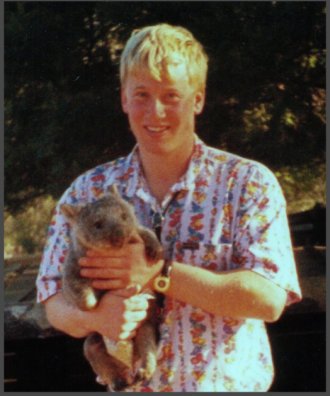 Martin Bryant as a teenager nursing a juvenile Wombat
Bryant reportedly tortured animals as a child.
In 1996, at age 29 Bryant murdered 35 people and injured 21 others
at Port Arthur Tasmania Martin Bryant as a teenager nursing a juvenile Wombat
Bryant reportedly tortured animals as a child.
In 1996, at age 29 Bryant murdered 35 people and injured 21 others
at Port Arthur Tasmania
.
Penalties in NSW for Harming protected Fauna
.
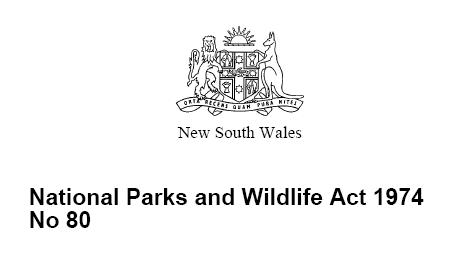
.
Sect 98 ‘Harming protected fauna, other than threatened species, endangered populations or endangered ecological communities’
.
(Ed: i.e. Wombats)
.
(1) In this section, protected fauna does not include threatened interstate fauna, threatened species, endangered populations, endangered ecological communities, or locally unprotected fauna under section 96.
(2) A person shall not:
(a) harm any protected fauna, or (a1) harm for sporting or recreational purposes game birds that are locally unprotected fauna, or
(b) use any substance, animal, firearm, explosive, net, trap, hunting device or instrument or means whatever for the purpose of harming any protected fauna.
.
Maximum penalty:
.
(a) 100 penalty units and, in a case where protected fauna is harmed an additional 10 penalty units in respect of each animal that is harmed, or
(b) imprisonment for 6 months, or both. >>
.
Note: As at 2013, 1 penalty unit in NSW equates to $110. So 100 +10 penalty units incurs a fine of $12,100 per protected Wombat harmed [Calculation: (100 + 10) x $110]
.
[Sources: National Parks and Wildlife Act 1974, No 80, Section 98, (historical version but this section still current), pp 149-150, ^http://www.environment.nsw.gov.au/legislation/NationalParksAndWildlifeAct1974.htm ; ^http://en.wikipedia.org/wiki/Penalty_units]
.
.
.
So who killed the Mt Wilson Wombat?
.
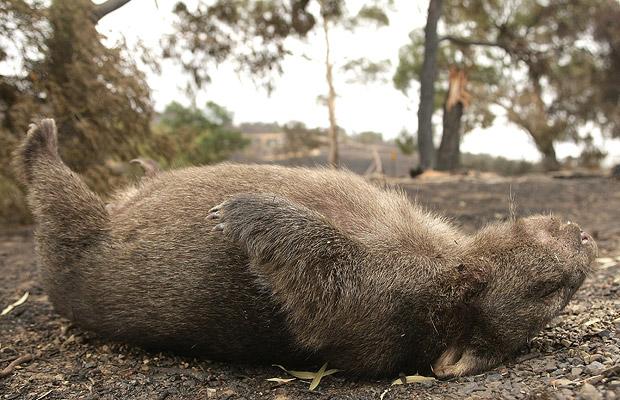 A common Wombat sight
…”Just Roadkill”
A common Wombat sight
…”Just Roadkill”
.
It is likely that Mount Wilson’s Wombat was poisoned by an ignorant and frustrated local landholder. He is one of just a few hundred residents living at remote Mount Wilson village, and probably he is some arrogant newcomer with no respect for the natural environment or its resident wildlife who were there first. It is extremely rare for a female to commit wildlife poisoning.
The perpetrator is likely to be someone holding an Anglicised mindset toward rural property, desiring the exotic deciduous garden and with a phobia towards the natural Australian bush. Whereas the more established residents tend to be respectful towards the special environment in which they live and have become more accommodating towards the place’s resident wildlife.
 Mount Wilson lies in a remote forested wilderness region of the Blue Mountains
And the native Wombats have lived there thousands of years before
Colonial Deforestation
Housing Development
Anglicised Garden Romanticism
[Source: Google Earth]
(click image to enlarge) Mount Wilson lies in a remote forested wilderness region of the Blue Mountains
And the native Wombats have lived there thousands of years before
Colonial Deforestation
Housing Development
Anglicised Garden Romanticism
[Source: Google Earth]
(click image to enlarge)
.
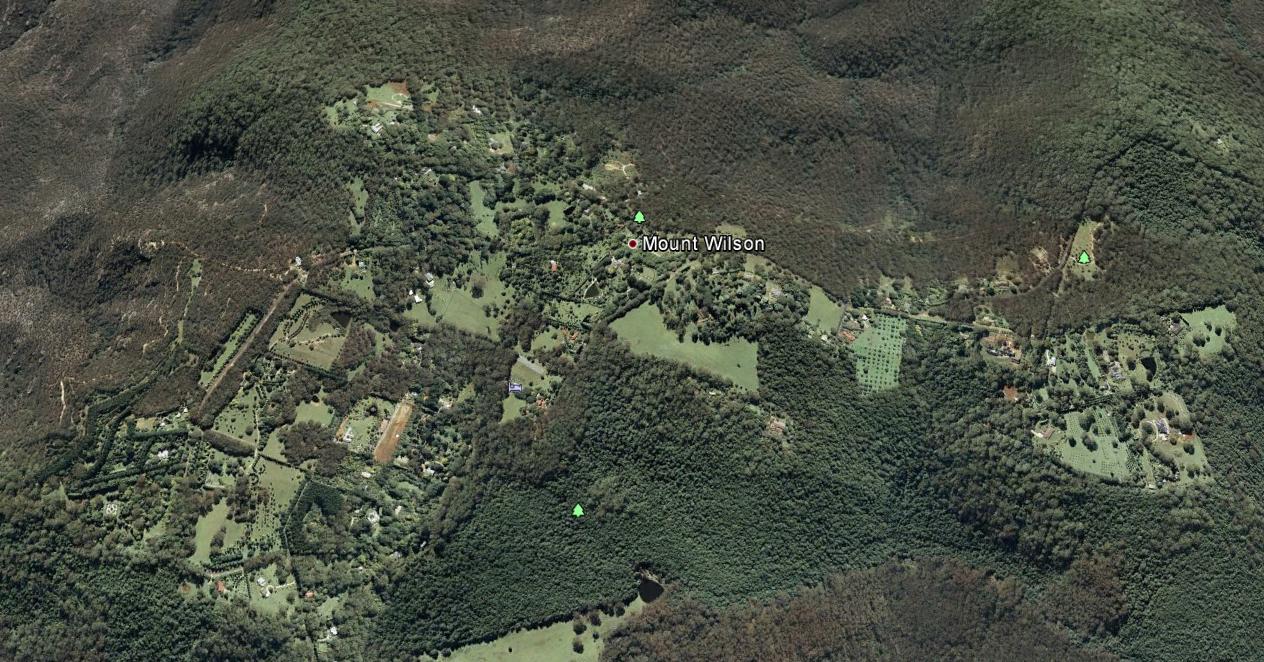 Mount Wilson
Best described as a remote hilltop residential hamlet
Situated on an ancient volcanic hill
Since the 1870s, logged, burned and settled by English colonists
amongst the ‘Wombat Holes’
[Source: Google Earth]
(click image to enlarge)
Mount Wilson
Best described as a remote hilltop residential hamlet
Situated on an ancient volcanic hill
Since the 1870s, logged, burned and settled by English colonists
amongst the ‘Wombat Holes’
[Source: Google Earth]
(click image to enlarge)
.
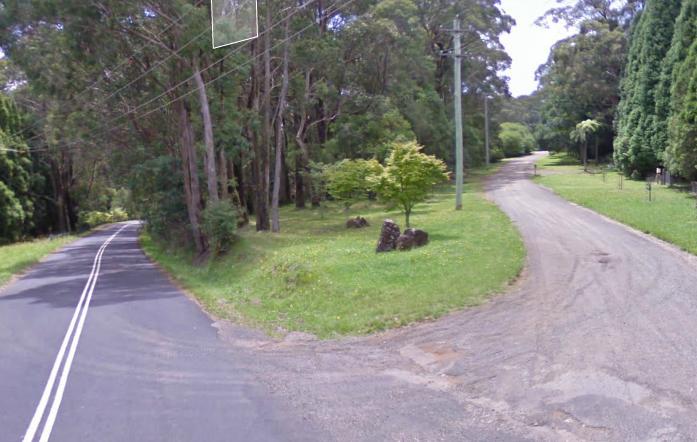 Hillcrest Lane (right), Mount Wilson Hillcrest Lane (right), Mount Wilson
[Source: Google Maps, 2013]
.
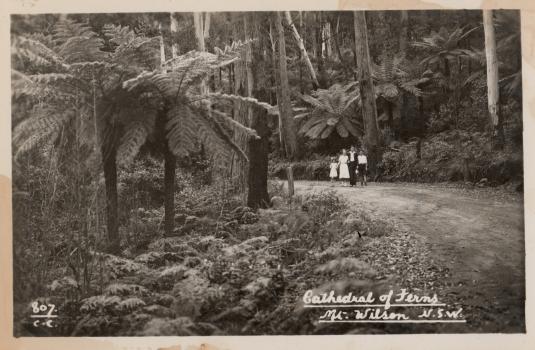 Mount Wilson before the Anglicising
[Source: Mt Wilson/Mt Irvine Historical Society, ^http://www.mtwilson.com.au/]
Mount Wilson before the Anglicising
[Source: Mt Wilson/Mt Irvine Historical Society, ^http://www.mtwilson.com.au/]
.
Consistent with the profile of the typical member of the Game Council NSW, the perpetrator is likely to be a middle-aged or older male Babyboomer approaching 65, having an anthropocentric worldview of Nature, and an evangelistic belief that economic growth and personal wealth accumulation is a right – Wombats being collateral damage in rural housing development.
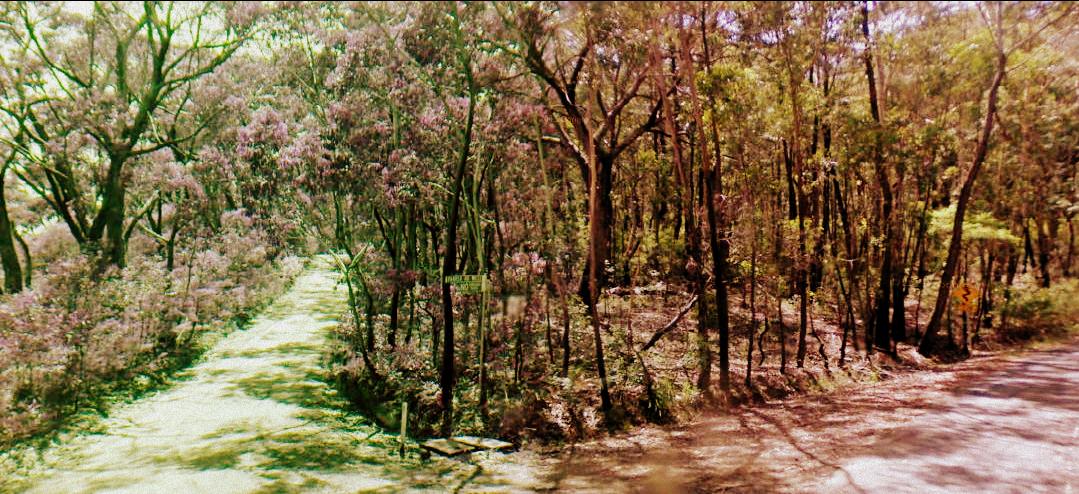 Mount Wilson bushland
Mount Wilson bushland
.
The perpetrator has not yet been confirmed, and anyone with information about this harmful offence is asked to contact the closest NPWS base at the Blue Mountains Heritage Centre in nearby Blackheath.
.
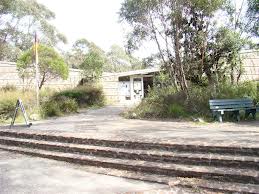 NPWS Blue Mountains Heritage Centre
Located towards the eastern end of Govetts Leap Road
outside the nearby township of Blackheath NPWS Blue Mountains Heritage Centre
Located towards the eastern end of Govetts Leap Road
outside the nearby township of Blackheath
.
.
.
The ‘Common‘ Wombat?
.
The Common Wombat (Vombatus ursinus) is also known as the Coarse-Haired Wombat or Bare-Nosed Wombat. In the case of the Bare-Nosed Wombat, this reference to its nose, distinguishes it from its other two subspecies, the Southern Hairy-Nosed Wombat (Lasiorhinus latifrons) and the endangered Northern Hairy-Nosed Wombat (Lasiorhinus krefftii).
The ‘Common Wombat‘ is a nocturnal marsupial native to south eastern Australia and is found in small sections of southeast tip of Queensland, eastern New South Wales, eastern and southern Victoria, and south-east South Australia. They are common throughout Tasmania and also on Flinders Island in Bass Strait.
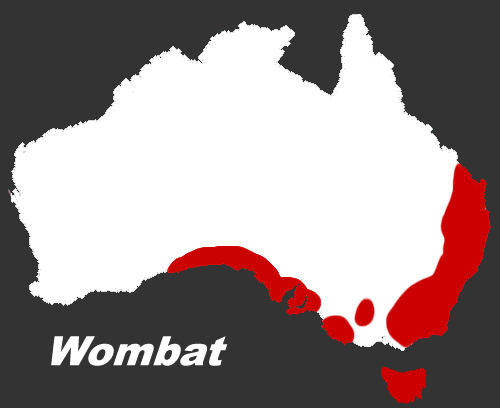
The head of the Common Wombat is more rounded than that of the hairy-nosed subspecies. Their short ears are triangular and slightly rounded. Their nose is large, shiny black and furless. Their fur is coarser, thicker and longer than that of the Hairy-nosed Wombats, better suited to a colder, wetter habitat. Fur colour varies from sandy to brownish black or even grey, sometimes flecked.
.
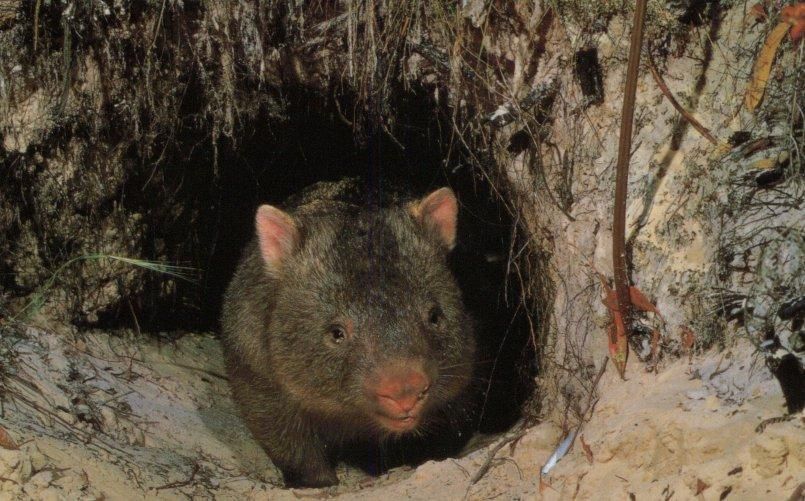 Bare-Nosed Wombat
a more respectful naming than ‘Common’ Bare-Nosed Wombat
a more respectful naming than ‘Common’
.
Wombats have short legs, and the second and third toes of the hind feet are fused, with a double claw used in grooming. Wombats are solid and stocky, with short legs and tail. Their front legs and shoulders are powerful. Their front feet are large, with bear-like long claws. They use their front legs for digging burrows. The dirt is pushed to one side and the Wombat backs out, moving loose dirt with front or back paws. It grows to an average of 98 cm long and up to a healthy weight of 26 kg.
Wombats are stilll classed as ‘least concern’ by the International Union for Conservation of Nature and Natural Resources (on the IUCN ‘red list’). [Ed: So were the Koala and Tasmanian Devil until recently].
At Healesville Sanctuary in Victoria, more than 2,000 sick and injured native animals treated each year including Wombats at its Australian Wildlife Health Centre.
[Source: Healesville Sanctuary, Zoos Victoria, Victorian State Government, ^http://www.zoo.org.au/healesville/animals/wombat]
.
 Situated on Badgers Creek
A place of inspiration to this Editor,
when visited as a child. Situated on Badgers Creek
A place of inspiration to this Editor,
when visited as a child.
.
Although Wombats have been named by European Australians as the ‘Common Wombat‘, their numbers and their existence value does not translate to anyone treating them as commonplace.
Common Wombats were once widespread from south-eastern Queensland, through NSW along the Great Dividing Range and most of Victoria. Now they have a fragmented distribution in NSW, being most abundant in the south-eastern parts of the state. Remaining populations are under continued pressure from land clearing, road mortality, disease and illegal shooting. These pressures may be acute for some local populations.
While the word ‘Wombat’ is derived from the Aboriginal name for the animal, ‘common’ was added at a time when these animals were plentiful and the Australian bush landscape relatively less destroyed by colonial settlement. Wombats were likened to European Badgers by the early colonists.
We prefer the more respectful name, ‘Bare-Nosed Wombat‘.
.
In 2010, university student Nikki Selles, from the School of Natural Sciences at the University of Western Sydney, undertook a field fauna study on Wombats in the Mt Wilson and Mt Irvine area. Due to the behaviour of slow moving, ground-dwelling Wombats being sensibly shy and noctural, Selles used camera-trap data to identify their habitat and distribution in the urban-bush interface.
Results ought to be obtainable from the university.
[Source: Mount Wilson and Community Newsletter, May 2010, ^http://www.mtwilson.com.au/images/stories/MWPA_Newsletters/May_2010.pdf]
.
While the Bare-Nosed Wombat is not yet threatened with extinction, the Northern Hairy-Nosed Wombat is endangered. This is mainly due to overgrazing by sheep and cattle destorying their fragile semi-arid habitat across more central Australia, as well as the culture of broadscale hazard reduction and uncontrolled bushfires.
Mount Wilson also provides vital native habitat for fauna species that are recognised as endangered. These include the Sooty Owl (Tyto tenebricosa), the Eastern Bent Wing Bat (Miniopterus schreibersii oceanensis), the Large eared pied bat (Chalinolobus dwyeri), Little John’s Tree Frog (Litoria littlejohni), and the Eastern False Pipistrelle (Falsistrellus tasmaniensis).
.
Living with Resident Wombats
.
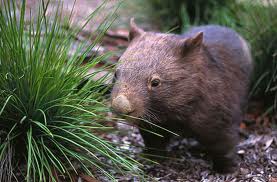 Wombats are locally territorial, like Humans
Try to relocate them, and they will stubbornly resist – even after repeated flood, drought, bushfire and earthquake
Ask any Human who has endured such tempest. Wombats are locally territorial, like Humans
Try to relocate them, and they will stubbornly resist – even after repeated flood, drought, bushfire and earthquake
Ask any Human who has endured such tempest.
.
<<Wombats are an iconic part of the protected fauna of NSW. They are extremely strong and determined animals.
They can build their burrows under Human-introduced houses, driveways and cattle stock routes. This may cause Humans inconvenience and conflict between Wombats and non-Indigenous Humans.
.
But Newcomer Humans need to respect that Wombats were there first.
Who likes Invasion or Displacement?
.
Human-Wombat conflicts can be respectfully resolved and accommodated by wisdom – by learning about the behaviour of Wombats and understanding their habitat needs.
The Bare-Nosed Wombat is the species most frequently found in NSW. They prefer temperate forested areas of the coast, ranges and western slopes. Slopes above creeks and gullies are favoured sites for burrows and they like to feed in grassy clearings, including farm paddocks.
.
Wombat Habitat Needs
.
Wombats construct burrows to escape the heat and hide from predators. They prefer areas where it is easy for them to dig. The burrows can be up to 30 metres long and several metres deep and are usually situated above creeks and gullies and may have multiple entrances. Active burrows are often characterised by fresh cube-shaped droppings and scratch marks as well as freshly dug soil at the burrow entrance. Wombats will often build more than one burrow within their home range of 5 to 25 hectares.
Wombats are mostly solitary animals, but overlapping home ranges can occasionally result in a number of Wombats using the same burrow. Wombats are possessive about their particular feeding grounds and they will mark out these areas by leaving scent trails and droppings. These markings are prominently placed on rocks and logs around the boundaries. If an intruding Wombat encroaches on another’s territory it will be discouraged through a series of snorts and screeches and at times physical aggression.
Breeding occurs year-round with each female typically producing one young. In some areas, however, Wombats are seasonal breeders and may have dependent young in burrows from April to June. Young Wombats take up to 21 months to reach full independence and two years to become sexually mature.
.
Wombat Behaviour
.
Wombats become unpopular with landholders when they damage fences and infrastructure or trample upon gardens. Undetected burrows can be a hazard to livestock as they may trip or fall into burrows and injure themselves.
Many of the problems caused by Wombats can be resolved with some patience and innovation. Landholders willing to share their property with Wombats may find that there are simple solutions to most problems. For example, a post or small strand fence can be used to mark burrows in paddocks or driveways to keep stock away from burrow entrances.
Wombats use the same trails to get to and from their preferred feeding areas. Instead of going around an obstacle, such as a fence, a determined Wombat will try to go through, or under it instead. Installing purpose-built ‘Wombat Gates’ at known Wombat breech points along a fence will allow them to pass through a fence without damaging it. The fence needs to continue to exclude other animals such as wallabies, rabbits and foxes.
Removing the lowest fencing wire (15 cm above ground level) will also allow Wombats to move through an area without damaging the fence. This is a much cheaper option than excluding them completely.
Check first with a Certified National Parks Wildlife Ranger.
.
Excluding wombats from Rural Property
.
It is possible to exclude Wombats from continuing to use a burrow that is under a building but this requires intervention by a Certified National Parks Wildlife Ranger.
.
Increasing Native Vegetation
.
Wombats prefer to burrow in areas of vegetation and rocky debris. Land clearing has forced Wombats to build burrows along creeks and drainage lines where vegetation still exists. Wombats are also often incorrectly blamed for causing erosion, which is more likely due to poor land management practices.
Planting trees and revegetating areas away from creeks can play a vital role in reducing Wombat burrowing activity along creek beds. Retaining existing trees, logs and rocks, and establishing new areas of native vegetation encourages Wombats to construct burrows in less fragile areas and reduces the risk of erosion.
Check first with a Certified National Parks Wildlife Ranger.
.
Trapping or Relocating Wombats Prohibited
.
The trapping and relocation of Wombats is prohibited and attracts heavy fines.
Wombats are territorial animals and if relocated, they are likely to be harassed or even killed by resident Wombats. Wombats are classified as protected fauna under the NSW National Parks and Wildlife Act 1974.
.
Can I bulldoze or infill a Wombat burrow?
.
No! Only inactive Wombat burrows may be destroyed, but each one needs to be first validated by a Certified National Parks Wildlife Ranger.
Bulldozing an active burrow can lead to wombats being buried alive and suffering a slow and painful death. Even if you have located an apparently vacant burrow, you must not fill it in without confirming that it is inactive. Burrow activity can be confirmed by placing sticks across each entrance and checking (every day for at least a week) if these are disturbed.
Remember that if you think you have an inactive burrow, check first with a Certified National Parks Wildlife Ranger.
contact your local National Parks office for expert verification before any action.
.
[Source: NSW Government, ^ http://www.environment.nsw.gov.au/animals/LivingWithWombats.htm#gate]
.
.
.
Further Reading
.
[1] Wombat Gate Design
^http://www.dpiw.tas.gov.au/inter.nsf/Attachments/LBUN-84H7FT/$FILE/Wombat%20gate%20design.pdf
.
[2] Guide to Living with Wombats
[Source: ^ http://www.naturalresources.sa.gov.au/samurraydarlingbasin/plants-animals/native-plants-and-animals/native-animals]
.
[3] National Parks and Wildlife Act (NSW) 1974
^http://www.austlii.edu.au/au/legis/nsw/consol_act/npawa1974247/
.
[4] Wombat Protection Society of Australia
^http://www.wombatprotection.org.au/
.
Why Do Wombats Need Protection?
Lack of Legislative Protection/Enforcement!
<< In Australia native animals are “the property of the Crown”. This means that no-one owns wombats, they can’t be kept as pets and to do anything with them you have to be licensed by government departments.
Government Departments do little to protect or help wombats. Most research and all welfare (rescuing injured wombats, raising the joeys of mothers killed in collisions with vehicles, removing wombats from unsuitable places) is undertaken by voluntary organizations. While penalties exist if someone is found to hurt or kill a wombat, the same government departments charged with wombat care issue permits to farmers to cull wombats. Sadly, there is often no check whether this is necessary, whether it is done humanely or any insistence that alternative options be employed before issuing such permits.
On the other hand although penalties exist for the illegal killing of wombats, such killing occurs every night where on a farms they are shot, buried alive and gassed and on the highways of Australia vehicles indiscriminately drive directly at wombats without penalty. Live joeys left in their dead mother’s pouches die slowly and a lack of public education means few Australians understand how to rescue a joey still living after its mother falls victim to road kill. >>
.
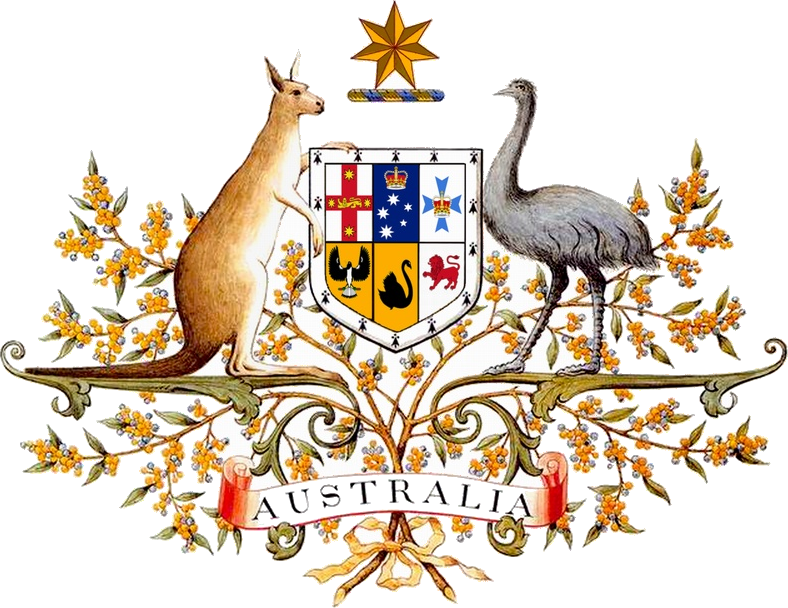 The Crown
Disinterested in protecting Australian wildlife
The kangaroo and emu images are but token symbolism The Crown
Disinterested in protecting Australian wildlife
The kangaroo and emu images are but token symbolism
.
[5] The Wombat Foundation
^http://www.wombatfoundation.com.au/
.
<<The Wombat Foundation is a charitable organisation set up to support activities that aim to bring the Northern Hairy-nosed Wombat back from the brink of extinction.
The Northern Hairy-nosed Wombat is one of the world’s most endangered species – it is more endangered that the Panda.
In the 1980s, there were as few as 35 wombats remaining on the planet – all at Epping Forest National Park in central Queensland. A second population was established at Richard Underwood Nature Refuge in southern Queensland in 2009. At last count, in 2010, there were a total of 176 wombats across the two sites. Since then, the population has continued to grow: in 2012, the combined population at the two sites was estimated at 200 wombats. >>
.
[6] Wombat Awareness Organisation
^http://wombatawareness.com/
.
<<We are a charity established to help save the Southern Hairy-nosed Wombat (Lasiorhinus latifrons) from extinction.
The wombat is an Aussie icon but few people are aware of the peril these gorgeous little animals face: drought, floods, climate change, disease, vehicular incidents and culling – both legal and illegal. It’s not rocket science to see these animals are in trouble but thanks to the work of WAO volunteers, there is hope!
Currently, the wombats are being affected by an unidentified disease outbreak. The visual symptoms are hair loss and emaciation, internally the wombats are anemic and in some cases there is liver damage and heart disease. The direct cause is unknown however it is suspected that due to an increase in weeds there is a decrease in food availability therefore the wombats are forced to eat what they can most of which unfortunately is toxic. >>
.
[7] WIRES
NSW Wildlife Information, Rescue and Education Service Inc.
^http://www.wires.org.au/
.
[8] Rocklily Wildlife Refuge
Taralga, NSW, ^ http://rocklilywombats.com/blog/rocklily-history/
.
<<This website is about Rocklily Wildlife Refuge, and a few other wildlife carers we know in Australia too. Providing a safe place for our native flora and fauna and the various wildlife projects we are undertaking can be an expensive business, so we sell reasonably priced, quality Australian-made gifts and artisan products to raise money for our wildlife projects.
..This website has come about with our move to Rocklily Wildlife Refuge: a safe place for wild native animals just inside the SW border of the Greater Blue Mountains National Park, and within the locked gate of the Sydney Water Catchment. >>
.
[8] Healesville Sanctuary
^http://www.zoo.org.au/healesville
.
<<Healesville Sanctuary, or the Sir Colin MacKenzie Fauna Park, is a zoo specializing in native Australian animals. It is located at Healesville in rural Victoria, Australia (east of Melbourne), and has a rare history of successfully breeding Australia’s native animals.
.
[9] People for the Ethical Treatment of Animals (PETA)
^http://www.petafoundation.org/
.
[10] Voiceless, The Animal Protection Institute
Paddington, New South Wales
^https://www.voiceless.org.au/the-issues/animal-sentience
.
[11] The Cambridge Declaration on Consciousness
.
‘The Cambridge Declaration on Consciousness’, 20120707, by Philip Low, Paper presented at the Francis Crick Memorial Conference on Consciousness in Human and Non-Human Animals, Churchill College, University of Cambridge, England, ^http://fcmconference.org/img/CambridgeDeclarationOnConsciousness.pdf
<< In 2012, an international group of eminent neuroscientists signed The Cambridge Declaration on Consciousness, which confirmed that many animals, including all mammals and birds, possess the “neurological substrates that generate consciousness.” >>
.
.
[12] The Baby Boomers Who Destroyed the World
.
‘The Baby Boomers Who Destroyed the World’, 20110218, by Karlsie, in Subversify, ^http://subversify.com/2011/02/18/the-baby-boomers-who-destroyed-the-world/]
.
[13] Mount Wilson Property Prices
^http://reareports.realestate.com.au/house_prices_growth_rates/nsw/mount_wilson/2786
.

..
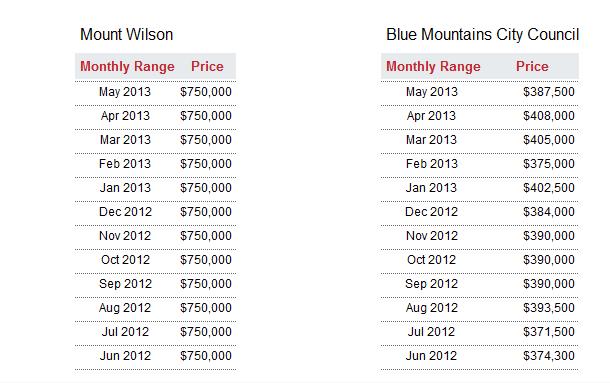 . .
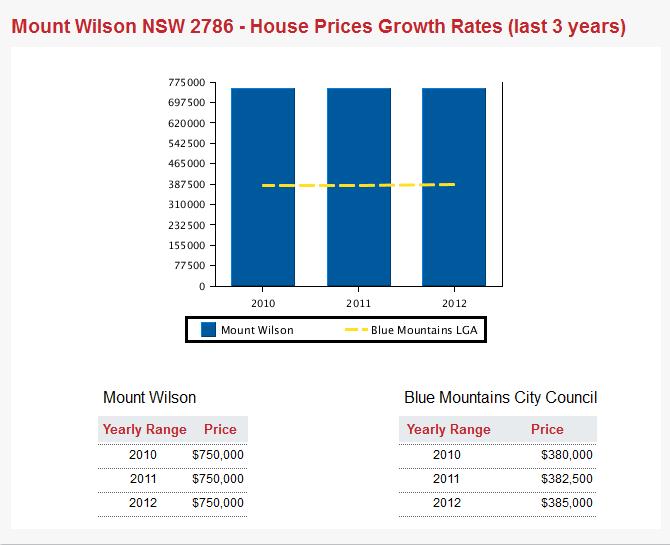 . .
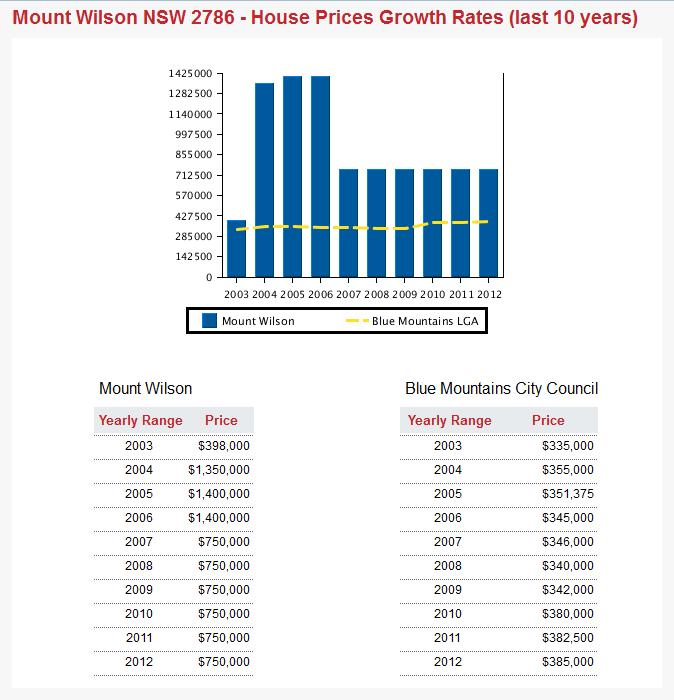 . .
.
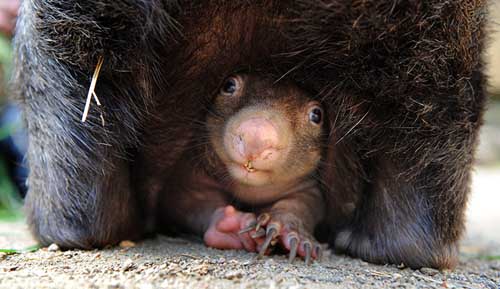
2013 Price?
.
Tags: Anglicising, animal cruelty, Animal Cruelty Syndrome, Animal Harm, Bare-Nosed Wombat, Blue Mountains, Coarse-Haired Wombat, Common Wombat, Living with Wombats, Martin Bryant, Mount Wilson, Mount Wilson Property, Mount Wilson Property Prices, Mount Wilson Real Estate, Mt Wilson, national parks and wildlife act, NSW National Parks and Wildlife Service, sentient, Wombat Gate, Wombat Habitat, wombat poisoned, Wombat Protection
Posted in Blue Mountains (AU), Threats from Development, Threats from Poaching and Poisoning, Wombats | 1 Comment »
Add this post to Del.icio.us - Digg
Friday, June 21st, 2013
Ed: This article was submitted by E. R. Bendall 20130614.
Likewise, we encourage genuine environmentalists to contact us at The Habitat Advocate about submitting articles to us concerning impacts and threats upon wildlife and wildlife habitat.
.
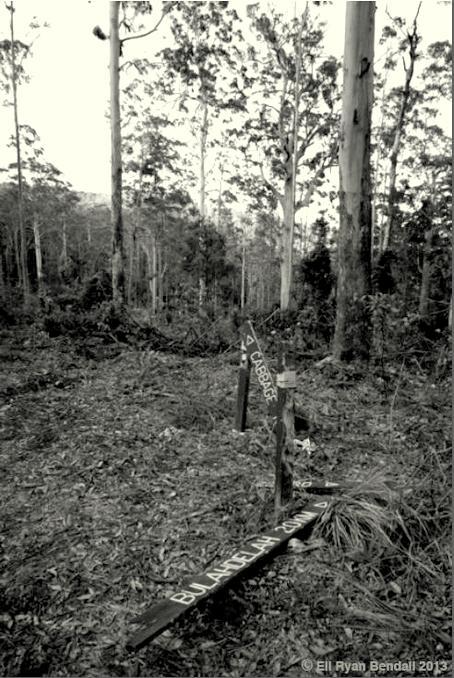 Ed: Exploitative 19th C timbergetters still prevail across New South Wales
They kill and steal the last Old Growth trees.
They deny endangered wildlife the last fragmented vestiges of temperate forest habitat
Across New South Wales, they are the Forestry Corporation of NSW
And their Forest Annihilation is being funded by state taxpayers. Ed: Exploitative 19th C timbergetters still prevail across New South Wales
They kill and steal the last Old Growth trees.
They deny endangered wildlife the last fragmented vestiges of temperate forest habitat
Across New South Wales, they are the Forestry Corporation of NSW
And their Forest Annihilation is being funded by state taxpayers.
.
<<Several large tree specimens, remnants from a time long past, remain standing in New South Wales, Australia.
They are often trees that were spared from logging due to being of a shape not suitable or impractical to remove. They are often surrounded by secondary forest that is State owned and is still being logged.
.
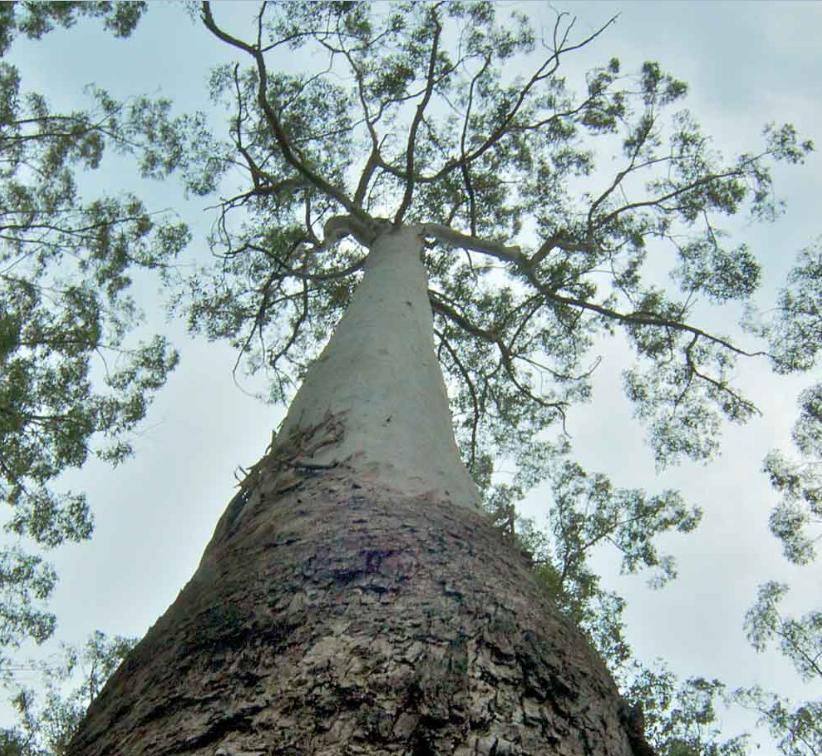 The magnificent Blue Gum (Eucalyptus saligna)
These native trees can reach up to 65 metres (213 feet) in height
Valued and protected in the Myall Lakes NP, but logged for flooring in the nearby Myall River State Forest
(click image to enlarge) The magnificent Blue Gum (Eucalyptus saligna)
These native trees can reach up to 65 metres (213 feet) in height
Valued and protected in the Myall Lakes NP, but logged for flooring in the nearby Myall River State Forest
(click image to enlarge)
.
Due to the destructive and unsightly nature of logging in native forests, incentives given to the public by the State to visit them are often not exciting, their facilities rudimentary and their roads difficult to navigate and/or impassable. The general public is blissfully unaware of what happens in NSW State Forests.
It is not an accident that our most valuable timber and productive forests are not protected and are located adjacent to our National Parks, giving the illusion that something has been done to conserve nature.
.
“I’m not sure if NSW Forestry (Corporation) gives licences to contractors to log areas, but I would say it’s possible given that they ran over their own signage (Myall River State Forest).
It is a state owned ‘State Forest’ squashed between a section of Myall Lakes National Park and Ghin Doo-Ee National Park, about 40 mins drive (north east) from (the township of) Bulahdelah. Easily accessible with a 4WD along Cabbage Tree Road, although the other entrances to the area from the west and north are impossible due to missing bridges/road, etc.”
~ E. R. Bendall
.
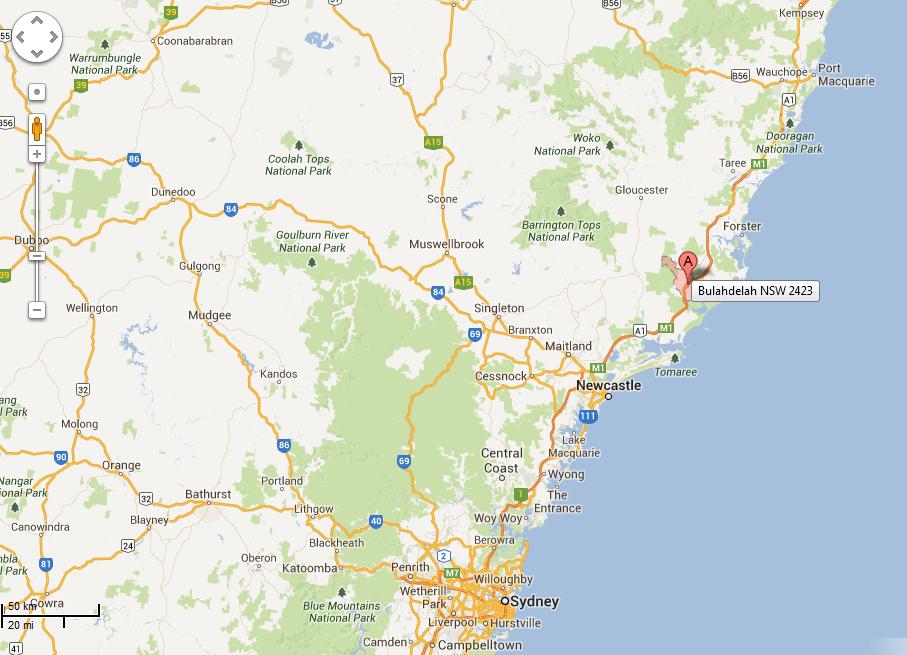 Bulahdelah Location Map
(Click image to enlarge)
[Source: Google Maps]
Bulahdelah Location Map
(Click image to enlarge)
[Source: Google Maps]
.
While Australians point the finger at our overseas neighbours over the logging of their ancient forests, time slips by and nobody notices what is happening in our own backyard.
Each day we lose another piece of our Primary Forest (less than 8% of pre-European level remains), yet no one in an office block thinks twice about the printing of that paper or where it may have come from.
Where exactly does it come from?
Ask yourself that question in every regard and every aspect of your life. Don’t ignore anything.
Are you willing to go out there and have a look for yourself what is happening in our own bush?
The Wild still exists! >>
.
 Myall River State Forest currently being logged
Myall River State Forest currently being logged
Bulahdelah NSW
A continuous canopy 50-75m high, 400-500 year old eucalyptus trees, with dense rainforest understorey, critical habitat for the Tiger Quoll and the Sooty Owl,
in the process of being stripped and logged, with nearly all remaining trees marked for logging (2012).
.
Friday, June 14th, 2013
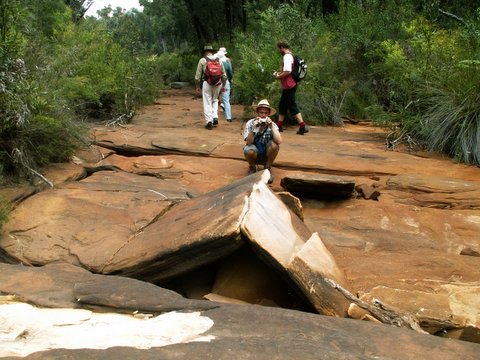 Longwall Mining is permanently destroying to rivers of the Illawarra.
Waratah Coal, owned by Clive Palmer, wants more mining there. Longwall Mining is permanently destroying to rivers of the Illawarra.
Waratah Coal, owned by Clive Palmer, wants more mining there.
.
Waratah Rivulet is a stream that is located just to the west of Helensburgh (55km south of Sydney) and flows into the Woronora Dam. Along with its tributaries, it makes up about 29% of the Dam catchment.
The Dam provides both the Sutherland Shire and Helensburgh with drinking water. The Rivulet is within the Sydney Catchment Authority managed Woronora Special Area.
There is no public access without the permission of the SCA. Trespassers are liable to an $11,000 fine. Yet mining companies are authorised to destroy complete river systems.
.
Longwall Mining under Waratah Rivulet
.
<<Metropolitan Colliery operates under the Woronora Special Area. Excel Coal operated it until October 2006 when Peabody Energy, the world’s largest coal mining corporation, purchased it. The method of coal extraction is longwall mining.
Recent underground operations have taken place and still are taking place directly below the Waratah Rivulet and its catchment area.
In 2005 the NSW Scientific Committee declared longwall mining to be a key threatening process. The Waratah Rivulet was listed in the declaration along with several other rivers and creeks as being damaged by mining. No threat abatement plan was ever completed.
In September 2006, conservation groups were informed that serious damage to the Waratah Rivulet had taken place. Photographs were provided and an inspection was organised through the SCA to take place on the 24th of November.
On November 23rd, the Total Environment Centre met with Peabody Energy at the mining company’s request. They had heard of our forthcoming inspection and wanted to tell us about their operation and future mining plans. Through a PowerPoint presentation they told us we would be shocked by what we would see and that water had drained from the Rivulet but was reappearing further downstream closer to the dam.
The inspection took place on the 24th of November and was attended by officers from the SCA and DEC, the Total Environment Centre, Colong Foundation, Rivers SOS and two independent experts on upland swamps and sandstone geology.
We walked the length of the Rivulet that flows over the longwall panels. Although, similar waterways in the area are flowing healthily, the riverbed was completely dry for much of its length. The cracking of the sandstone streambed caused is typical of that caused by longwall mining in the Southern Coalfield. The SCA officers indicated that at one series of pools, water levels had dropped about 3m. We were also told there is anecdotal evidence suggesting the Rivulet has ceased to pass over places never previously known to have stopped flowing.
The whole watercourse, where the coal has been extracted by the longwall machine, has tilted to the east as a result of the subsidence and upsidence. Rock ledges that were once flat now sloped. Iron oxide pollution stains in the streambed were also present. The SCA also told us that they did not know whether water flows were returning further downstream. There was also evidence of failed attempts at remediation with a distinctly different coloured sand having washed out of cracks and now sitting on the dry river bed or in pools.
Also undermined was Flat Rock Swamp at the southernmost extremity of the longwall panels. It is believed to be the main source of water recharge for the Waratah Rivulet. It is highly likely that the swamp has also been damaged and is sitting on a tilt.
The longwall panels that have damaged the river are LW 8-13. These pre-dated the new approvals process that came into force in 2004. A Subsidence Management Plan for LW 14-17 was recently approved by the DPI and LW 14 is currently being mined. The SMP states that land above LW 8-13 had subsided about 1.3m on average and that there has been no significant impact upon net flow or water quality.
The Total Environment Centre has applied under FOI legislation to the SCA for documents that refer to the damage to the Waratah Rivulet.
During the meeting with Peabody on 23rd November, the company stated its intentions sometime in 2007 to submit a 3A application under the Environmental Planning &Assessment Act 1974 to extract a further 27 longwall panels that will run under the Rivulet and finish under the Woronora Dam storage area.
This is very alarming given the damage that has already occurred to a catchment that provides the Sutherland Shire & Helensburgh with 29% of their drinking water. The dry bed of Waratah Rivulet above the mining area and the stain of iron oxide pollution may be seen clearly through Google Earth.>>
.
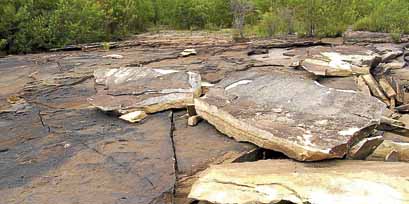 Damaged: Cracked rocks along the Waratah Rivulet
[Source: Photo by Peter Turner, 20120528
^http://www.theleader.com.au/story/266961/fears-for-ruined-water-source/] Damaged: Cracked rocks along the Waratah Rivulet
[Source: Photo by Peter Turner, 20120528
^http://www.theleader.com.au/story/266961/fears-for-ruined-water-source/]
.
Longwall Mining under or close to Rivers and Streams
.
<<Seven major rivers and numerous creeks in NSW have been permanently damaged by mining operations, which have been allowed to go too close to, or under, riverbeds. Some rivers are used as channels for saline and acid wastewater pumped out from mines.
Many more are under threat. The Minister for Primary Industries, Ian Macdonald, is continuing to approve operations with the Department of Planning and DEC also involved in the process, as are a range of agencies (EPA, Fisheries, DIPNR, SCA, etc.) on an Interagency Review Committee. This group gives recommendations concerning underground mine plans to Ian Macdonald, but has no further say in his final decision. A document recently obtained under Freedom of Information rights by Rivers SOS shows that an independent consultant to the Interagency Committee recommended that mining come no closer than 350m to the Cataract River, yet the Minister approved mining to come within 60m.
The damage involves multiple cracking of river bedrock, ranging from hairline cracks to cracks up to several centimetres wide, causing water loss and pollution as ecotoxic chemicals are leached from the fractured rocks. Aquifers may often be breached. Satisfactory remediation is not possible. In addition, rockfalls along mined river gorges are frequent.
The high price of coal and the royalties gained from expanding mines are making it all too tempting for the Iemma (Labor NSW) Government to compromise the integrity of our water catchments and sacrifice natural heritage.>>
.
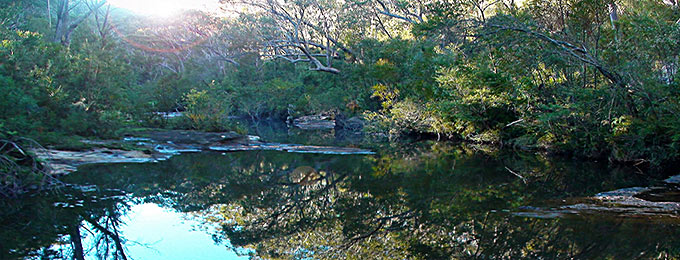
.
Longwall Mining in the Catchments
.
<<Longwall coal mining is taking place across the catchment areas south of Sydney and is also proposed in the Wyong Catchment.
A story in the Sydney Morning Herald in January 2005 stated that the Sydney Catchment Authority was developing a policy for longwall coal mining within the catchments that would be ready by the middle of that year. This policy is yet to materialise.
The SMP approvals process invariably promises remediation and further monitoring. But damage to rivers continues and applications to mine are approved with little or no significant conditions placed upon the licence. Remediation involves grouting some cracks but cannot cover all of the cracks, many of which go undetected, in areas where the riverbed is sandy for example. Sometimes the grout simply washes out of the crack, as is the case in the Waratah Rivulet.
The SCA was established as a result of the 1998 Sydney water crisis. Justice Peter McClellan, who led the subsequent inquiry, determined that a separate catchment management authority with teeth should be created because, as he said “someone should wake up in the morning owning the issue” of adequate management.
An audit of the SCA and the catchments in 1999 found multiple problems including understaffing, the need to interact with so many State agencies, and enormous pressure from developers.
Developers in the catchments include mining companies. In spite of government policies such as SEPP 58, stating that development in catchments should have only a “neutral or beneficial effect” on water quality, longwall coal mining in the catchments have been, and are being, approved by the NSW government. Overidden by the Mining Act 1992, the SCA appears powerless to halt the damage to Sydney’s water supply.>>
.
[Source: ‘Waratah Rivulet – The death of a river system from mine subsidence’, by Australian Coal Alliance, ^http://australiancoalalliance.com/waratah_rivulet.htmhttp://australiancoalalliance.com/waratah_rivulet.htm]
.
Clive Palmer’s Waratah Coal
.
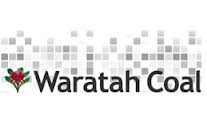
.
<<Waratah Coal is an exploration and coal mine development company which is a wholly owned subsidiary of Mineralogy Pty Ltd.
Formed in 2005 and based in Brisbane, Waratah Coal is focused on the exploration and development of coal projects in Australasia. Along with another Mineralogy subsidiary, Galilee Pty Ltd, Waratah Coal proposes an $8 billion coal mine and infrastructure project in the Galilee Basin in Central Queensland.
The Galilee Coal Project includes a large scale thermal coal mine near Alpha, west of Emerald. The complex will include four underground mines, two surface mines and associated coal handling and processing facilities. The mine will be linked to a new coal terminal at Abbot Point near Bowen by a new 471km standard gauge, heavy haul railway line.
The Galilee Project and Waratah’s Galilee Power project have both been granted ‘significant project’ status by the Coordinator-General of Queensland in November, 2008, and September, 2009, respectively.
After being listed on the Toronto Stock Exchange and later the Australian Stock Exchange, Waratah Coal in December, 2008, accepted an offer from Mineralogy Pty Ltd for a controlling stake in the company.
Waratah Coal became part of the Mineralogy Group and the company is 100 per cent owned by Mineralogy Pty Ltd. The Mineralogy Group and associated entities have 25 years’ experience developing, managing, and funding a range of major projects. Mineralogy Group has a current market capitalisation of approximately $11 billion.
The Group currently employs around 2,200 Queenslanders in its activities in the state. Through its diversified interests (which includes the $6 billion Yabulu Nickel refinery in Townsville, oil and gas exploration in Papua New Guinea and the $5 billion Sino Iron magnetite iron ore development in Western Australia) the Group has formed major international alliances in China and domestically.>>
.
[Source: Waratah Coal, ^http://www.waratahcoal.com/corporate-profile.htm]
.
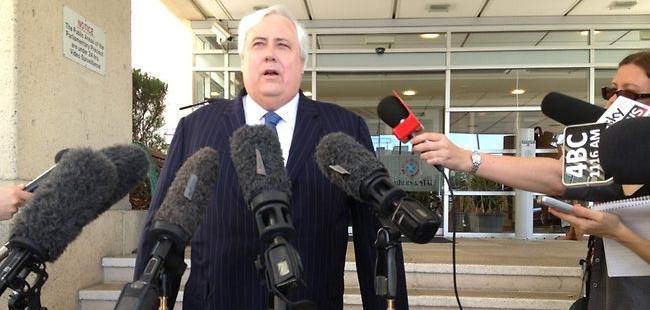
Waratha Coal’s Executive Chairman, Clive Palmer
..
Mining Jobs, Jobs, Jobs?
.
<<Waratah Coal believes that outstanding staff are a vital key to its success as an organisation and is committed to providing a rewarding and challenging environment for its staff.
Current Roles available at Waratah Coal: “There are currently no positions available.”>>
.
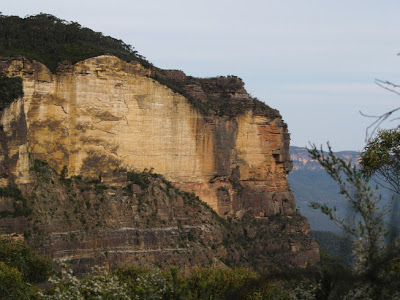 The Jamison Valley Landslide
Blue Mountains Mining Legacy of Katoomba Colliery The Jamison Valley Landslide
Blue Mountains Mining Legacy of Katoomba Colliery
.
.
Further Reading
.
[1] 2010: BHP Billiton threatens Dharawal Swamps and Rock Art
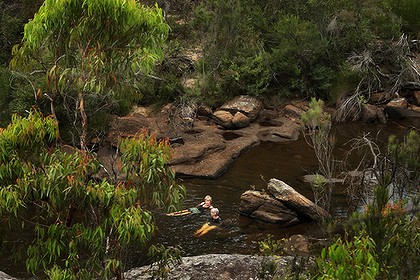 Possibly the cleanest water in New South Wales
Cobong Swim Hole in O’Hares Creek in the Dharawal State Conservation Area
Photo by Kate Geraghty Possibly the cleanest water in New South Wales
Cobong Swim Hole in O’Hares Creek in the Dharawal State Conservation Area
Photo by Kate Geraghty
.
<<A vast new coalmine planned for Sydney’s south-western outskirts will damage the city’s natural desalination plant – the ”hanging swamps” that filter pure water down into the Georges River.
More than 50 swamps in the little-known Dharawal State Conservation Area, south-east of Campbelltown, will be undercut by longwall coalmines, which the mine owner, BHP Billiton, admits are likely to crack the bedrock and drain swamps. Aboriginal rock art above the mine site is also at risk.
The proposal, being considered by the NSW Government, calls for a huge expansion of existing coalmines near Appin, which would lock in mining there for 30 years.Opposition to the plan is growing, and a coalition of local residents and environment groups and the National Parks Association are calling for mining to be excluded from the conservation area.
”It is literally underground and metaphorically under the public radar,” said Sharyn Cullis of the Georges River Environmental Alliance. ”There should be widespread outrage or, at the very least, public debate about whether we really want the landscape desiccated … sacrificed for the sake of coal.
”The hanging swamps are shallow sandstone bowls, packed with matted sedge, native grasses and banksias that act like a sieve and a sponge, holding water in dry times and allowing it to seep out and feed some of the state’s cleanest creeks.
”I would rather they mined under my own house than in the conservation area,” said Julie Sheppard, of environment group Rivers SOS, whose home lies above another planned longwall panel near Appin.
O’Hares Creek, which flows through the conservation area and provides more than two-thirds of the water to the Georges River, is itself fed by the swamps.
”A total of 226 swamps have been identified within the entire Bulli seam project area, of which the Dharawal State Conservation Area is a part,” a BHP Billiton spokeswoman said in a statement.
”There is some potential for impact but a monitoring and management plan has been developed.
”The company said its plans had been designed to minimise impact on larger rivers.”Illawarra Coal has not mined directly beneath rivers since 2002, and consistent with this commitment, we have positioned longwalls away from major rivers and streams in the Bulli seam project.
”A detailed study by the staff at the NSW Department of Environment and Climate Change found the swamp network to be a ”priority fauna habitat” for several endangered species, including the ground parrot and the giant burrowing frog.
The area also contains dozens of Aboriginal sites.”Once you take the coal away, there’s nothing to support the sandstone, and our artwork is cracking,” said Alan Carriage, an elder of the Wadi Wadi people.
A June 2009 report produced by Biosis Research for BHP Billiton found that 11 Aboriginal rock art sites in the southern coalfields had already been damaged by subsidence from longwall mining. But hypocritically and consistent with darkside consultants who will say anything for a buck concluded that “overall there is a low risk of significant impact to Aboriginal cultural heritage values”.
Before damaging a recognised Aboriginal site, a mining company must obtain a “permit to destroy” under the NSW heritage protection system. However Bev Manton, of the NSW Aboriginal Land Council, dismissed this process as a “regime to manage destruction”.
She said five permits allowing damage to Aboriginal heritage sites are being issued a week by the State Government, and called for a new regime that gives more power to Aborigines to protect their significant sites.>>
.
[Source: ‘Mining ‘threat to swamps and rock art’, 20100130, Ben Cubby with Andrew Small, Sydney Morning Herald, ^http://www.smh.com.au/environment/mining-threat-to-swamps-and-rock-art-20100129-n48w.html]
.
.
[2] 2012: Apex Energy’s coal seam gas threatens Sydney’s drinking water
.
<<A coal seam gas company’s bid to save its Illawarra exploration project has triggered a flood of community opposition and again raised fears about mining in the water catchment.
Apex Energy’s approval for a 16-borehole exploration project around Darkes Forest and Maddens Plains expires tomorrow.
Planning authorities are now considering its application to extend the expiry date for three years after the first borehole is drilled, effectively allowing an indefinite extension as no start date is listed.
Despite the fact the project itself has not changed, the application generated 129 public submissions plus another 16 from groups including Stop CSG Illawarra and the National Parks Association.
Last year, Apex’s application for the 16th borehole received 1045 submissions from the public. The scrutiny reflects the depth of community concern about environmental risks linked to CSG, and the political heat the O’Farrell government faces over it.
By comparison, coal company Gujarat NRE’s application to expand its mine and open a new longwall beneath the water catchment only received 23 public submissions and two from interest groups.Stop CSG Illawarra spokeswoman Jess Moore put the difference down to greater community awareness about Apex’s project and its threat to the catchment.‘‘It’s outrageous that I can be fined up to $44,000 for walking in the catchment yet the government will allow CSG development in that area,’’ she said.Gujarat’s proposal faced harsher criticism from government agencies than Apex’s, which is located partly in the water catchment and is still at the exploration stage.Further approvals would be required before production.Wollongong City Council opposed Apex’s time extension, saying even with stringent environmental controls it would be hard to argue CSG activities would have only a neutral or beneficial effect.The Office of Environment and Heritage said it would be ‘‘unlawful’’ to drill the three proposed boreholes in the national park.Apex’s application said more than 10,000 boreholes had been drilled in the southern Sydney basin during the Illawarra’s long mining history, but only 50 exploration boreholes had been drilled by the coalmining industry in the timeframe they had followed.An independent panel will determine the application. A spokesman for Planning Minister Brad Hazzard said the government’s new Strategic Regional Land Use Policy applied Australia’s ‘‘toughest protections and regulations’’ to CSG mining. .
[Source: ‘ Opposition grows to coal seam gas bid in Sydney’s drinking water catchment’, 20120921, ^http://coalseamgasnews.org/news/world/australia/nsw/opposition-grows-to-coal-seam-gas-bid-in-sydneys-drinking-water-catchment/]
.
.
[3] 2012: Peabody Energy’s Longwall Mining irreversibly cracking riverbed – government turns a blind eye
.
<<Sutherland Shire (New South Wales) environmentalists are calling on Peabody Energy to release information on the state of the Waratah Rivulet, which supplies drinking water to the Woronora Dam. They claim the company has failed to divulge the success or failure of its attempts to remediate the damaged riverbed.
The rivulet, which is in the Woronora special area and off-limits to the public, first hit the news in 2007 when cracks were discovered in the riverbed and some its waters disappeared underground. The damage was blamed on longwall coal mining underneath the riverbed undertaken by the Peabody-owned Metropolitan Colliery.
The National Parks Association of NSW has released a video documenting a visit to the rivulet by a group of environmentalists and Greens MP Jeremy Buckingham six months ago.
It shows unremediated cracks, as well as some of Peabody’s remediation attempts.
Nationa Parks Association Southern Sydney Branch Secretary, Gary Schoer:
“No one has been able to find out if the damage to the rivulet was ongoing or if remediation was actually working. When we visited we found out the remediation is still proceeding,” Mr Schoer said. “We saw many cracks which had not yet been filled. But we don’t know how extensive the damage is, or how successful the remediation is. The NPA has been trying to meet with Peabody for the past six months.”
.
Peabody Energy, NSW Environment Minister Robyn Parker and NSW Primary Industries Minister Katrina Hodginkinson, who is responsible for the Sydney Catchment Authority have all declined to comment.
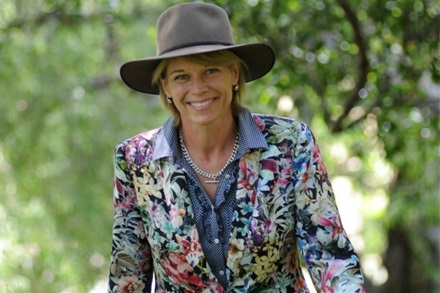 Turning a blind eye
Katrina Hodginkinson Turning a blind eye
Katrina Hodginkinson
.
Georges River Environmental Alliance Secretary Sharyn Cullis, who visited the rivulet with Mr Schoer:
“What I saw on a tour of inspection, inside what is supposed to be a protected catchment, really horrified me.
The riverbed of the Waratah Rivulet was smashed. What should have been clear, clean water in the stream, which is 30 per cent of the inflow into the (Woronora) dam, was a murky orange brown. What should have been drinking water didn’t look fit for a dog to drink.
Remediation attempts so far appeared to be “futile”.
.
Gary Schoer said tests conducted by environmentalists had confirmed chemical changes to the water which flowed through the damaged areas of the rivulet, but said he did not know, and had been unable to find out, how much of this water was flowing into the Woronora Dam.
Should there be greater protection for the rivulet? >>
.
[Source: ‘Fears for ruined water source’, 20120528, by Kate Carr, The Leader newspaper, St Georgeand Sutherland Shire, ^http://www.theleader.com.au/story/266961/fears-for-ruined-water-source/]
.
.
[4] 2013: BHP Billiton’s Illawarra Longwall Coal Mine threatens stream subsidence
.
 Ed: In what? Ed: In what?
.
<<An Illawarra Coal mine plan could cause significant cracking in parts of the Upper Nepean swampland leading to surface water loss, a Sydney Catchment Authority submission states.
The bulk of Macarthur’s drinking water is sourced from these catchments, where Illawarra Coal is proposing to operate a new underground coalmine, seven kilometres west of Port Kembla.
In its submission to the Planning Department, the Sydney Catchment Authority said: “Significant cracking is predicted that would lead to diversion of surface stream flow . . . resulting in surface water loss.”
An Illawarra Coal spokeswoman said BHP Billiton had been successfully mining at Dendrobium without any significant environmental impacts since the NSW Government approved mining in the area in 2001.
“Illawarra Coal has modified its mine plan to avoid significant impacts to key environmental features in the area such as Avon Dam and Wongawilli Creek,” she said.
“Illawarra Coal has developed a mine plan which has our longwall blocks positioned well away from the full supply level of Avon Dam and several kilometres away from the dam wall. We have no evidence of impacts to the dam.”
The National Parks Association has expressed fears Macarthur’s water catchments are under threat from the mine plan and called for a “rejig” of the longwall layouts to avoid damaging the swampland.
Illawarra Coal was granted conditional approval for the Dendrobium project in 2001 but is now seeking approval for its subsidence management plan to move into Area 3B.
National Parks Association spokeswoman Julie Sheppard said measures should be put in place to avoid harming an important part of the catchment.
The Sydney Catchment Authority, in its submission, recommends more stringent conditions be placed on the subsidence management plan.
The NSW Department of Urban Affairs and Planning says the Dendrobium project expects to extract 5.2 million tonnes of coal a year over 21 years. It also said the project expected to provide up to 261 full-time construction jobs and up to 277 direct jobs during the operational time.>>
.
[Source: ‘Swampland ‘at risk’, 20130122, by Michael Cox, journalist with Wollondilly Advertiser, ^http://www.wollondillyadvertiser.com.au/story/1250517/swampland-at-risk/]
.
.
[5] Rivers SOS
.
In 2005, Rivers SOS (a coalition of 30 groups) formed with the aim of campaigning for the NSW Government to mandate a safety zone of at least 1km around rivers and creeks threatened by mining in NSW. The peak environment groups of NSW endorse this position and it forms part of their election policy document.Rivers SOS, ^http://riverssos.org.au/
.
[6] Stop CSG Illawarra
.
.
[7] Coal Seam Gas News
.
<<The purpose of CoalSeamGasNews.org is to provide quick access to Coal Seam Gas mining news, research, forums and public meeting schedules, provide a voice for the many Australians who want a sustainable mining industry, and to help people get the facts – not myths – about the Coal Seam Gas industry. ^http://coalseamgasnews.org/
.
.
[8] Australian Coal Alliance
^http://australiancoalalliance.com/main.htm
.
.
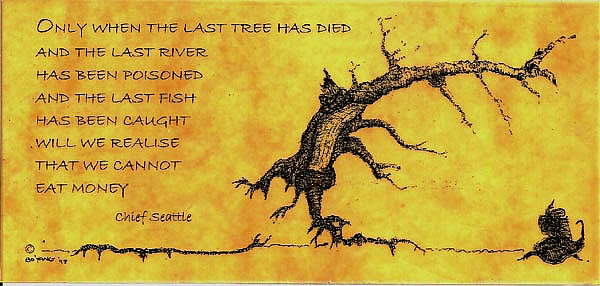 . .
.
Tags: Barry O'Farrell, Clive Palmer, Dharawal State Conservation Area, Ian Macdonald, Illawarra Coal, Katrina Hodginkinson, long wall coal mining, Metropolitan Colliery, O'Hares Creek, Peabody Energy, Subsidence due to longwall mining, Waratah Coal, Waratah Rivulet, Woronora Special Area, Wyong Catchment
Posted in Threats from Mining | 2 Comments »
Add this post to Del.icio.us - Digg
Friday, June 7th, 2013
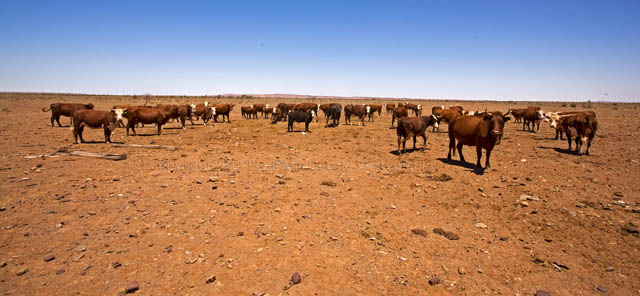 Australian cattle with no pasture, no water, no shade, in baking desert heat.
Typical is the wrath of Northern Australian Cattle Farmers.
Southern Australian Cattle Farmers would never allow this treatment to their prized herds.
Australian cattle with no pasture, no water, no shade, in baking desert heat.
Typical is the wrath of Northern Australian Cattle Farmers.
Southern Australian Cattle Farmers would never allow this treatment to their prized herds.
.
<<The Independent Member for Denison, Andrew Wilkie, has joined Lyn White from Animals Australia ( ^http://www.animalsaustralia.org/ ) to release new footage of cruelty to Australian livestock exported to Egypt and announce another attempt to progress legislation to ban the trade.
Mr Wilkie said his Bill would phase out live exports in three years, as well as immediately impose mandatory stunning of Australian livestock slaughtered overseas.
Mr Wilkie:
“The live export industry is systemically cruel, opposed by the vast majority of Australians and not in our economic interests. This latest evidence of horrific animal cruelty in Egypt demonstrates that this trade will never have appropriate animal welfare outcomes and must be stopped.
I have given formal notice of my intention to introduce the Live Animal Export (Restriction and Prohibition) Bill 2013 into Federal Parliament. A similar Bill was rejected by the Government and Opposition in August 2011. Since then we have seen shocking evidence of more live export cruelty in Kuwait, Pakistan, Israel, Egypt and Indonesia.
It is my hope that the Government and Opposition will now see sense and support the end of this cruel trade.”>>
.
[Source: ‘New footage of cruelty to Australian livestock’, by Andrew Wilkie MP, Independent Member for Denison MR, 20130516, Tasmanian Times, ^http://tasmaniantimes.com/index.php?/article/new-footage-of-cruelty-to-australian-livestock/]
.
.
[Source: Animals Australia, ^http://www.animalsaustralia.org/take_action/cattle-cruelty/]
.
Outback Marginal Grazing is Unviable
.
- Outback Queensland depends upon the inflated outback cost of diesel to freight cattle hundreds of kilometres to abattoirs or to port for live export
- Australia’s native northern has since colonial times been abused, overgrazed, broadscale burned uncontrollably until the savannah has become desert
- Seasonal drought has struck northern Australia’s savannah yet again, like in 2011 and many times prior – nothing new there.
- Greedy cattle farmers have built up excess herds, creating over-supply in cattle at meatworks, meaning cattle prices have plummeted below the cost of getting them to market
- Indonesia’s live export market was always a short term option as Indonesia built its own herds to a point of self-sufficiency – no news there
- Starved cattle stock with visible bony ribs are currently selling for $20 a head at Longreach. It happened before in the 1974 beef crash – no lessons learnt from that.
- Western Queensland land values have slumped and northern and western Queensland stations — like their excess cattle — are virtually impossible to sell
- Australia’s rural sector is now weighed down with $66 billion of combined debt, many cattle farmers are in a debt crisis and marginial equity in properties
- Bankers are now starting to call in debts, especially in the north, triggering a new round of station sales and mortgagee auctions.
- Three of Australia’s biggest cattle companies, Macquarie Agricultural Fund’s Paraway Pastoral, the stock-exchange listed Australian Agricultural Company and North Australian Pastoral Company have already written down the value of their vast portfolios by a combined $80m.
- AACo announced yesterday that fast-falling cattle prices had forced a $43m writedown of the value of its 600,000-head herd.
- The Cattle Council of Australia yesterday warned that this week’s disastrous $20-a-head sale prices had created a critical situation.
- “These prices are indicative of the critical conditions our northern producers are experiencing; unseasonably dry conditions, suppressed market conditions and the continued fallout from the live trade suspension,” CCA president Andrew Ogilvie said. “I fear that the situation will continue to get worse.”
- A survey by rural bankers Rabobank this week reflected widespread fears of approaching drought. It showed 37 per cent of farmers had lost confidence in the future and expect the next year ahead to be tougher than the past 12 months. About one third expect to suffer a fall in income in 2013-14.>>
.
[Source: ‘Drought stalks the land again’, by Sue Neales, Rural reporter, The Australian newspaper, 20130504, ^http://www.theaustralian.com.au/news/nation/drought-stalks-the-land-again/story-e6frg6nf-1226634963784]
.
Ain’t a farmer’s duty to leave a place better than how one found it?
.
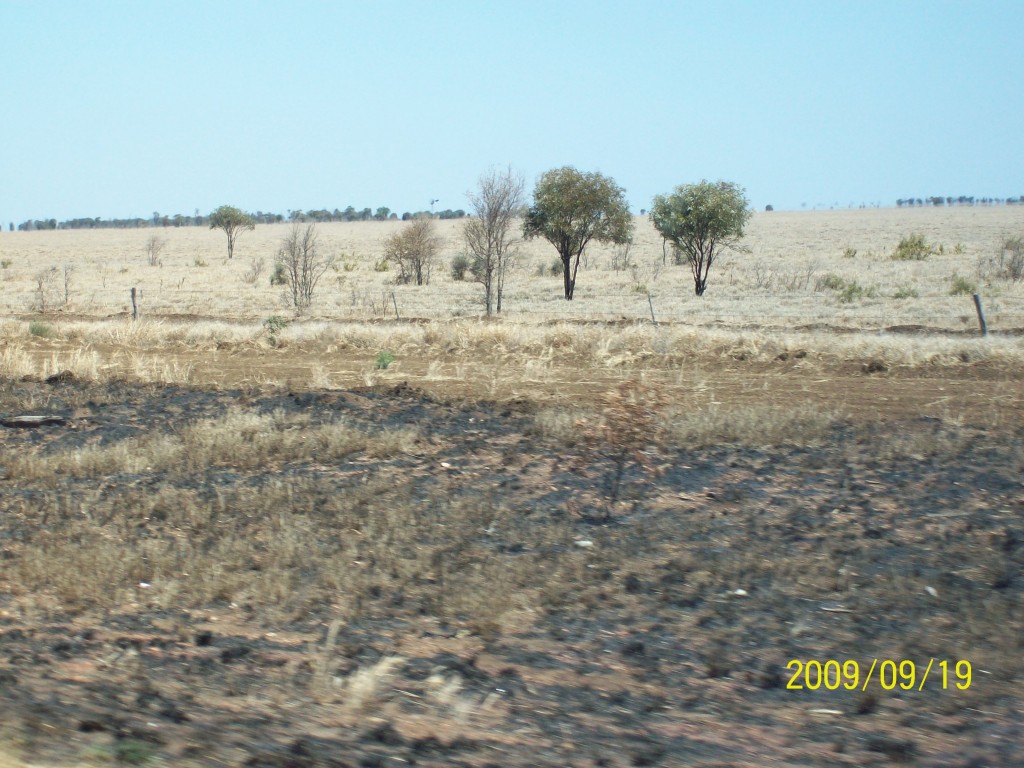 Not looking good.
Generations of Cattle Overgrazing of Australia’s Northern Savannah has decimated it to desert.
It’s similar to the 1930s dustbowlers of the American midwest; farmers abused the land and now they expect charity?
Snap out of the family history dogma.
While you have life and limb, relocate to reliably greener pastures! Not looking good.
Generations of Cattle Overgrazing of Australia’s Northern Savannah has decimated it to desert.
It’s similar to the 1930s dustbowlers of the American midwest; farmers abused the land and now they expect charity?
Snap out of the family history dogma.
While you have life and limb, relocate to reliably greener pastures!
.
[Ed: A previous image here has been removed by us upon becoming aware of its alleged copyright. We obtained the image from the Internet and there were no copyright notices. We noted multiple copies attributable to different sources. Nevertheless we have removed the image immediately and offer our apologies to the owner/s of the image.]
.
Australian Drought Every Decade
.
Australia is subject to seasonal drought commonly at intervals of 11 to 14 years. This has nothing to do with Climate Change theory. Think more El Niño and the varying Pacific Ocean currents and temperatures. The pattern is historically consistent since at least colonisation and probably through millennia.
Major droughts have included 1803, 1809-10, 1813-15, 1826-29, 1835, 1838-39, 1846, 1849-50, 1864-66, 1868, 1877, 1880-86, 1888, 1902, 1911-15, 1918-20, 1937-47, 1965-68, 1982-83, 1991, 1994-2006, 2013.
Australia is the driest continent on Earth. Don’t rural Australian kids get that drummed into them in primary school? Northern Australia’s vast and dry savannah country, inland and west of the Divide is marginal at best for pasture, let alone cropping. Yet after a few bouts of rain, short term memory kicks in. The marginal farmer’s false hope of good timely rain is legendary chronic folklore full of wishful thinking, short term memory loss and denial of Australia’s weather.
.
Occasional rain has become the Marginal Farmer’s Pyrite – fool farmer’s gold.
.
Overgrazing
.
One of the risks associated with arid and semi-arid grazing systems in particular, is land degradation as a result of overgrazing. Overgrazing can be defined as the practice of grazing too many livestock for too long a period on land unable to recover its vegetation, or of grazing ruminants on land not suitable for grazing as a result of certain physical parameters such as its slope.
Overgrazing exceeds the carrying capacity of a pasture. However there may be other factors involved or contributing to apparent overgrazing such as climate change. Overgrazing often results in soil erosion, the destruction of vegetation, and other problems related to these processes.
.
Overgrazing is repeating the US Dustbowl of the ’30s
.
<<Extensive deep plowing of the virgin topsoil of the Great Plains in the preceding decade had displaced the natural deep-rooted grasses that normally kept the soil in place and trapped moisture even during periods of drought and high winds. Rapid mechanization of farm implements, especially small gasoline tractors and widespread use of the combine harvester, were significant in the decisions to convert arid grassland (much of which received no more than 10 inches (250 mm) of precipitation per year) to cultivated cropland.
During the drought of the 1930s, without natural anchors to keep the soil in place, it dried, turned to dust, and blew away with the prevailing winds>>
.
The glut of unwanted cattle is a symptom of an industry run by incompetents. Cattle farmers who put their trust in government and industry big wigs do so at their peril.
.
Australia has only 6% Arable Land
.
<<The Arable land (% of land area) in Australia was 6.14 in 2009, according to a World Bank report, published in 2010.
Arable Land includes land defined by the Food and Agriculture Organization of the United Nations as ‘land under temporary crops (double-cropped areas are counted once), temporary meadows for mowing or for pasture, land under market or kitchen gardens, and land temporarily fallow‘. Land abandoned as a result of shifting cultivation is excluded.>>
.
[Source: ‘Arable land (% of land area) in Australia’, ^http://www.tradingeconomics.com/australia/arable-land-percent-of-land-area-wb-data.html]
.
.
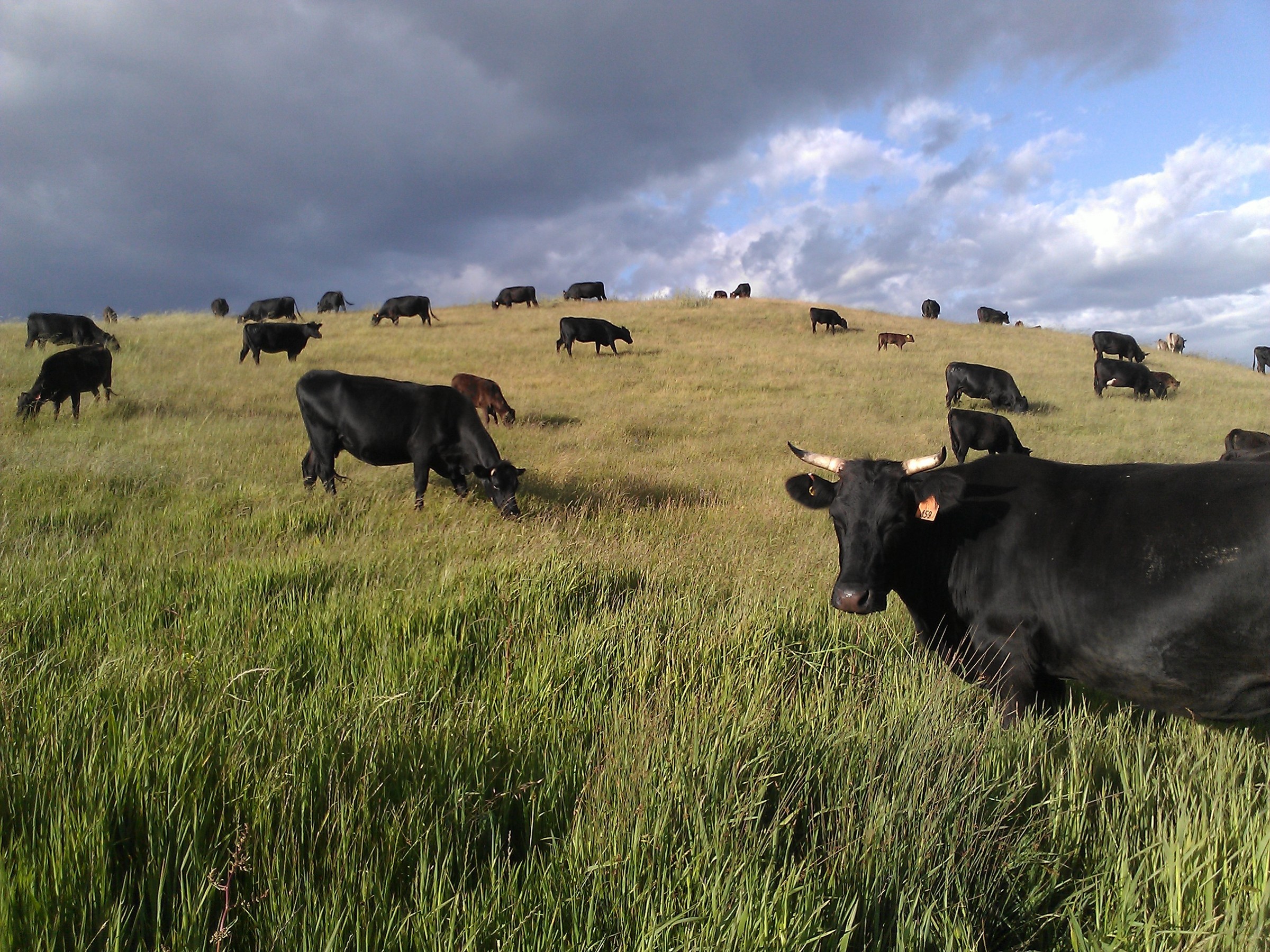 Prime Australian Country for Waygu Beef
Read: ^http://wagyu.une.edu.au/]
Prime Australian Country for Waygu Beef
Read: ^http://wagyu.une.edu.au/]
.
Case Study of Good Rainfall and Sustainable Location
.
Corumbene Brangus Cattle
.
<<At Corumbene Brangus we are dedicated to producing the type of stock that you would be proud to have in your herd. We have taken the time to assess, improve and adapt our breeding herd to the Southern Australian climate and producing cattle of distinction and character that we love.
Our property is situated in the Western District of South West Victoria. We have a high average rainfall of about 30″, with temperature ranging from mid 40’sC (104 Fahrenheit) in summer to low minus in winter. Our pastures are predominately rye and clover kept productive with an extensive pasture renovation and soil conditioning program.
Corumbene Brangus cattle are raised solely on these healthy pastures. Brangus cattle are known for their ability to excel on pasture alone with early finishing and easy fleshing ability no matter what season or time of the year, in all our weather extremes. We calve down during Spring (August-October) each year.>>
.
[Source: Corumbene Brangus, ^http://www.corumbenebrangus.com/cattle.htm]
.
Observations about MLA’s herded strategy for Northern Australia
.
1. Putting all cattle into a single export market to Indonesia is poor strategy – remember that proverb, don’t put all your eggs in one basket – what action has been taken to develop other export markets?
2. Indonesia has long indicated to Australia that it is breeding towards self-sufficiency in its own live cattle supply, so the decrease in live cattle demand was on the cards, to eventually dry up.
3. Northern Australia’s drought and flood cycle is not new. Farmers must have been aware of the likelihood of drought following the floods of the past four years, so why risk excessive stock?
4. Poor quality control of live export to ensure Australian standards were being met was slack. The strategic risk of discovery of cruel abuse of cattle by an Indonesian abattoir was high. So given that risk, the Meat and Cattle Association (MLA) should have been proactive and diligent in ensuring such abuse was not possible. When abuse is systemic it is only a matter of time before it would be publicly exposed. And the likely consequences of a trade shut down would be been reasonably forseeable.
5. Aside from the above live export has an ongoing record or cruelty and abuse under industry self regulation. So it is always going to be high risk from a social stakeholder perspective. Those who live by the sword…
6. In Australia, in any industry – media, agriculture, mining, forestry- self-regulation never works to the standard expected of Australian society.
.
We have no sympathy for the industry. May the northern Australian cattle industry linked to live trade go bankrupt as it morally deserves.
.
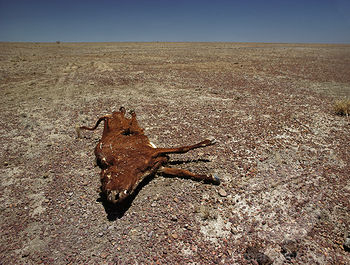 Once a farmer can inflict such upon his stock, he possesses such evil to do so the same to his children
Once a farmer can inflict such upon his stock, he possesses such evil to do so the same to his children
Criminal bastardry deserves criminal justice.

<<She won’t mind if the place we stand is marked by ash.
She believes what doesn’t kill her only takes more time to kill her.
Then she smiles as she paints her lips and does her lashes.
Stunning as a taxidermy victim in a silver cage.
I’m arrested by an aria brought from the country.
Stuck in dumb amazement like a dog who’s told to levitate.
This smash number-one goes to her lover in the belfry,
Singing like a bird in flames and headed for the window pane.
In the coming years, let’s try and milk a fortune off them.
I think we’re qualified by now.
Alouette, gentille alouette.
Head to toe so thoroughly until we’re both dismembered.
Alouette, gentille alouette.
Naá¯ve, yes, but none the worse, spinning glue back into horses.
I’ll never leave the place where you are.
Hand-in-hand into a rented car.
Merrily into the abattoir.
Spilling out all over, I’ll be Noah on the storm.
And two-by-two in love we’ll speed back into bed and never leave it.
In the coming years, let’s try and milk a fortune off them.
I think you’re qualified by now.
Alouette, gentille alouette.
Head to toe so thoroughly until we’re both dismembered.
Alouette, gentille alouette.
Naá¯ve, yes, but none the worse, spinning glue back into horses.
Alouette, gentille alouette.
Head to toe so thoroughly until we’re both dismembered.
Alouette, gentille alouette.
Alouette, gentille alouette.>>
.
[Source: The Pernice Brothers’, Cruelty To Animals’]
.
[Ed: My father’s family heritage was sheep farming in Victoria’s west dry marginal Wimmera and our sheep farming roots extended back to 18th Century England. That tradition ended under tragic circumstances near Stawell in 1942; yet in hindsight, subsequent generations of our family are far better for it. Relocating takes more guts than putting up. Honour is more deserving of our future generation; the oldies should understand.]
.
Tags: animal cruelty, Australian Agricultural Company, Australian livestock, Cattle Overgrazing, Egypt, El Niño, Indonesia, Indonesian abattoirs, Indonesian torture of Australian Cattle, Israel, Kuwait, live cattle trade, Marginal Farmer's Pyrite, Meat and Livestock Association, North Australian Pastoral Company, Northern Australian Savannah, Pakistan
Posted in 53 Animal Welfare!, Threats from Farming | 1 Comment »
Add this post to Del.icio.us - Digg
Friday, May 31st, 2013
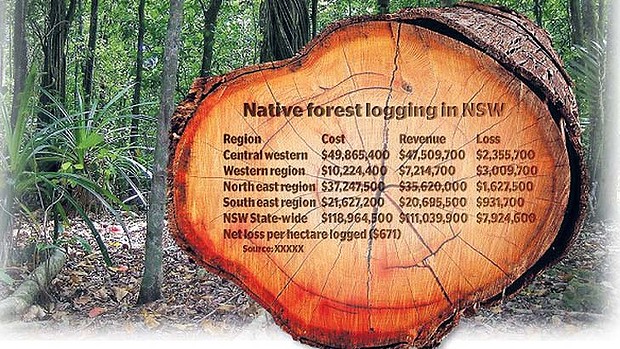 Forests NSW has been rebranded the Forestry Corporation of NSW for what wasteful reason?
It continues to make massive losses and should be wound up, not rebranded.
It destroys native habitat and makes an $8 million annual loss in the process.
This makes forestry not a commerical business, but a Costly Cult of Logging Losers. Forests NSW has been rebranded the Forestry Corporation of NSW for what wasteful reason?
It continues to make massive losses and should be wound up, not rebranded.
It destroys native habitat and makes an $8 million annual loss in the process.
This makes forestry not a commerical business, but a Costly Cult of Logging Losers.
.
<<Taxpayers in NSW are losing money to subsidise the logging of native forests, at an average cost of $671 a hectare ($8 million p.a.), undermining a parliamentary report calling for a massive increase in such logging.
According to new figures, each of the four native forest operations run by the Forestry Corporation of NSW made a loss, combining for a total loss of $7.9 million.
Fees paid to contractors to harvest and haul timber, staff and administration costs for forestry management reached $119 million last year, but revenue from pulpwood and sawlogs was just $111 million.

come…

Rebranding with a chainsaw image and new website.
Like the RTA-come-RMS…same organisation, same management, same Baby Boomer culture, different in name only.
That was a big fat waste of money Premier Barry O’Farrell.
.
A state parliamentary inquiry, dominated by the Shooters Party and the Nationals, has recommended an increase in logging of native forests to keep loggers in jobs. But Greens MP David Shoebridge said the data revealing the losses, which was released in response to questions on notice by the Greens, showed any expansion of logging would ”cost taxpayers dearly” and doesn’t make economic sense.
”Wood chipping native forests causes enormous environmental destruction – it’s not like health or education where people expect the government to subsidise a social good,” said Mr Shoebridge. ”Rather than expanding native forest logging, as the Shooters Party and the Nationals are calling for, the government should be actively transitioning away from native forests to plantations.”
Forests NSW, which pays a dividend to the state government, was corporatised in January with the aim of stemming the losses from the native forestry operations, which are being cross-subsidised by profitable plantation logging.
Plantation profits reached $32 million in the 2011/12 financial year, but the dividend paid to the government was cut in half by the loss in the native forests division.
A Forestry Corporation spokeswoman said: ”It is true that in recent years the native forest operations of the former Forests NSW have been loss-making in pure commercial terms.”
She said all aspects of the business are now being reviewed by new management, and new revenue streams and products have been identified, including rocks, gravel, commercial recreation, permits for telecommunications towers and tourism, to generate money.
.
Forestry is a Costly Cult of Logging Losers
.
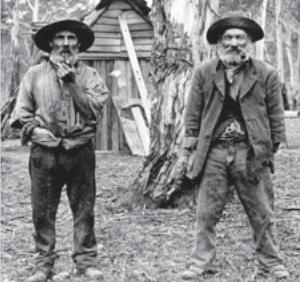 Timber Getters
“A proud a rich history”.. in logging native forests and destroying native habitat for personal profit
What’s Changed?
These days they do science degrees and come out calling themselves ‘foresters’. Timber Getters
“A proud a rich history”.. in logging native forests and destroying native habitat for personal profit
What’s Changed?
These days they do science degrees and come out calling themselves ‘foresters’.
.
But there are no plans to stop logging in native forests because the state government is locked into contracts with long-term wood supply commitments.
”The timber industry is often the main employer and source of economic activity in rural and regional areas,” the spokeswoman said.
Mr Shoebridge said the industry was pushing for the government to increase the volume of wood harvested from 160,000 cubic metres to 269,000 cubic metres a year.
”To feed that massive 80 per cent increase will require logging more than 40,000 hectares of NSW forest every year from protected reserve areas and overexploited state forests.”
Logging in Forestry Corporation’s central region native forests near Wauchope lost $2.36 million in 2012. The western region near Dubbo lost $3 million, the north-east region forest near Coffs Harbour lost $1.63 million, while the south-east region near Batemans Bay lost $931,700.
A Forestry Corporation spokeswoman said if logging in native forests was stopped, taxpayers would have to foot the bill for the management of land.>>
.
[Source: ‘Hatchet job on native forest logging’, 20130519, by journalist Kirsty Needham, Sydney Morning Herald, ^http://www.smh.com.au/nsw/hatchet-job-on-native-forest-logging-20130518-2jtcf.html]
.
[Ed: So be it. The $8 million in annual losses would quickly pay for the legal payout of the wood supply contracts. It’s about political will, and Barry is a teddy bear.]
.

So the timber industry in New South Wales is now pushing to be allowed to log up to a million hectares of national parks so it can harvest the volumes promised in unsustainable timber supply contracts. This outrageous move has occurred at the same time that the NSW Government is conducting a secret review of forestry regulations and timber supply options.
Throughout this review, the timber industry has been campaigning hard to bring in damaging reversals of the hard won forestry regulations that protect our threatened animal and plant species and their habitats.
Premier Barry O’Farrell must resist pressure from the Shooters and Fishers Party, and from within his own government, to make more forests available for logging and other damaging changes to the forestry regulations that protect our unique wildlife and the areas they call home.
It is unthinkable that the O’Farrell Government would allow the destruction of areas like Nightcap National Park so the Forestry Corporation can turn a profit.
.
[Source: Kate Smolski, Campaigns Director, Nature Conservation Council of New South Wales, ^http://www.nccnsw.org.au]
.
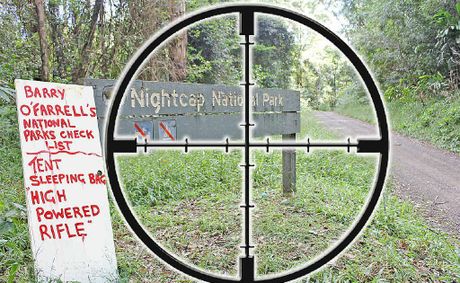 Nightcap National Park in the sights of cowboy hunters Nightcap National Park in the sights of cowboy hunters
.
And the shooting threat hasn’t gone away…
<<Several North Coast national parks have been included on a “hit list” of parks to be considered for recreational shooting.
Last week Premier Barry O’Farrell announced changes to the Game and Feral Animal Control Act (2002) that would allow 79 of the state’s 799 national parks, nature reserves and conservation areas to be used by licensed shooters. The list includes the Nightcap, Richmond Range and Yabbra National Parks.
The announcement has been widely criticised by environment groups and the Opposition as a “backroom deal” to secure the support of the Shooters and Fishers Party in return for support to privatise the state’s electricity assets.
Premier O’Farrell said prior to the last election: “There will not be a decision to turn our national parks into hunting reserves.”

Vice president of the ^North Coast Environment Council Mr Jim Morrison said he was “absolutely outraged” by the election backflip.
“We’re disappointed because we were given assurances before the election this would not happen,” he said. “I’ve got little faith in the O’Farrell government now to manage the environment… I think the difficult issue will be compliance because when there are people running around with guns, it will be impossible for National Parks staff to know who is legal and who isn’t… I’m frightened people who visit some of the more remote parks where there aren’t any services will be turned off visiting for activities such as bushwalking.”
Mr Morrison said he also feared a resurgence of “cowboy shooting activity” in remote areas. “It’s a bad message to be supporting a blood sport and I don’t believe it will be an effective way to do feral animal control. It should be managed by park staff.”
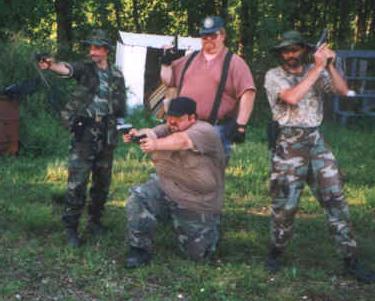
The NSW Public Service Association (PSA), which represents park rangers, has directed its members not to assist with any activity involved with establishing recreational hunting in national parks in NSW.
PSA General Secretary Mr John Cahill:
.
“Our members have expressed serious concerns about the danger to themselves and the community when shooting is allowed in bushland popular with walkers and picnickers. Our members have been working very hard to control and manage feral animals in parks.
Recreational shooting will compromise the professional and scientifically proven feral animal control programs run by National Parks staff, placing native plants and animals at risk.
“Industrial action like this is not a decision we take lightly but we simply cannot let the State Government’s compromise of our national parks to go ahead.”
.
Spokesperson for the North East Forest Alliance (^NEFA) Dailan Pugh issued a statement calling for the Federal Government to intervene.
“The fact that Premier O’Farrell can say in one breath that they will exclude World Heritage, and in the other identify six World Heritage listed parks for shooting, shows how ill-conceived his backflip is… The Federal Government needs to intervene to over-ride the State Government’s announced intention to allow shooting in world-heritage properties,” Mr Pugh said.
CEO of Northern Rivers Tourism Russell Mills issued a cautious warning. “My initial view is that national parks like the Nightcap that are part of the World Heritage and their primary
drawcard is the pristine nature of the wilderness areas… If National Parks (management) are considering the pros and cons of shooting, I hope they take into consideration the motivation for visiting parks, and I believe they would.”
Rob Andrews from the Northern Zone Hunting Club said he had been “deluged” by up to six calls a day since the Premier’s announcement from people wanting to know how to go about getting licences.>>
.
[Source: ‘Parks in shooters’ sights’, 20130607, by journalist Andy Parks, Echo News, ^http://www.echonews.com.au/news/parks-in-shooters-sights-govt-to-allow-hunting-in-/1407811/]
.
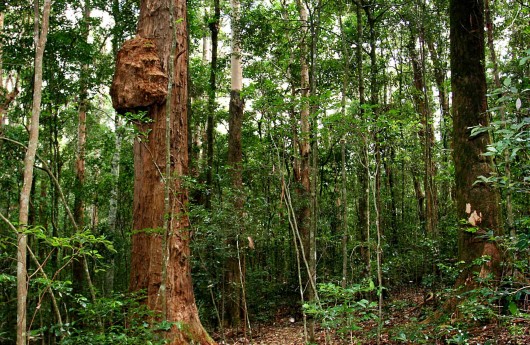 Richmond Range National Park
Targeted for logging and shooting by its custodian, the New South Wales Government
[Source: ^http://www.nationalparks.nsw.gov.au/richmond-range-national-park]
Richmond Range National Park
Targeted for logging and shooting by its custodian, the New South Wales Government
[Source: ^http://www.nationalparks.nsw.gov.au/richmond-range-national-park]
.
Further Reading:
.
[1] >Forestry Bill 2012 Explanatory Note.pdf (380 kb)
.
[2] ^Forests NSW Annual Report 2011-12.pdf (10.4 MB)
.
[3] >Forests NSW Facts and Figures 2011-12.pdf (2.8 MB)
.
[4] ^Forests NSW Annual Report 2010-11.pdf (7.6 MB)
.
[5] >Forests NSW Facts and Figures 2010-11.pdf (3.5 MB)
.
[6] >Forests NSW Annual Report 2009-10.pdf (6.2 MB)
.
[7] >Forestry in NSW 1996.pdf (1.5MB)
.
Sunday, May 26th, 2013
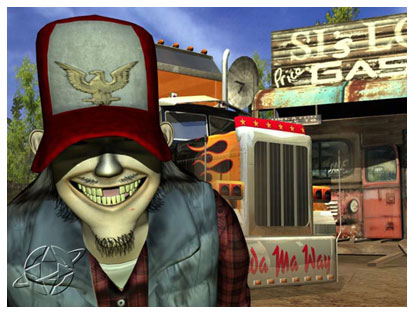 Ada Ma Way! Ada Ma Way!
.
The New South Wales Government’s dictatorial roads department, the RTA-come-RMS, has again kowtowed to the trucking lobby by deciding in its infantile wisdom to remove centre double lines from the Hawkesbury Road through the Blue Mountains west of Sydney, so that big sand trucks with trailers (basically ‘B-Doubles‘) can hog both sides of the highway.
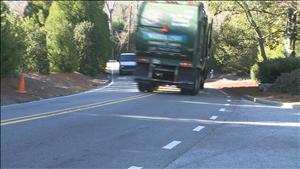 Looka Me Looka Me Looka Me! Looka Me Looka Me Looka Me!
.
The idiots in the fancy new RTA-come-RMA headquarters in Parramatta want no restrictions on truck-length, no speed restrictions for these trucks along Hawkesbury Road – the bigger trucks the better, God Damn!
.
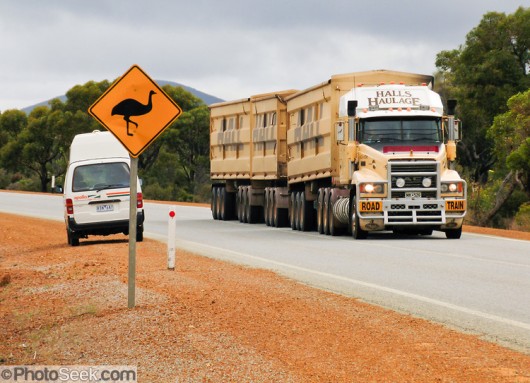 Strategy to avoid a B-Double
An Outback vernacular joke, not so funny… Strategy to avoid a B-Double
An Outback vernacular joke, not so funny…
.
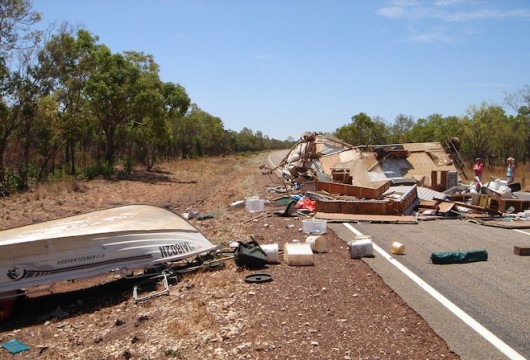 Outback Crash
Often the End of Everyone’s Story! Outback Crash
Often the End of Everyone’s Story!
.
It’s a Northern Territory Outback Approach – unlimited speed and road trains – despite Hawkesbury Road winding tightly down the mountain at Hawkesbury Heights and passing through residential areas between Springwood and Richmond.
.
Winmalee ain’t trucking Tennant Creek!
.
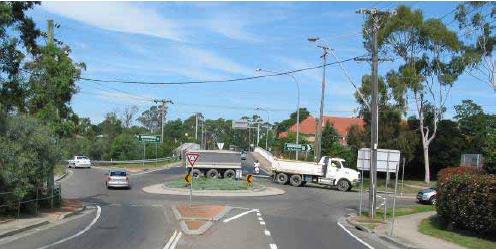 . .
According to Hawkesbury Road residents typically 90 tipper trucks with dog trailers (basically B-Doubles) hoon along the road daily.
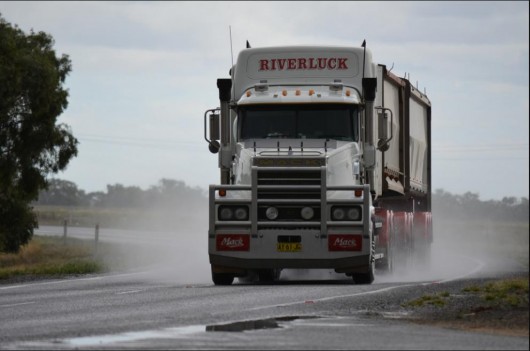 . .
In late 2012, the RTA-come-RMS removed the centre line marking on four hairpin bends at Hawkesbury Heights so that bigger trucks can cross the center of the road without crossing over centre double lines because the double lines have been painted over.
No centre lines, no road centre, see, just like Mount Panorama! No speed cameras, no police patrols, speeding cowboy truckers out of control. Car, motorbike and pedestrian traffic are just collateral damage.
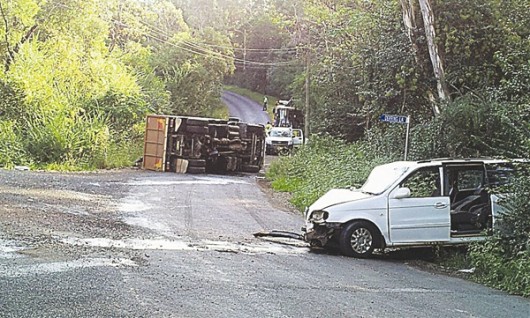 Bugger! Bugger!
Truck rollover along Mill Road at Kurrajong in the Blue Mountains
Cowboy Trucker going too fast – nuh.
[Source: Photo by Top Notch Video, in article ‘Lucky Easter accident escape’, 20120412, by Cerise Burgess, journalist, Hawkesbury Gazette, ^http://www.hawkesburygazette.com.au/story/273890/lucky-easter-accident-escape/]
.
The local Blue Mountains Council has rightly branded the RTA-come-RMS decision to remove these double centre lines as “absolutely insane”‘, “ridiculous” and “plain criminal” at its councillor meeting on 23rd April 23 2013. Councillor Brendan Christie stated, “I just think it is completely ridiculous that six bureaucrats from the RMS sat down for a nice lunch and this is all they could come up with.”
 Blue Mountains Council’s delegated Local Traffic Committee: Minutes of Meeting 20130326 Blue Mountains Council’s delegated Local Traffic Committee: Minutes of Meeting 20130326
.
Two years ago in 2011, the Blue Mountains Council reported on a Road Safety Action Plan. The report identified that:
<<the Blue Mountains has almost triple the amount of speed related crashes than the Sydney Region. Our rate of 33.73% is almost double that of the rate of NSW. This makes reducing speeding on our roads a clear road safety priority for the Blue Mountains community.>>
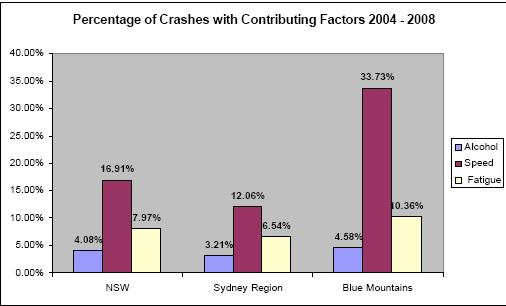 . .
The report also identified trucks as a key issue:
<<The Blue Mountains has a significantly higher proportion of trucks involved in crashes than the Sydney Region, Western Sydney or NSW.
Over a five year period, light trucks constituted 9.53% of crashes in the Blue Mountains. This can be compared with 7.85% in Sydney, 8.31% in Western Sydney and 8.67% in New South Wales as a whole. The Blue Mountains also experienced significant increases in crashes involving trucks over the last five years.>>
.
.
Yet at the same time, the Blue Mountains Council is similarly embracing more trucks transiting through Blue Mountains by planning a new truck route through native bushland habitat and over the headwaters of Fitzgerald Creek and carved through critically endangered Sydney Turpentine Ironbark Forest in protected Deanii Reserve.
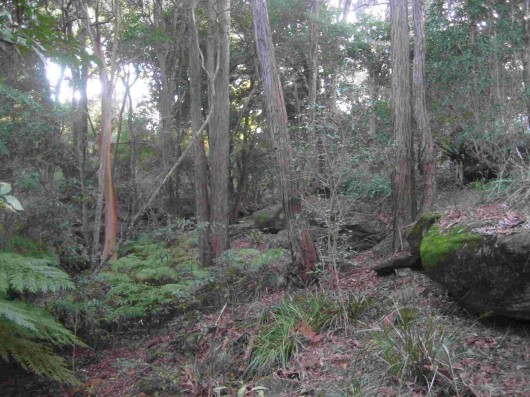 Example of a Sydney Turpentine Ironbark Forest
[Source: ^http://www.georgesriver.org.au/Riverkeeper-Photo-Gallery.html] Example of a Sydney Turpentine Ironbark Forest
[Source: ^http://www.georgesriver.org.au/Riverkeeper-Photo-Gallery.html]
.
The Council has already spent $77,000 on a study to consider possible route options for a truck link road between Hawkesbury Road and the Great Western Highway at Valley Heights. The preferred route necessitates massively increasing the road weight limit, creating a two-lane, three-span bridge 35 metres above Fitzgerald Creek with a total the project construction cost of $26 million, all to encourage more trucks through the Blue Mountains.
Borrowing the same mealy-mouthed spin as the RTA-come-RMS, the Council’s consultants try to justify the new road would “improve traffic flow and reduce delays.” No doubt its environmental impact statement would be conjured up by darkside ecologists to pretend the road works and bridge works would cause minimal impact to endangered ecology.
The initial council study will go on public exhibition soon with a report back to council in August 2013. We shall be ready to rip the EIS apart, or will it be watered down to another Review of Environmental Effects as per usual?
.
[Source: ‘Springwood link road plan’, 20130508, by Shane Desiatnik, journalist, Blue Mountains Gazette, ^http://www.bluemountainsgazette.com.au/story/1486914/routes-named-for-springwood-link-road-plan/]
.
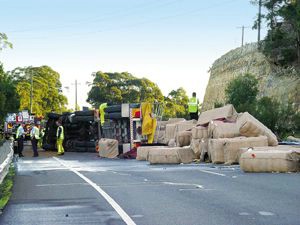 Truck rollover in the Blue Mountains April, 2005
RTA-come-RMS is giving tacit approval for truckers to use excessive speed and ignore common safety measures. Truck rollover in the Blue Mountains April, 2005
RTA-come-RMS is giving tacit approval for truckers to use excessive speed and ignore common safety measures.
.
The RTA-come-RMS is the handmaiden to the truck industry and has allowed Hawkesbury Highway to become a trucking cowboy corridor.
The Bells Line of Road is just a bad:
 . .
Somewhere in the Blue Mountains there is a truck collision or rollover a week. The trucking menace is out of control and these are the bureaucrats responsible – New South Wales Premier Barry O’Farrell and his Roads Minister Duncan Gay.
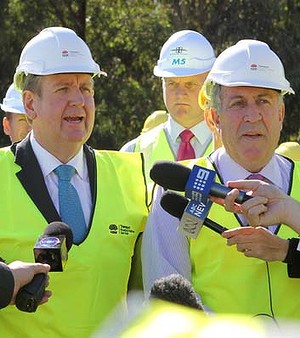 Premier Barry O’Farrell (left) and Roads Minister Duncan Gay
Handmaidens of Trucking Premier Barry O’Farrell (left) and Roads Minister Duncan Gay
Handmaidens of Trucking
.
Local residents and ordinary users of the Hawkesbury Road are intimidated by these trucking cowboys speeding, hogging the road and tailgating like their on a speedway circuit.
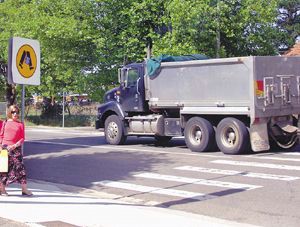 Blackheath, Blue Mountains, already a statistical victim
Betty Dowdell of Blackheath, 16 Dec 2008, rest in peace
Your memory is not lost. Blackheath, Blue Mountains, already a statistical victim
Betty Dowdell of Blackheath, 16 Dec 2008, rest in peace
Your memory is not lost.
.
Drivers on the bends of Hawkesbury Road have raised concerns about the serious risks of heavy vehicles crossing to the wrong side of the road as they negotiate the narrow corners. The Roads and Maritime Service removed the centre lines on the bends late last year which residents say has only increased the problem.
 Trucker Wet Dreaming Trucker Wet Dreaming
.
With four schools on the 10km road, driver safety is paramount both on the Winmalee stretch and also for those people driving down from the Mountains via the bends. According to local politicians, the solution would be for a proper review of the road by the RTA-come-RMS, with a view to enforcing the road rules, including a return to the centre lane markings on the bends and looking at other engineering options.
But many local residents have had enough and are demanding a complete ban trucks from driving on Hawkesbury Road which would mean it would no longer be gazetted as a State Route.
.
Barry, unhitch from the greedy Trucking Lobby
Support the safety concerns of Residents
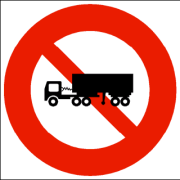 No Articulated Trucks on Hawkesbury Road No Articulated Trucks on Hawkesbury Road
No Trucking Shortcuts!
.
[Source: ‘Hawkesbury Road residents driven round the bend’, 20130424, by Damien Madigan, editor, The Blue Mountains Gazette, ^ http://www.bluemountainsgazette.com.au/story/1454002/hawkesbury-road-residents-driven-round-the-bend/]
.
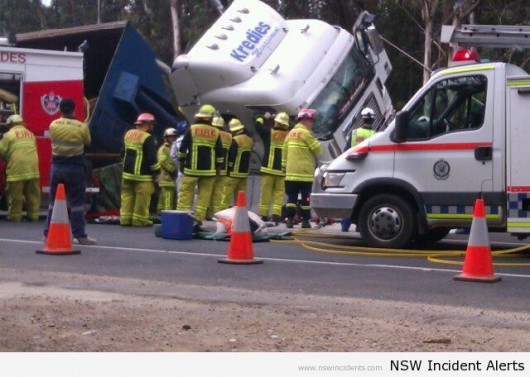 Kredies Trucking speeding down Victoria Pass, 5th December 2011 Kredies Trucking speeding down Victoria Pass, 5th December 2011
.
<<A truck driver has been airlifted to hospital with suspected spinal injuries, and a major cleanup operation has been undertaken following a truck overturning on Mount Victoria Pass this afternoon (5 December 2011).
Emergency Services were called to the bottom of Mount Victoria Pass (Great Western Highway) just after 2:30pm today following reports an eastbound semi-trailer carrying scrap metal had rolled onto the concrete divider, leaving the driver trapped in the cabin.
Several Fire and Rescue NSW crews, Police Rescue, an Ambulance and a rescue helicopter responded to the scene. Rescue crews freed the driver about 4:45pm before he was airlifted to hospital suffering suspected spinal injuries.
The Great Western Highway has been closed for several hours while a clean up and salvage operation is underway with debris scattered across the roadway. The RTA has advised traffic is being diverted into the Darling Causeway with eastbound motorists being advised to use Chifley Road (Mort St) and the Darling Causeway as an alternative route.>>
.
[Source: ‘Truck Overturns at Mount Victoria’, 20111205, by NSW Incident Alerts, ^http://news.nswincidents.com/2011/12/05/traffic/persons-trapped/truck-overturns-mount-victoria/]
.
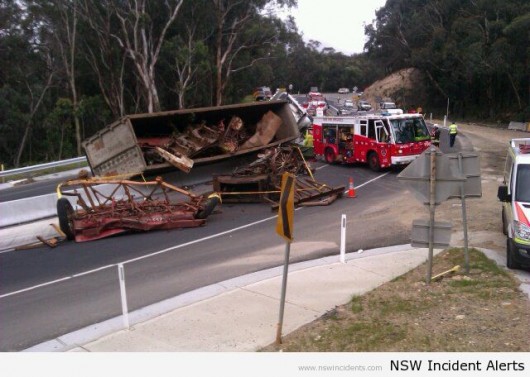 Speeding Truck Overturns down Mt Victoria Pass, 3rd August 2011
Two truckers dead
The pass has been there and steep for a long time – nothing new. Speeding Truck Overturns down Mt Victoria Pass, 3rd August 2011
Two truckers dead
The pass has been there and steep for a long time – nothing new.
.
<<Two men have been crushed to death inside the cabin of a truck in the Blue Mountains today. Police said the truck rolled and crashed into a barrier on the Great Western Highway, near the top of Victoria Pass, just after 10am. The two men were found dead inside the cabin. Their ages are unknown. One eastbound lane of the highway is expected to be closed for some time while police investigate.>>
.
[Source: ‘Two killed in Blue Mountains truck crash’, 20110803, by Georgina Robinson, Sydney Morning Herald, ^http://www.smh.com.au/nsw/two-killed-in-blue-mountains-truck-crash-20110803-1iaqu.html]
.
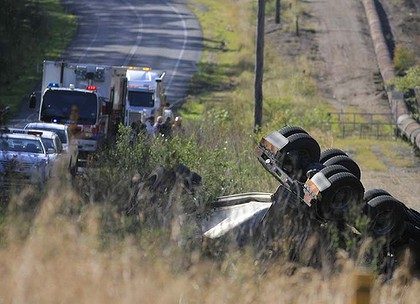 It’s like the approach to Bagdad after Allied Forces’ Battle of Bagdad in 2003 It’s like the approach to Bagdad after Allied Forces’ Battle of Bagdad in 2003
[Source: ‘F3 accident outpost clears way for network of depots’, 20111027, Sydney Morning Herald,
^http://smh.drive.com.au/roads-and-traffic/f3-accident-outpost-clears-way-for-network-of-depots-20111026-1mk7i.html]
.
Footnote
.
Again, we didn’t have to wait long to learn about yet another dangerous trucking cowboy in New South Wales.
In Sydney’s outer north this morning, a truck side-swiped a school bus and didn’t stop.
The small school bus was travelling along Bay Road at 9 am at Berrilee, when the bus driver was forced to swerve to avoid a head-on collision with the truck over the centre lines.
In avoiding the collision, the bus driver scraped along a rockface alongside the left hand side of the narrow section of Bay Road. Four bus windows were smashed, and seven children on the bus suffered minor cuts from the smashed glass. Two of them were taken to hospital. The truck driver drove on (another hit and run) following the incident and yet police decided not to contemplate pursuing criminal charges.
Unbelievably the police are sight unseen self-excusing the trucker for ‘perhaps’ not realising the damage, because of some fabricated personal presumption that the truck was too big for the driver to notice. “We don’t think he even realised something had gone wrong” the police spokesman said.
Was this comment correctly reported by the media? If so, how does the police spokesman know? Does it take a child to die for these police to treat seriously the near fatality of children on a supposedly safe school bus?
If so, these police should state this presumption to the faces of the children’s parents and see what response they get for excusing dangerous trucking behaviour endangering the lives of their children.
If so, then these police are ignorant of what could have happened, of the likely trauma experienced by both bus driver and the children who will never forget this incident that could have ended their lives. These police seem to nonchalantly care nothing for road safety or for proactive policing.
‘She’ll be right reckless trucking‘ is unacceptable and here we record yet another trucking cowboy excused by police, until next time when an innocent road user is killed.
Not good enough!
.
[Sources: ‘Children injured in school bus crash at Berrilee in Sydney’, 20130529, ABC News, ^http://www.abc.net.au/news/2013-05-29/three-children-injured-in-school-bus-crash/4719814?§ion=news; and ‘Sydney school bus crash injures children, 20130529, by AAP, ^http://www.news.com.au/breaking-news/national/children-hurt-in-sydney-bus-crash/story-e6frfku9-1226652814870]
.
 2005: Another B-Double truck slammed into the rear of a school bus while speeding in fog at 8:30 am (school transit time) in country Victoria. About 20 primary school children were lucky not be killed as the back of a school bus was ripped off in the collision near Ballarat.
[Source: Photo by Craig Sillitoe, in article: ‘Bus crash students lucky to be alive’, 20050513, by Adam Morton, The Age, Victoria,
^http://www.theage.com.au/news/National/Bus-crash-students-lucky-to-be-alive/2005/05/13/1115843345721.html]
2005: Another B-Double truck slammed into the rear of a school bus while speeding in fog at 8:30 am (school transit time) in country Victoria. About 20 primary school children were lucky not be killed as the back of a school bus was ripped off in the collision near Ballarat.
[Source: Photo by Craig Sillitoe, in article: ‘Bus crash students lucky to be alive’, 20050513, by Adam Morton, The Age, Victoria,
^http://www.theage.com.au/news/National/Bus-crash-students-lucky-to-be-alive/2005/05/13/1115843345721.html]
.
Tags: Ada Ma Way, Barry O'Farrell, Bay Road, Berrilee, Blue Mountains, Blue Mountains Council, centre double lines, cowboy truckers, Duncan Gay, Hawkesbury Heights, Hawkesbury Road, Mill Road, Road Safety Action Plan, RTA-come-RMS, sand trucks with trailers, school bus, Springwood, State Route, Sydney Turpentine Ironbark Forest, tipper trucks with dog trailers, truck crash, trucking expressway, Winmalee
Posted in Blue Mountains (AU), Threats from Road Making | No Comments »
Add this post to Del.icio.us - Digg
Wednesday, May 22nd, 2013
Blue Mountains communities are rightly frightened of these killer B-Double cowboys hurtling along the Great Western Highway
.
~ the more lanes, the faster they hurtle!
.
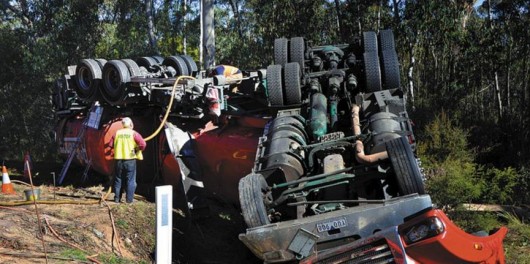 Last week: B-Double fuel truck driver fell asleep at the wheel through Medlow Bath
This Ron Finemore’s driver fell asleep at the wheel of this dangerous B-Double fully laden with petrol, while hurtling through Medlow Bath.
[Source: Photo by Len Ashworth, Lithgow Mercury, 20130512,
^http://www.bluemountainsgazette.com.au/story/1500162/lucky-escape-for-truck-driver/?cs=12]
.
His job is currently advertised: ^http://www.ronfinemoretransport.com.au/career-opportunities [>Read More.pdf ] Last week: B-Double fuel truck driver fell asleep at the wheel through Medlow Bath
This Ron Finemore’s driver fell asleep at the wheel of this dangerous B-Double fully laden with petrol, while hurtling through Medlow Bath.
[Source: Photo by Len Ashworth, Lithgow Mercury, 20130512,
^http://www.bluemountainsgazette.com.au/story/1500162/lucky-escape-for-truck-driver/?cs=12]
.
His job is currently advertised: ^http://www.ronfinemoretransport.com.au/career-opportunities [>Read More.pdf ]
.
May 2013: B-Double Driver Falls Asleep
.
<<A fully-laden double fuel tanker overturned in a short, straight, three-laned section of the highway between Katoomba and Medlow Bath in the early hours of Sunday, May 12.
The giant rig owned by Orange-based Ron Finemores Transport was being driven west when it veered onto the road shoulder and overturned down an embankment, coming to rest with the twin tankers upside down.
An ambulance spokesman said the driver, a 34-year-old Millthorpe man, was able to free himself from his wrecked cabin and clambered back to the roadway where one of the first on the scene was an off-duty paramedic. He was taken to Katoomba Hospital and treated for minor facial injuries.
Driver Fatigue is suspected as a possible cause of the smash.>>
.
[Source: ‘Lucky escape for truck driver’, 20130515, by Len Ashworth, editor The Lithgow Mercury newspaper, ^http://www.bluemountainsgazette.com.au/story/1500162/lucky-escape-for-truck-driver/?cs=12]
.
[Ed: So are Finemore’s drivers paid by the hour or by completed trip – where the more trips and the faster they hurtle along, the cheaper it is for the trucking corporation? Are there any unions left to represent truck drivers’ occupational health and safety on The Road as a Workplace?
.
On The Road as a Workplace, the New South Wales Government provides no truck rest stop along the entire length of the Great Western Highway between Orange and Sydney (255 km) in either direction to properly cater for heavy vehicle driver fatigue.
.
The token parking bay at Faulconbridge westbound through the Blue Mountains is a substandard joke, with the only facilities being two rubbish bins. The westbound shoulder at Mount Victoria opposite the Caltex Service Station for trucker cabin sleeping is a disgraceful defacto emergency stopover and only inflicts noise pollution to nearby locals 24/7.
.
Overpaid NSW Transport urban bureaucrats Peter Duncan, Les Wielinga, Roads Minister Duncan Gay, and millionnaire magnate Ron Finemore need to do a few nights truck cabin kip there (this time of year) and then directly turn up for work the next day. At the same time, these same NSW Government urban bureaucrats justify billions to widen the highway to four lanes to facilitate more corporate truck freight – as if an urban fatigue free route.
.
Ron Finemore Transport is one of the corporate trucking lobbyists pushing for more and bigger trucks along the Great Western Highway. In 2012 the company opened a new $9 million facility in Orange along the highway to house its 120 B-Double truck drivers and fleet of 50 B-Doubles.
.
Selfish trucking magnates like Finemore divert New South Wales Government from investing in freight rail services and infrastructure. They perpetuate the dangerous B-Double Menace that is increasingly killing and maiming ordinary users of our regional highways and a deadly social problem avoided by governments around Australia.]
.
[Source: ‘Finemore opens $9 million facility in regional NSW’, 20121012, ^http://ichainnel.com/en/news/361889_0ikxd5.html]
.
May 2013: Truck kills a Woman in her Car
.
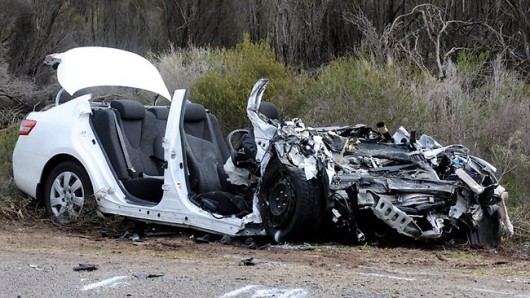 Different head-on collision, but similar consequence
[Source: Photo by Richard Polden, Perth Now
^http://www.perthnow.com.au/news/western-australia/motorist-trapped-after-car-truck-head-on-in-bullsbrook/story-e6frg13u-1226111010848] Different head-on collision, but similar consequence
[Source: Photo by Richard Polden, Perth Now
^http://www.perthnow.com.au/news/western-australia/motorist-trapped-after-car-truck-head-on-in-bullsbrook/story-e6frg13u-1226111010848]
.
<<A woman has died after a crash between a truck and car today (Thursday) at Luddenham in Sydney’s west, police say. Police and other emergency services attended the collision on The Northern Road, near Littlefields Rd, about 10am. A brief will be prepared for the Coroner.
.
Meanwhile, a 44-year-old man has been injured after a multiple-vehicle crash in Sydney’s west this morning. About 5:05am, two semi-trailers, A Toyota Hilux utility and a Ford sedan at the intersection of the Great Western Highway and Doonside Rd at Arndell Park. Emergency services personnel took about 30 minutes to remove the utility driver from the vehicle. He is being treated in Westmead Hospital for chest and arm injuries.>>
.
[Source: ‘Woman dies in crash involving truck’, 20130515, Cowra Community News, ^http://cowracommunitynews.com/viewnews.php?newsid=3650&id=4]
.
May 2013: Truck Drivers do Hit and Run
.
<<A B-Double truck travelling in lane three on the M4 Motorway near St Clair (Sydney’s west) has changed lanes and moved into the path of a utility this morning (Sunday).
The B-Double struck the car and the car then flipped over and ended on its roof, killing the car driver. The driver of the B-Double truck failed to stop and continued travelling west along the M4.
[Ed: … I own the road but I saw nuuthing!]
.
<<Meanwhile, a 32-year-old male pedestrian has suffered a serious leg fracture when he was struck by a truck in another hit-and-run near Newcastle last night (Saturday).
Police say the man was walking north in the breakdown lane of the Pacific Highway at Tomago, where three lanes merge into two, when he was hit by a truck at a point past the northern end of Hexham Bridge about 6:45pm. The man was thrown on to the highway’s grass shoulder, while the truck did not stop!
The injured man managed to crawl back to the edge of the road and hail a passing motorist for help, police say. He was treated at the scene and taken to Newcastle’s John Hunter Hospital suffering a serious lower leg fracture. The Newcastle Crash Investigation Unit is looking into the crash and making attempts to track down the truck involved.>>
[Ed: … I own the road but I saw nuuthing!]
.
May 2013: B-Double hangs off Melbourne’s Bolte Bridge
.
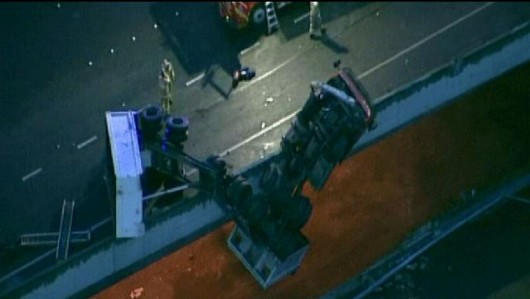 B-Doubles Out of Control B-Doubles Out of Control
.
<<The driver plunged from the cabin of his vehicle after a road crash left the truck’s cabin dangling off Melbourne’s Bolte Bridge just after 6.30am today (17th May, 2013).
There is traffic chaos on a Melbourne freeway where a truck has crashed and been left dangling precariously over the side. The truck driver was taken to Royal Melbourne Hospital and is in a critical condition. The driver of the other car was also taken to hospital in an unknown condition.
The incident has caused chaos on the Tullamarine Freeway, which is now closed to inbound traffic at Flemington Road. City-bound traffic on the Tullamarine Freeway remains at a standstill.
The road will likely be closed until later today and transport authority VicRoads has advised motorists to avoid the heavily-congested area. Crews will work to remove the truck, which is hanging halfway over the bridge, and assess damage to the road before it is reopened to motorists.>>
.
[Source: ‘Man falls from truck dangling off bridge’, 20130517, by Sylvia Varnham O’Regan, Nine News (TV), ^http://news.ninemsn.com.au/national/2013/05/17/07/16/truck-hanging-from-bridge-after-freeway-crash]
.
May 2013: Woman dies in crash involving truck
.
<<A woman has died after a crash between a truck and car today (Thursday) at Luddenham in Sydney’s west, police say. Police and other emergency services attended the collision on The Northern Road, near Littlefields Rd, about 10am. A brief will be prepared for the Coroner.
.
Meanwhile, a 44-year-old man has been injured after a multiple-vehicle crash in Sydney’s west this morning.
About 5:05am, two semi-trailers, A Toyota Hilux utility and a Ford sedan at the intersection of the Great Western Highway and Doonside Rd at Arndell Park.
Emergency services personnel took about 30 minutes to remove the utility driver from the vehicle. He is being treated in Westmead Hospital for chest and arm injuries. No one else was injured, police say.>>
.
[Source: ‘Woman dies in crash involving truck’, 20130515, Cowra News, NSW, ^http://cowracommunitynews.com/viewnews.php?newsid=3650&id=4]
.
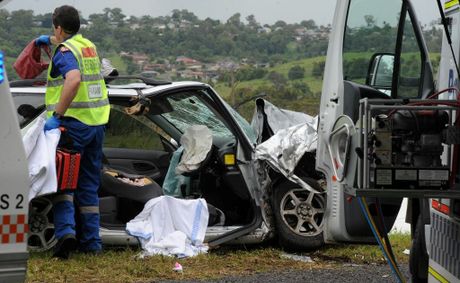 Dec 2010: Ballina, NSW – a multiple vehicle crash caused by a truck over the centre line
[Source: ^http://www.northernstar.com.au/news/trucks-crash-bangalow-road/712289/]
Dec 2010: Ballina, NSW – a multiple vehicle crash caused by a truck over the centre line
[Source: ^http://www.northernstar.com.au/news/trucks-crash-bangalow-road/712289/]
.
Apr 2013: Truck catches Fire
.
<<A truck driver had a lucky escape after his semi-trailer caught fire in Victoria’s north. The truck carrying carpet was travelling on the Hume Highway near Wallan when the blaze began at 2pm. It is understood the driver fled the cabin of the truck as soon as he noticed the flames.
Up to 13 fire crews have been on scene battling the big blaze for hours. Police will investigate the cause of the fire as soon as it has been brought under control.
.
[Source: ‘Truck fire causes Hume Highway delays near Wallan’, 20130421, by Alex White, Herald Sun (Victoria), ^http://www.heraldsun.com.au/news/victoria/truck-fire-causes-hume-highway-delays-near-wallan/story-e6frf7kx-1226625363194]
.
Apr 2013: Plastics truck explodes on highway
.
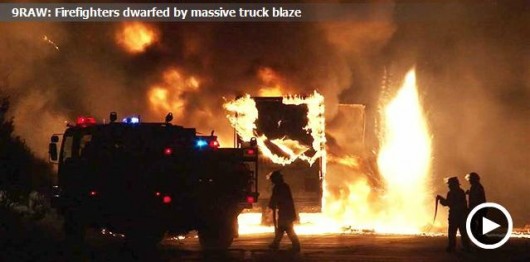 Truck explodes on Hume Freeway near Berrima Truck explodes on Hume Freeway near Berrima
.
<<A driver escaped injury after a truck loaded with plastics exploded on a highway south-west of Sydney early this morning.
A truck loaded with wheelie bins has been engulfed in fire on a highway south-west of Sydney. The truck caught fire just (around midnight) today on the Hume Highway, south of Berrima.
A spokesperson for the NSW Rural Fire Service told ninemsn the trailer was filled with 800 domestic garbage bins. Molten plastic spread across the southbound lanes of the highway.
It took six fire trucks to extinguish the blaze which caused “extensive” damage to the trailer.>>
.
[Source: ‘Plastics truck explodes on highway’, 20130501, by Sophie Cousins, Nine News (TV), ^http://news.ninemsn.com.au/national/2013/05/01/08/17/plastics-truck-explodes-on-highway]
.
Apr 2013: Young man killed in horror head-on with B-Double
.
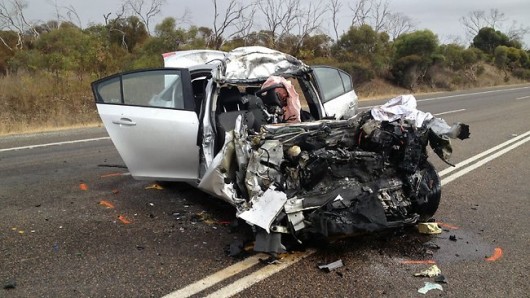 Nothing Left Nothing Left
Pacific Highway near Ulmarra
.
<<Police confirmed a man aged in his 20s died after the southbound Mazda 929 he was driving was involved in a head-on with a B-Double truck. The crash happened 3km north of the town about 3.15am.
Witnesses told police after the initial impact the truck swerved off the highway, rolled onto its side into a paddock and burst into flames. Firefighters who battled the blaze said the driver had a lucky escape. Fire crews said they were met by an inferno when they arrived on scene with flames rising as high as 10 to 20 metres above the wreckage.
The accident happened on a notorious Pacific Highway section…>>
.
[Source: ‘Young man killed in horror head-on with b-double’, 20130423, Coffs Coast Advocate newspaper, ^http://www.coffscoastadvocate.com.au/news/horror-head-on-crash-kills-man/1841067/]
.
Apr 2013: Speeding B-Double crashes and cattle killed, others shot
.
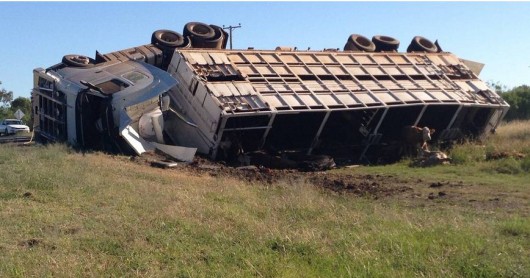 B-Double Cattle Truck crash kills livestock, injured cattle are shot
Photo by Moree Champion B-Double Cattle Truck crash kills livestock, injured cattle are shot
Photo by Moree Champion
<<There was yet another truck roll on the Garah/Mungindi Road.
Dozens of cattle have been killed in a B-Double accident in north-west NSW. The truck rolled on a bend on the outskirts of Garah near Moree just after seven this morning.
Moree Plains Council ranger Jock Jones says locals are working together to save what cattle they can, and round up those that got away.
“We’ve used grinders to open the tray up. We’ve got a front end loader that’s pulling the truck apart,” he said. “It’s a hideous job now. Pulling them out is very sad. I’ve had to shoot a lot but we are saving a lot. “Most of them have got out and run off.”
There were about 60 cattle on board. It’s thought the cattle had come from Longreach in Queensland.
The 46-year-old driver of the truck was thrown clear on impact. He was treated by paramedics for facial injuries and cuts to his arms, back and legs. He was taken to Moree hospital in a stable condition.>>
.
Ed: Previously on the same stretch of road: ‘Sheep killed in truck rollover near Garah’, 22nd February 2010…<<Dozens of sheep died and others were put down after a B-Double truck rolled over near Garah yesterday (Sunday).>>
.
[Sources: ‘Cattle euthanased after B-double crash’, 20130408, Northern Daily Leadernewspaper, ^http://www.northerndailyleader.com.au/story/1417892/cattle-euthanased-after-b-double-crash/, and ‘Truck crash kills dozens of cattle’, 20130408, by Lisa Herbert, ABC Rural, ^http://www.abc.net.au/rural/news/content/201304/s3732059.htm]
.
Mar 2013: Two Escape Sydney Truck Fire
.
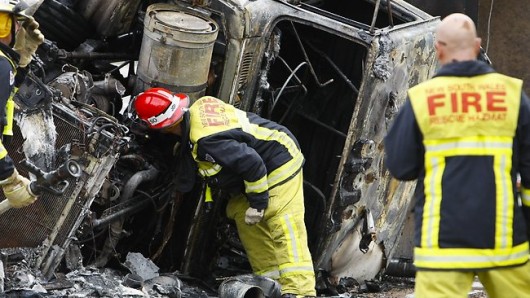 Truck Crash at the corner of Roger St and Old Pittwater Rd Brookvale, on Sydney’s Northern Beaches
[Photo by Cameron Mitch, The Sunday Telegraph] Truck Crash at the corner of Roger St and Old Pittwater Rd Brookvale, on Sydney’s Northern Beaches
[Photo by Cameron Mitch, The Sunday Telegraph]
.
<<Two people have escaped with minor injuries after the truck they were travelling in rolled over and caught on fire in Sydney’s north. The semi-trailer truck, which was carrying sand, rolled over about 8am on Old Pittwater Road in Brookvale, Fire and Rescue NSW said on Saturday.
“Two people escaped from the truck’s cabin before it caught fire,” Superintendent Tom Cooper told AAP. “The fire caused one of the truck’s 400 litre tanks of diesel to rupture and the diesel spilled into a storm water drain.”
.
[Source: ‘Two escape north Sydney truck fire’, 20130309, by AAP, Daily Telegraph newspaper, ^http://www.dailytelegraph.com.au/two-escape-north-sydney-truck-fire/story-e6freuy9-1226593712677]
.
Mar 2013: Two killed after B-Double and car collide head-on
.
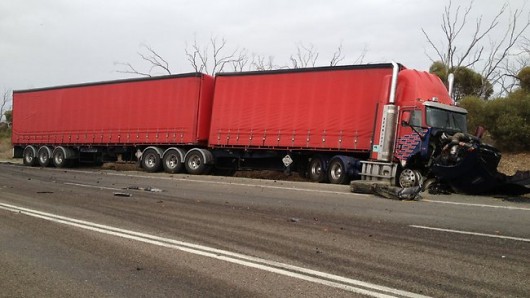 No chance at Ki Ki, South Australia No chance at Ki Ki, South Australia
Picture: First On Scene Media Source: adelaidenow
.
<<..In a shocking start to the Easter holidays, two people, both aged 22, believed to be Asian nationals living in Adelaide, died after the rental car they were driving crossed to the wrong side of the road and slammed into a B-Double truck on the Dukes Highway near Ki Ki (South Australia), just before 3am.
..Royal Automobile Association public affairs general manager Penny Gale said this stretch of highway accounted for a third of all the state’s road fatalities.
..Major Crash Investigation Section officer-in-charge Detective Inspector Peter Duance said it was a “tragedy” and he warned of the dangers of fatigue when driving in the early hours of the morning. “Sometimes, it’s a good idea to travel in the early hours because there is less traffic on the road but people need to remember to take appropriate rest breaks and share the driving if possible,” he said yesterday.
The deaths take the state’s road toll to 31 compared with 25 this time last year.
.
[Source: ‘Two killed after B-double and car collide head-on along Dukes Highway’, 20130329, by David Nankervis, The Advertiser newspaper, ^http://www.adelaidenow.com.au/news/south-australia/two-killed-after-b-double-and-car-collide-head-on-along-dukes-highway/story-e6frea83-1226608881287]
.
Mar 2013: B-Double carrying fertiliser rollover near Hummocks, SA
.
<<Nobody was injured when a B-Double carrying fertiliser rolled onto its side on the Copper Coast Highway last Tuesday, March 19. Police were called to the accident about 2pm and put traffic restrictions in place which lasted until the scene was cleared six hours later. The crash happened just south of the Hummocks.
.
[Source: ‘Police News… B-double rollover near Hummocks’, 20130326, Yorke Peninsula Country Times, South Australia, ^http://www.ypct.com.au/index.php/news/91-news2/1705-police-news-b-double-rollover-near-hummocks]
.
Mar 2013: “wobbling trailer” or Speed causes B-Double Rollover?
.
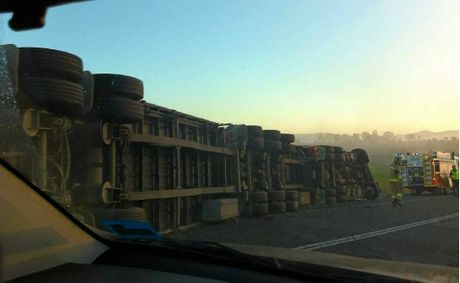 B-Double rollover on the Cunningham Hwy at Maryvale B-Double rollover on the Cunningham Hwy at Maryvale
.
<<The B-Double rollover on the Cunningham Hwy at Maryvale (north east of Warwick, south-eastern Queensland) on Saturday morning. One lane of the Cunningham Hwy was blocked at Maryvale from 6am Saturday until mid-afternoon after a B-Double rolled over. The truck was carrying general freight, including small motors and bags of grain.
A Warwick police spokesman said it was believed the rear trailer started to wobble which resulted in the whole vehicle turning over on one lane of the highway…Police said there was extensive damage to the prime mover.
There was also a single vehicle rollover at Pyramid’s Rd, Stanthorpe, at 12.45pm Saturday. No one was injured.
.
[Source: ‘B-double Rollover causes highway traffic delays’, 20130318, ^http://www.warwickdailynews.com.au/news/b-double-rollover-causes-highway-traffic-delays/1795182/]
.
Feb 2013: Truck fire in Sydney Harbour Tunnel
.
<<Motorists are experiencing extensive peak hour delays following a truck fire in the Sydney Harbour Tunnel. The fire started in the truck’s battery compartment, but the cause is still to be determined.
Traffic is banked up at both ends of the tunnel after a freightliner in the southbound lane caught on fire just after 4pm on Wednesday, activating a fire alarm and causing the closure of the tunnel.
A Transport Management Centre spokeswoman says motorists in the area are being diverted onto the Sydney Harbour Bridge, but there are extensive delays for northbound and southbound traffic. Emergency services are on site, and there is no forecast for when the tunnel will reopen.>>
.
[Source: ‘Truck fire closes Sydney Harbour Tunnel’, 20130220, by AAP, ^http://www.news.com.au/breaking-news/national/truck-fire-closes-sydney-harbour-tunnel/story-e6frfku9-1226582150849]
.
Oct 2012: Multiple truck crash on Sydney’s M4
.
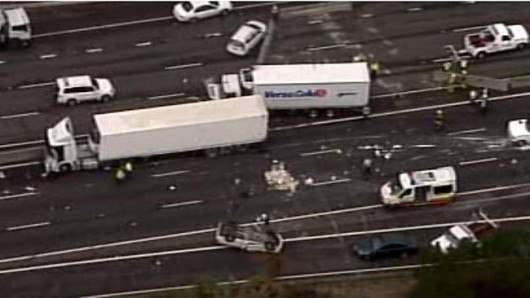 A crash on the M4 freeway closed both lanes of traffic
[Source: Picture by Gregg Porteous, The Daily Telegraph] A crash on the M4 freeway closed both lanes of traffic
[Source: Picture by Gregg Porteous, The Daily Telegraph]
.
<<A multi-vehicle pile up on the M4 has closed the motorway in both directions. At least five vehicles, including two trucks collided near the intersection with Silverwater Rd about 1.15pm. …The accident left one ute on its roof, while two trucks hit the concrete median barrier pushing sections into the path of oncoming traffic.
Meanwhile, Sydney’s traffic woes have worsened with a broken down truck closing down the westbound tunnel of the M5 East. The tunnel was shut shortly after 2pm, with tow trucks enroute to clear the vehicle. But to make matters worse the usual detour route around the tunnel is also shut in both directions after a truck brought down powerlines on Stoney Creek Rd near the intersection of Mimosa St, Bexley.
.
[Source: ‘Major accident on M4 near Silverwater Road causes traffic delays’, 20121011, by Henry Budd, The Daily Telegraph newspaper, ^http://www.dailytelegraph.com.au/news/nsw/major-accident-on-m4-near-silverwater-road-causes-traffic-delays/story-fnb5f12x-1226493579913]
.
April 2012: Truck on Fire on Hume Highway
.
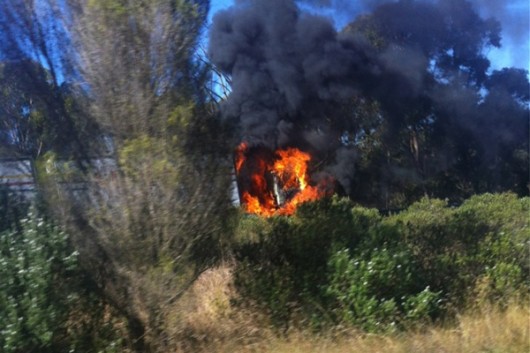 Truck on Fire on Hume Highway, near Yerrinbool Truck on Fire on Hume Highway, near Yerrinbool
Photo by Petrina Price
.
<<There are major delays for motorists on the Hume Hwy near Yerrinbool after a truck burst into flames this morning… just after 9.40am near Remembrance Drive.One of two southbound lanes is closed and traffic is queued for about 4.5km. Motorists are advised to avoid the area if possible.>>
.
[Source: ‘Yerrinbool: Hume Hwy delays after truck fire’, 20120412, Illawarra Mercury newspaper, ^http://www.illawarramercury.com.au/story/112596/yerrinbool-hume-hwy-delays-after-truck-fire/]
.
Dec 2011: Rollover of B-Double carting wool
.
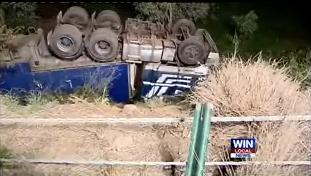 B-Double Rolled on Ballimore Highway near Dubbo B-Double Rolled on Ballimore Highway near Dubbo
.
<<There was a B-Double truck rollover east of Ballimore on the Golden Highway. The truck was carrying a full load of wool.>>
.
[Source: ‘Ballimore B-Double rollover’, 20111210, Win News, ^http://www.orana.rfs.nsw.gov.au/file_system/attachments/Orana/Attachment_20111210_6B7E3C94.wmv]
Sep 2010: Truck collision closes Hume Highway
.
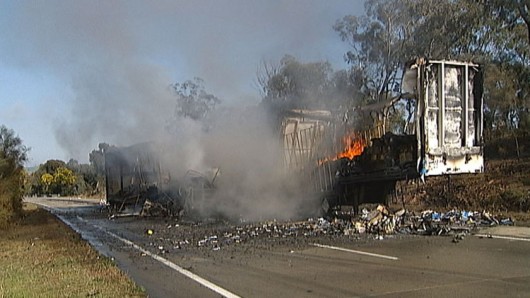 Fire erupted in the trailers of the two trucks after they crashed on the Hume Highway near Yass
[Photo by ABC News] Fire erupted in the trailers of the two trucks after they crashed on the Hume Highway near Yass
[Photo by ABC News]
.
<<Northbound lanes of the Hume Highway north of Canberra remain closed after a fiery crash between two trucks. Fire erupted in the trailers of the vehicles after they collided about 10 kilometres from Yass just after 4:00am.
One of the truck drivers aged in his 50s suffered minor injuries and was taken to hospital. Firefighters had difficulty extinguishing a blaze in the paper cargo of one of the trucks.>>
.
[Source: ‘Truck collision closes Hume Highway’, 20100924, ABC News, ^http://www.abc.net.au/news/stories/2010/09/24/3020651.htm?site=canberra]
.
Mar 2009: B-Double drags pedestrian 100 metres in hit-run
.
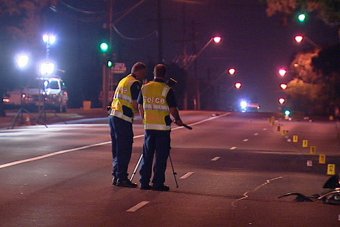 Police gather evidence after a pedestrian was killed in a hit-run in Reservoir (Melbourne) Police gather evidence after a pedestrian was killed in a hit-run in Reservoir (Melbourne)
.
<<Police say a female pedestrian was dragged 100 metres down the road in a fatal hit-and-run at Reservoir, in Melbourne’s north.
Police are questioning a 45-year-old man about the woman’s death, at the intersection of High Street and Broadhurst Avenue, about 10:30pm yesterday. The man was arrested at Epping early this morning.
Police say the B-Double prime mover and trailer stopped briefly after the collision, then took off. Sergeant Brendan Butland says the woman died at the scene.
“What’s occurred is tragic,” he said. “A lady was obviously standing on the street corner when the truck’s turned left. She’s been struck by the truck and has been dragged a hundred metres or so down the road, and it’s just tragic.”
The B-Double is now under police guard.>>
.
[Source: ‘B-double drags pedestrian 100 metres in hit-run’, 20090311, ^http://www.abc.net.au/news/2009-03-11/b-double-drags-pedestrian-100-metres-in-hit-run/1614926]
.
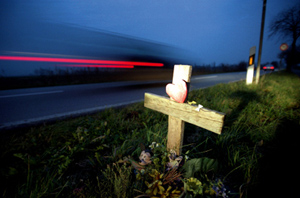 . .
Further Reading:
.
.
.
.
Footnote
.
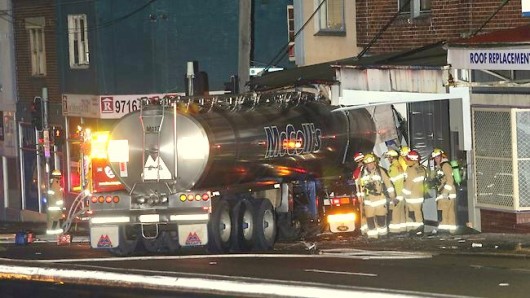 McColl’s Milk Tanker slams at speed into a Parramatta Road cafe on the corner of Croydon Road, Croydon McColl’s Milk Tanker slams at speed into a Parramatta Road cafe on the corner of Croydon Road, Croydon
.
We didn’t have to wait long. Close to midnight last night, an out-of-control fully-laden milk tanker heading into Sydney along Parramatta Road, crossed over the centre concrete medium stip and slammed into a cafe, where residents were sleeping above. The prime mover then caught fire as it was wedged inside the cafe.
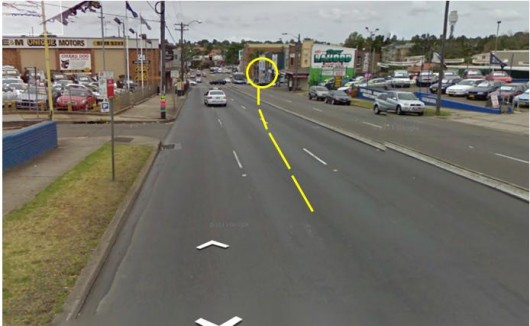 Milk Truck approach on eastbound side of Parramatta Road toward the Croydon Road intersection. Looking east along Parramatta Road toward the Croydon Road cafe (circled)
.
More lanes and more trucks are making our highways more dangerous.
[Image construct via Google Maps, before the crash] Milk Truck approach on eastbound side of Parramatta Road toward the Croydon Road intersection. Looking east along Parramatta Road toward the Croydon Road cafe (circled)
.
More lanes and more trucks are making our highways more dangerous.
[Image construct via Google Maps, before the crash]
.
The driver was probably on a linehaul service from Central West New South Wales delivering a milk load to Parmalat’s manufacturing plant at Lidcombe. The driver died on impact. Did he fall asleep like the Finemore’s driver driving through Medlow Bath around midnight on Sunday 12 May? (see lead post above).
It is yet another serious truck crash along the Great Western Highway corridor involving a trucking company based in Orange. In this case, McColl’s Milk Transport operates out of Orange at 8 Barret Street.
Did the 63 year old driver have a heart attack or stroke? How fit are these truck drivers? How often are they medically tested to operate such killing machines on our highways?
The RTA-come-RMS lets anyone get a truck licence these days. It Heavy Vehicle Competency Based Assessment programme is a joke.
The out of control truck hurtling on the wrong side of a six-laned Parramatta Road could have caused a head-on collision and killed many others, including the owners of the cafe. As it was, the main Sydney arterial Parramatta Road was closed in both directions for hours causing major delays during the busy Friday morning peak.
A year ago, a McColl’s B-Double milk truck collided with a Countrylink bus along on the Gwyder Highway halfway between Grafton and Glen Innes. It was about 3:30 pm, also on a Friday, on 10th February 2012. The Countrylink bus driver was killed and his passengers received minor injuries..
 B-Double McColl’s milk truck over the double lines kills Countrylink bus driver on the Gwyder Highway in February 2012.
[Source: Photo by Debrah Novak, The Daily Examiner, from article ‘Fatal crash on Gwydir’, 20120210, Coffs Coast Advocate, ^http://www.coffscoastadvocate.com.au/news/fatal-bus-and-truck-accident/1267856/] B-Double McColl’s milk truck over the double lines kills Countrylink bus driver on the Gwyder Highway in February 2012.
[Source: Photo by Debrah Novak, The Daily Examiner, from article ‘Fatal crash on Gwydir’, 20120210, Coffs Coast Advocate, ^http://www.coffscoastadvocate.com.au/news/fatal-bus-and-truck-accident/1267856/]
These B-Doubles are too big and too dangerous
.
[Sources: ‘Man dies in Croydon milk truck crash’, 20130524, ^http://www.skynews.com.au/national/article.aspx?id=874647]; and ‘Fatal crash on Gwydir’, 20120210, Coffs Coast Advocate, ^http://www.coffscoastadvocate.com.au/news/fatal-bus-and-truck-accident/1267856/]
.
.
The Trucking Menace is out of control!
.
Tags: B-Double Cattle Truck, B-double crashes, B-Double Menace, b-doubles, B-Doubles Out of Control, Blue Mountains, corporate trucking lobbyist, crash involving truck, dangerous trucks, Driver Fatigue, Great Western Highway, Great Western Highway development, head-on collision, Killer B-Double Cowboys, Orange, RMS, RTA, RTA-come-RMS, Speeding B-Double, The Road as a Workplace, Truck catches Fire, truck crash, truck driver occupational health and safety, truck overturns, trucking expressway
Posted in Blue Mountains (AU), Threats from Road Making | No Comments »
Add this post to Del.icio.us - Digg
Monday, May 20th, 2013
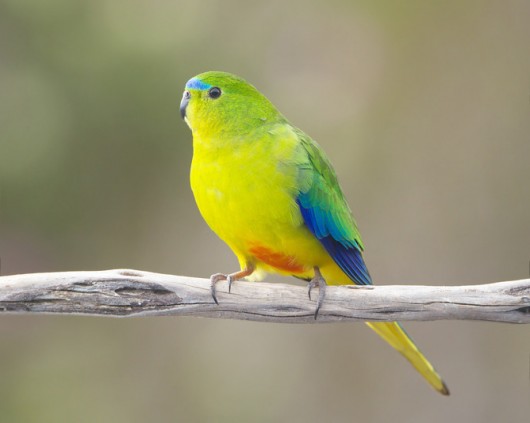 Orange-Bellied Parrot (Neophema chrysogaster)
Critically endangered and breeds only in Tasmania, Australia
[Source: Photo by John Harrison, in article ‘Threat of extinction demands fast and decisive action’, 20120724, by Tara Martin, published in The Conversation,
^http://theconversation.com/threat-of-extinction-demands-fast-and-decisive-action-7985] Orange-Bellied Parrot (Neophema chrysogaster)
Critically endangered and breeds only in Tasmania, Australia
[Source: Photo by John Harrison, in article ‘Threat of extinction demands fast and decisive action’, 20120724, by Tara Martin, published in The Conversation,
^http://theconversation.com/threat-of-extinction-demands-fast-and-decisive-action-7985]
.
Government Ecological Hypocrisy
.
While Australia’s governments at federal and state level continue to allow and encourage logging, burning and mining of Australia’s native forest ecosystems, many conservationists are well aware of that the loss of these forests habitats, and other human harmful actions are driving the extinction of Australia’s flora and fauna.
Threatened species can only be saved from extinction if first their habitat is properly protected from harm. Many species such as the Orange-Bellied Parrot which has now become critically endangered require more than just habitat protection, but active recovery intervention to save it from extinction. Yet this parrot species’ native habitats restricted to southern coastal Victoria and Tasmania are actively being destroyed as if government were sadistically and callously encouraging its extinction.
In governments we trust. Yet infamously in July 2009, the man who used to belt out “And the company takes what the company wants/And nothing’s as precious as a hole in the ground”, Midnight Oil’s Peter Garrett, as then entrusted Environment Minister, approved the Beverley Four Mile Uranium Mine in South Australia.
[Source: ‘Why Peter Garrett lost his way’, August, 2009, by David Glanz ^http://www.solidarity.net.au/best/why-peter-garrett-lost-his-way/]
.
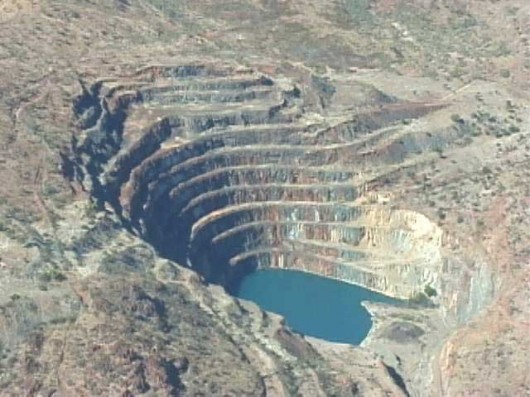 Beverley Four Mile Uranium Mine
550km north east of Adelaide Beverley Four Mile Uranium Mine
550km north east of Adelaide
.
At the most senior level, the Australian Government minister who is ultimately responsible and accountable to protect Australia’s natural ecology and to prevent flora and fauna extinctions, has his environment task diluted. Tony Burke MP is currently the Minister for (1) Sustainability (2) Environment (3) Water (4) Population (5) Communities (6) the Arts, which reflects the low value that the Australian Government places on protecting Australia’s Ecology.
 Australia’s recent Environment Ministers, respectively Peter Garrett and Tony Burke
Both Babyboomer Middle-Aged Men
Invariably in business, in politics, Babyboomer Middle-Aged Men
are the demographic drivers of ecological destruction across the planet. Australia’s recent Environment Ministers, respectively Peter Garrett and Tony Burke
Both Babyboomer Middle-Aged Men
Invariably in business, in politics, Babyboomer Middle-Aged Men
are the demographic drivers of ecological destruction across the planet.
.
Tony Burke has recently approved open coal mining that will destroy the Leard State Forest in New South Wales, remnant home of the increasingly rare Koala [^Read More].
Tony Burke has approved mining in Tasmania’s Tarkine (the last continuous wilderness region of Gondwana Rainforest home to more than 60 species of rare, threatened and endangered species including the Giant Freshwater Lobster, the Wedge Tailed Eagle, the Tasmanian Devil and the Orange-bellied Parrot [^Read More].
Tony Burke has recently approved logging to continue in recognised high conservation value native forests in Tasmania, previously agreed to be protected in an Intergovernmental Agreement between the federal and Tasmanian governments in Launceston on 7th August 2011 [^Read More].
Tony Burke has recently approved port development and shipping movements through the Great Barrier Reef for Rio Tintos’ bauxite mine in western Cape York, as well as a huge new coal export terminal at Abbot Point and at dredging of Gladstone Harbour despite the ongoing damage vital marine habitat supporting endangered species including turtles, dugongs and dolphins. [^Read More]
.
“For the powerful, crimes are those that others commit.”
~ Noam Chomsky, Imperial Ambitions: Conversations on the Post-9/11 World
.
 The 100 tonne coal ship the ‘Shen Neng 1’ which went aground on 5th April 2010, while negotiating the Great Barrier Reef
The ship destroyed 3km of the coral Douglas Shoal which it “completely flattened” and “pulverised” marine life. The marine park authority’s chief scientist, Dr David Wachenfeld, expressed concerned also about the toxic heavy metal anti-fouling paint scraping off the hull.
[Source: ‘Three kilometres of Great Barrier Reef damage, 20 years to mend’, 20100414, by Tom Arup, The Age newspaper,
^http://www.theage.com.au/environment/three-kilometres-of-great-barrier-reef-damage-20-years-to-mend-20100413-s7p8.html] The 100 tonne coal ship the ‘Shen Neng 1’ which went aground on 5th April 2010, while negotiating the Great Barrier Reef
The ship destroyed 3km of the coral Douglas Shoal which it “completely flattened” and “pulverised” marine life. The marine park authority’s chief scientist, Dr David Wachenfeld, expressed concerned also about the toxic heavy metal anti-fouling paint scraping off the hull.
[Source: ‘Three kilometres of Great Barrier Reef damage, 20 years to mend’, 20100414, by Tom Arup, The Age newspaper,
^http://www.theage.com.au/environment/three-kilometres-of-great-barrier-reef-damage-20-years-to-mend-20100413-s7p8.html]
.
Threatened Species Scientific Committee
– a toothless agency abused for ecopolitical spin
.
Then, at a lower level of government, a committee has been established since 2000 to advise Australia’s Environment Minister on issues associated with Australia’s increasing list of threatened species.
The Threatened Species Scientific Committee (TSSC) is legally established for under the Environment Protection and Biodiversity Conservation Act 1999 (EPBC Act), which superseded the 1992 Endangered Species Protection Act. The committee’s function is to advise the Minister for Sustainability, Environment, Water, Population and Communities (currentky Tony Burke MP) on:
- Amendments and updating of threatened species and threatened ecological communities lists
- Key Threatening Processes
- Preparing Species Recovery Plans and Threat Abatement Plans
- Scientific input into the Species Profile and Threats Database (^SPRAT)
- Advice on the presence of hybrids in listed ecological communities
- Hold periodic workshops dealing with issues concerning Australia’s threatened species and threatened ecosystems
.
Every year the committee publishes an annual report, except it has been six years since the Australian Government published one on its website. Here is the latest report from 2006-07. [>Read 2006-07 Report.pdf , 40kb) ]
.
[Source: ‘Threatened Species Scientific Committee’, ^http://www.environment.gov.au/biodiversity/threatened/committee.html]
.
Australia’s Threatened Fauna
.
As at the date of this article, the Australian Government lists the following statistics as our native fauna currently threatened with extinction to varying degrees, or now extinct.
Beware that government websites can change with whim and so the existence of the link below may disappear at any time.
.
Extinct:
- frogs (4)
- birds (23)
- mammals (27)
- other animals (1)
.
Extinct in the wild:
.
Critically Endangered:
- fishes (6)
- frogs (5)
- reptiles (4)
- birds (7)
- mammals (4)
- other animals (21)
.
Endangered:
- fishes (16)
- frogs (14)
- reptiles (16)
- birds (44)
- mammals (35)
- other animals (17)
.
Vulnerable:
- fishes (24)
- frogs (10)
- reptiles (36)
- birds (60)
- mammals (55)
- other animals (11)
.
Conservation dependent:
.
Total Threatened Fauna Species: (445)
.
[Source: Australia’s Threatened Flora, 2013, ^http://www.environment.gov.au/cgi-bin/sprat/public/publicthreatenedlist.pl]
.
Australia’s Critically Endangered Mammals
.
The above list is out of date, and the International Union for Conservation of Nature (IUCN) records are also out of date, because of the lack of diligent timely monitoring efforts by the Australian Government, and tardiness by the Australian Government in updating pertinent threatened species information back to the IUCN. Basically the Australian Government simply doesn’t care enough about Australian Ecology and dependent species about to become extinct.
It is a dire situation disgracefully detestable and sad.
According to an article in The Conversation back in December 2012, in respect to Australian mammal fauna, there are not four species deemed to be critically endangered to extinction, but now twelve, as listed below. Some of these may well be extinct such as the Christmas Island Pipistrelle..
The plight and demise of these species is not new. The Australian Government and its committees, reviews, reports and laws have confirmed this for many years. More committees, reviews, reports and laws equates to unforgiveable avoidance of moral and legal responsibility by the incumbent Environment Minister, this man:
.
 Tony Burke – the only grey haired Babyboomer in this photo
His demographic is responsible for the worst destruction of ecology across the Planet,
because the Nature-compromising values of males in this generation were formed when Nature was still considered plenty and its exploitation a God-given gospel.
Tony Burke’s values are wrong, inappropriate and his powerful decisions irreversible. Tony Burke – the only grey haired Babyboomer in this photo
His demographic is responsible for the worst destruction of ecology across the Planet,
because the Nature-compromising values of males in this generation were formed when Nature was still considered plenty and its exploitation a God-given gospel.
Tony Burke’s values are wrong, inappropriate and his powerful decisions irreversible.
.
- Woylie (Bettongia penicillata) also known as the Brush-tailed Bettong, or Brush-tailed Rat Kangaroo; a small marsupial found from south-west Western Australia across southern Australia.
- Mountain Pygmy Possum (Burramys parvus) – this tiny possum occurs as three isolated, genetically distinct populations in the alps of Victoria and NSW.
- Christmas Island Shrew (Crocidura trichura) – endemic to Christmas Island and hasn’t been seen since 1985. It is possibly extinct.
- Northern Hairy-nosed Wombat (Lasiorhinus krefftii) – approximately 200 of these wombats remain; they are limited to Epping Forest National Park (Scientific), and a reintroduced population at the Richard Underwood Nature Refuge, in Queensland.
- Lesser Stick-nest Rat (Leporillus apicalis) – this central-Australian rodent is probably extinct, with no reliable sightings since 1970.
- Bramble Cay (Melomys Melomys rubicola) – limited to a small cay in the Torres Strait, this rodent has one of the most restricted distributions of any mammal species.
- Lord Howe Long-eared Bat (Nyctophilus howensis) – known only from a single skull found in 1972, but Lord Howe Islanders continue to report bat sightings.
- Christmas Island Pipistrelle (Pipistrellus murrayi) – while listed as critically endangered, it’s generally accepted this little bat is now extinct.
- Gilbert’s Potoroo (Potorous gilbertii) – only 40 or so of these rabbit-sized marsupials live in south-west Western Australia, but the population seems stable.
- Kangaroo Island Dunnart (Sminthopsis aitkeni) – this little hand-sized marsupial is restricted to a very small area of Kangaroo Island.
- Carpentarian Rock Rat (Zyzomys palatalis) – a rodent found in sandstone gorges in the Northern Territory, there are thought to be less than 2000 remaining.
- Central Rock Rat (Zyzomys pedunculatus) – this rodent is found only in the western MacDonnell Ranges in the Northern Territory.
.
[Source: ‘Australia’s critically endangered animal species’, 20121206, by Jane Rawson, The Conversation, ^http://theconversation.com/australias-critically-endangered-animal-species-11169]
.
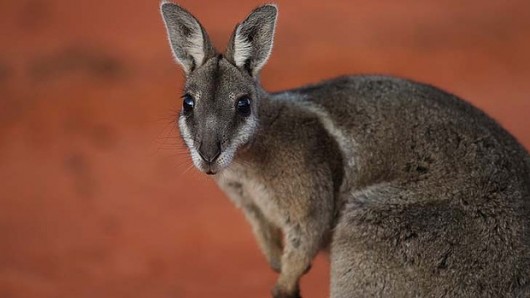 On the brink of extinction: the Bridled Nailtail Wallaby
[Source: Photo by Kate Geraghty, Dead and dying: our great mammal crisis’, 20121117, by Tim Flannery, The Age newspaper,
^http://www.theage.com.au/national/dead-and-dying-our-great-mammal-crisis-20121116-29hi9.html] On the brink of extinction: the Bridled Nailtail Wallaby
[Source: Photo by Kate Geraghty, Dead and dying: our great mammal crisis’, 20121117, by Tim Flannery, The Age newspaper,
^http://www.theage.com.au/national/dead-and-dying-our-great-mammal-crisis-20121116-29hi9.html]
.
Leadership, Accountability, Timely Action
.
According to Tara Martin, Research Scientist at Ecosystem Sciences at the CSIRO:
<<When it comes to mammal extinctions, Australia’s track record over the last 200 years has been abysmal. Since European settlement, nearly half of the world’s mammalian extinctions have occurred in Australia – 19 at last count. So, when faced with the additional threat of climate change, how do we turn this around and ensure the trend doesn’t continue?
Learning from previous extinctions is a good place to start. A comparison between two Australian species, the recently extinct Christmas Island pipistrelle and the critically endangered but surviving orange-bellied parrot, provides some insight into the answer to this question. Namely, that acting quickly and decisively in response to evidence of rapid population decline is a key factor in determining the fate of endangered species.
.
‘Government Delay condemn a species to extinction’
A Case of Government Delay:
.
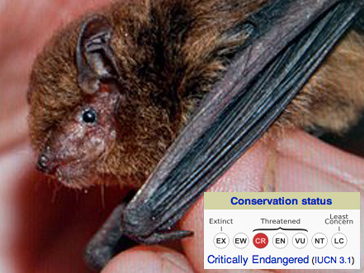 Species Extinction on Peter Garrett’s Watch
<< The Australian Government will invest $1.5 million to begin the rescue of Christmas Island’s ecosystem, including a mission to capture the last remaining Pipistrelle bats for captive breeding. “Volunteers and help from the Australasian Bat Society will be invaluable in this capture effort.” “My top priority now is to prevent any further extinctions and to restore the island’s environmental health,” Mr Garrett said.>>
A year later the critically endangered Christmas Island Pipistrelle (Pipistrellus murrayi) was declared extinct. Species Extinction on Peter Garrett’s Watch
<< The Australian Government will invest $1.5 million to begin the rescue of Christmas Island’s ecosystem, including a mission to capture the last remaining Pipistrelle bats for captive breeding. “Volunteers and help from the Australasian Bat Society will be invaluable in this capture effort.” “My top priority now is to prevent any further extinctions and to restore the island’s environmental health,” Mr Garrett said.>>
A year later the critically endangered Christmas Island Pipistrelle (Pipistrellus murrayi) was declared extinct.
[Source: ‘Christmas Island Pipistrelle Rescue’, 20090703, by Bat Conservation & Rescue Qld Inc., ^http://www.bats.org.au/?p=710]
.
<<Endemic to Christmas Island, the pipistrelle was a tiny (3.5 gram) insect-eating bat. It was first described in 1900, when numbers were widespread and abundant. In the early 1990s this began to change. The decline was rapid and the exact cause uncertain.
By 2006, experts were calling for a captive breeding program to be initiated. These pleas were ignored until 2009 when it was finally given the green light. Sadly the decision came too late, and two months (the then Minister for the Environment, Heritage and the Arts, Peter Garrett MP) announced that the rescue attempt had failed.>>
.
A Case of Government Action (so far):
.
<<Concern about the orange-bellied parrot began in 1917, but it wasn’t until 1981 that it was confirmed to be on the brink of extinction. In an attempt to save the parrot, a multi-agency, multi-government recovery team was set up and a captive breeding program began in 1983.
Like the bat, threats to the parrot remain poorly understood. In 2010, monitoring showed that the species would become extinct in the wild within three to five years unless drastic action was taken. The recovery team immediately took action to bolster the captive population as insurance against extinction. There are currently 178 birds in captivity and less than 20 in the wild.
.
<<…How we manage endangered species ultimately comes back to the decisions made, including who makes the decisions, who is held accountable, and the timing of these decisions.
Examining these cases in the context of decision-making reveals some clear differences and highlights some important recommendations for the future management of endangered species.
One of the key differences was in the governance and leadership surrounding the two cases. Experts involved in monitoring the pipistrelle provided recommendations to government bodies, but did not have the authority to make decisions nor was there an effective leader to champion the urgent need to act. Conversely, the Orange-bellied Parrot Recovery Team had the authority to make decisions and act on them. Indeed, thanks to the Recovery Team’s broad representation, any failure to act would likely have resulted in public outcry – which raises the issue of accountability.
Management of endangered species requires tough decisions, yet they are decisions we must make. If we monitor declining populations without a process for deciding between different management options, we will only document extinctions. In some cases, the logical decision may be to employ a triage system where priority is given to species with a high likelihood of recovery. Assigning institutional accountability around the management of endangered species could help to ensure that tough decisions are made and that the processes involved are transparent.
Finally, the cases of the bat and the parrot also highlight the need to act quickly when a species is found to be on the brink of extinction. Delaying decisions only narrows our choices and removes opportunities to act. We may not always have all the answers, but this cannot be used as a reason to delay decision making. Based on a triage system a decision to not to act might be the best way forward, but if we delay the decision it becomes the only way forward.
..scientific analysis can be used to determine how much information we need to inform a good conservation decision. In the case of the Christmas Island pipistrelle, the decision to start a captive breeding program came many years too late.
By evaluating the costs, benefits, and feasibility of taking different management actions in the light of what we know about a species’ decline (or don’t know – i.e. the degree of uncertainty), it is possible to get the timing right.
Research into the methods used to stem species decline is also underway. For example, captive breeding and reintroduction programs are generally regarded as having good success rates. Further investigation into genetic management, habitat restoration, and effective techniques for reintroduction and risk management will help ensure the success of these programs for a variety of species.
Stemming the global loss of biodiversity through Species Recovery Planning will require brave decision-making in the face of uncertainty. Monitoring must be linked to decisions, institutions must be accountable for these decisions and decisions to act must be made before critical opportunities, and species, are lost forever.>>
.
[Source: ‘Threat of extinction demands fast and decisive action’, 20120724, by Tara Martin, Research Scientist, Ecosystem Sciences at CSIRO, (based on a paper by Tara Martin and with input from co-authors Mark Holdsworth, Stephen Harris, Fiona Henderson, Mark Lonsdale, in The Conversation, ^http://theconversation.com/threat-of-extinction-demands-fast-and-decisive-action-7985]
.
.
Principles to Properly Protect Threatened Species
.
The Australian Government is accountable for the conservation of Australia’s natutral environment and dependent species, particularly those at risk of extinction. It is charged with the democratic authority to do so and the Australian people entrust it to act responsibly. The Australian Government since 1999 had in place a national law protecting threatened species under its Environment Protection and Biodiversity Conservation Act, and since 2000 had an expert Threatened Species Scientific Committee advising it on priorities for threatened species and key threatening processes and recommended conservation actions.
But having a framework for conservation action is two steps short of the conservation action itself. Without proper funding and timely onground action, government environmental conservation is but hypocritcal lip service.
.
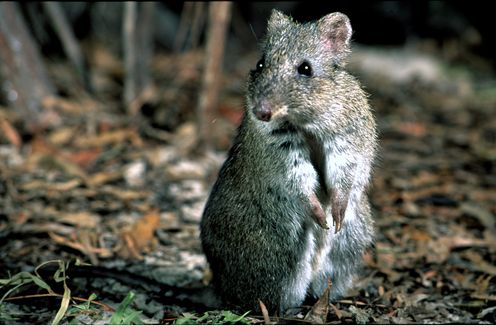 Gilbert’s Potoroo – only 40 left Gilbert’s Potoroo – only 40 left
.
2008 Review of Threatened Species Protection
.
Section 522A of the EPBC Act requires it to be reviewed every 10 years from its commencement. So on 31 October 2008, Peter Garrett MP as the then Minister for the Environment, Heritage and the Arts, commissioned an independent review of the Environment Protection and Biodiversity Conservation Act 1999 (EPBC Act), the Australian Government’s central piece of environmental legislation.
The Terms of Reference were:
- the operation of the EPBC Act generally
- the extent to which the objects of the EPBC Act have been achieved
- the appropriateness of current matters of National Environmental Significance
- the effectiveness of the biodiversity and wildlife conservation arrangements
- Seek input from state and territory governments, members of the community and industry
.
The review to be guided by key Australian Government policy objectives:
- To promote the sustainability of Australia’s economic development to enhance individual and community well-being while protecting biological diversity and maintaining essential ecological processes and systems
- To work in partnership with the states and territories within an effective federal arrangement
- To facilitate delivery of Australia’s international obligations
- The Australian Government’s deregulation agenda to reduce and simplify the regulatory burden on people, businesses and organisations, while maintaining appropriate and efficient environmental standards
- To ensure activities under the Act represent the most appropriate, efficient and effective ways of achieving the Government’s outcomes and objectives in accordance with the Expenditure Review Principles.
.
The review was undertaken by Dr Allan Hawke (government representative) supported by a panel of experts- a retired NSW judge Paul Stein AM, Professor Mark Burgman (Environmental Science), Professor Tim Bonyhady (Environmental Law), Rosemary Warnock (ethical standards and the environment).
Community participation in the review was encouraged and 220 written submissions were received and 140 face-to-face consultation meetings were held in capital cities around Australia. An Interim Report on the review was released and a further 119 written comments were received. The Final Report was delivered to the Minister on 30 October 2009 and publicly released on 21 December 2009.
On 24 August 2011, the Minister released the Australian Government response to the independent review, three years after the review process began and about a year after the ten year review deadline.
The response centred around four key themes:
- Abandonning targeted actions to save critically endangered threatened species, and instead to vague “strategic approaches” and more plans
- Simplification of the assessment and approval processes for threatened species – vague, cheaper and less research work
- Big picture ecosystem approach
- Compromise of national standards to “harmonise” conservation approaches with the States having different priorities
.
Irrespective of the 220 written submissions and 140 face-to-face consultation meetings, out of the 71 recommendations in the Final Report, the Australian Government agreed either in part, in principle, in substance, but has since done precious little to protect Australia’s threatened species.
The review process was stipluated in the EPBC Act, but all it achieved was an opportunity for the Australian Government to undermine the 1999 standards, water down national environmental protection legislation, simplify the government’s administration and save money. Effectively the EPBC Review was a bureacratic talk fest and an expensive waste of time and taxpayer money that would have been better spent on implementing known critically endengerd species and their habitats.
The survival of Australia’s threatened species remain at the whim of federal and state governments.
What did the entire review process cost including the consultants? The amount is secret. Was it $10 million, more? The estimated cost of a Species Recovery Plans and Threat Abatement Plan to save the critically endangered Orange-bellied Parrot is how much?
Meanwhile, as few as 250 Orange-bellied Parrots remain in existence, making the species one of the most endangered species on the planet.
Meanwhile, community volunteers with The Friends of the Orange-Bellied Parrot and Wildcare Inc. in Tasmania continue to monitor the Orange-bellied Parrots during their breeding season in far southwest Tasmania’s Wilderness World Heritage Area. Members live for periods of 10 days at Birch Inlet and Melaleuca in Tasmania’s Wilderness World Heritage Area, making observations of the daily lives of the OBPs, including birds that have been bred in captivity and released at the beginning of the season as part of the Species Recovery Plan for the Orange-Bellied Parrot.
They don’t get money from the Australian Government and so have set up the Save the Orange-bellied parrot Fund. Wildcare Inc volunteers receive a small reimbursement allowance from the Tasmanian Government’s watered down Department of (1) Primary Industries, (2) Parks, (3) Water and oh yeah (4) Environment to assist with their costs.
.
[Source: Wildcare Incorporated, Tasmania, ^http://www.wildcaretas.org.au/]
.
.
.
.
.
[Source: Australian Government, ^http://www.environment.gov.au/epbc/review/]
.
2012 Review of Threatened Species Protection
.
After the entire the EPBC Act Review process and a year after the Australian Government’s response to it, on 31 October 2012 the Australian Senate this time set up yet another review into the Effectiveness of Threatened Species and Ecological Communities’ Protection in Australia. It commissioned a Senate Standing Committee on Environment and Communications for enquiry and report.
This second review process came in light of the rubber stamp realisation by The Greens Senator Larissa Waters of how the Australian Government had poorly treated the EPBC Review and in light of the Auditor General report that Victoria’s environment and primary industry departments are failing to act as proper watchdogs [^Read More]. Further to that we’ve seen Professor Tim Flannery publish his opinion piece (from the Monthly’s Quarterly Essay) on the extinction crisis pointing some of the blame at the Commonwealth’s inaction [^Read More].
Public submissions were to be received by 14th December 2012 and the reporting date scheduled to be 7th February 2013, but rather late again on 14th May 2013, the Senate granted an extension of time for reporting until 20 June 2013 (one month’s time from the date of this article).
The Terms of Reference are:
(a) Management of key threats to listed species and ecological communities
(b) Development and implementation of Species Recovery Plans
[Ed: About time, and what about commensurate Threat Abatement Plans? One is ineffective without the other.]
(c) Management of critical habitat across all land tenures
(d) Regulatory and funding arrangements at all levels of government
(e) Timeliness and risk management within the listings processes
(f) The historical record of state and territory governments on these matters
(g) Any other related matter.
.
[Sources: ‘The effectiveness of threatened species and ecological communities’ protection in Australia’, Terms of Reference, Australian Senate,^http://www.aph.gov.au/Parliamentary_Business/Committees/Senate_Committees?url=ec_ctte/threatened_species/tor.htm; ‘Threatened species in the senate spotlight’, 20121121, Councillor Samantha Dunn, Shire of Yarra Ranges, Victoria, Australia (website), ^http://crdunn.blogspot.com.au/2012/11/threatened-species-in-senate-spotlight.html]
.
Public submissions received by the Senate Committee
.
1 Mr Gabriel Lafitte (PDF 39KB)
2 Dr Todd Soderquist and Dr Deborah Ashworth (PDF 41KB) Attachment 1(PDF 395KB)
3 Mr Marcus Coghlan (PDF 91KB)
4 Australasian Native Orchid Society and the Australian Orchid Council (PDF 309KB)
5 Ms Fay Jones (PDF 4KB)
6 Monaro Acclimatisation Society Inc (PDF 267KB)
7 Mr James Samargis (PDF 56KB)
8 Mr Stephen Chara (PDF 432KB), Supplementary Submission(PDF 1213KB)
9 Mr Sab Lord, Lords Kakadu and Arnhemland Safaris (PDF 9KB)
10 Ms Kylie Jones (PDF 43KB)
11 East Gippsland Wildfire Taskforce Inc (PDF 1483KB)
12 Regent Honeyeater Project (PDF 9KB) Attachment 1(PDF 2946KB)
13 Mr Rob Brewster (PDF 2063KB)
14 Mr Tom Kingston (PDF 16KB)
15 Professor David Lindenmayer (PDF 44KB)
16 Mr Frank Manthey OAM, Save the Bilby Fund (PDF 189KB), Supplementary Submission(PDF 1154KB)
17 Friends of Tootgarook Wetland Reserves (PDF 390KB)
18 Mr Jim Walker (PDF 193KB)
19 Ms Harriett Swift (PDF 34KB), Supplementary Submission(PDF 11KB)
20 Island Conservation (PDF 1011KB)
21 Wildflower Society of Western Australia (Inc) (PDF 161KB)
22 Mr Daniel Bell (PDF 11KB)
23 Marie-Louise Sarjeant, Chris Sarjeant, Sonia Hutchinson, John Marsh, Maxine Jacobsen, Diana Kellett, Lesley Palma (PDF 945KB)
24 Save Tootgarook Swamp Inc (PDF 1777KB)
25 Ms Joan Spittle (PDF 83KB)
26 Mr John Jeayes (PDF 431KB)
27 Zoo and Aquarium Association (PDF 57KB)
28 Ray and Marion Lewis (PDF 239KB)
29 Mr Jean Dind (PDF 32KB)
30 Associate Professor Adrian Manning (PDF 97KB) Attachment 1(PDF 370KB), Supplementary Submission(PDF 167KB)
31 Port Campbell Community Group Inc (PDF 152KB)
32 Mr Philip Collier (PDF 790KB)
33 Mr Trevor Parton (PDF 58KB)
34 Mr Ian Wheatland, Mr Kai May, Dr Katherine Phillips and Mrs Nina Kriegisch (PDF 126KB)
35 Ms Susan M Broman (PDF 890KB)
36 Sister Marian McClelland sss (PDF 29KB)
37 Finch Society of Australia Inc (PDF 65KB)
38 Clarence Valley Conservation Coalition (PDF 250KB)
39 Ms Mary White rsm (PDF 273KB)
40 Ms Marie Hilarina Fernando (PDF 103KB)
41 Dr Emma Rooksby and Dr Keith Horton (PDF 63KB)
42 Zoos Victoria (PDF 240KB)
43 The Colong Foundation for Wilderness (PDF 376KB)
44 Mr Stewart Kerr (PDF 5KB)
45 Mr Peter Berbee (PDF 24KB)
46 Dr Andrew Burbidge (PDF 69KB)
47 Name Withheld (PDF 45KB)
48 Professor John Woinarski (PDF 157KB)
49 Ms Lee Curtis (PDF 100KB)
50 Mr Thomas Weiss (PDF 36KB)
51 Dr Peter Kyne (PDF 387KB)
52 Dr Greg P Clancy (PDF 218KB)
53 Mr Trent Patten (PDF 1536KB)
54 Ms Sabine Ritz-Kerr (PDF 47KB)
55 Dr Martine Maron (PDF 196KB)
56 Ms Claire Masters (PDF 39KB)
57 The Wentworth Group of Concerned Scientists (PDF 2022KB)
58 Mr Jonathan Meddings (PDF 817KB)
59 Mr Nigel Sharp (PDF 329KB)
60 Assoc Prof Mark Lintermans (PDF 54KB)
61 Ms Pamela J W Miskin (PDF 66KB)
62 South East Forest Rescue (PDF 646KB)
63 Clarence Environment Centre (PDF 137KB)
64 Mr Craig Thomson (PDF 116KB)
65 Ms Peta Whitford (PDF 222KB)
66 Mr Daryl Dickson, Wildcard Art, Mungarru Lodge Sanctuary (PDF 269KB)
67 Ms Sera Blair (PDF 349KB)
68 Ms Kerryn Blackshaw (PDF 5KB)
69 Yarra Ranges Council (PDF 107KB)
70 Lawyers for Forests (PDF 1159KB)
71 Name Withheld (PDF 23KB)
72 Mr Greg Miles (PDF 157KB) Attachment 1(PDF 600KB) Attachment 2(PDF 4770KB)
73 Bendigo and District Environment Council, Bendigo Field Naturalists Club and Bendigo Sustainability Group (PDF 364KB) Attachment 1(PDF 173KB) Attachment 2(PDF 1923KB)
74 Dr Jasmyn Lynch (PDF 80KB)
75 Blue Mountains Conservation Society (PDF 202KB)
76 Wildlife Preservation Society of Queensland (PDF 246KB)
77 CSIRO (PDF 284KB)
78 Dr Chris McGrath (PDF 245KB)
79 Mr David Blair (PDF 195KB)
80 Name Withheld (PDF 183KB)
81 WWF-Australia (PDF 553KB) Attachment 1(PDF 378KB) Attachment 2(PDF 204KB)
82 BirdLife Australia (PDF 715KB) Attachment 1(PDF 1129KB)
83 Australian Deer Association (PDF 732KB)
84 LIV Young Lawyers’ Section, Law Institute of Victoria (PDF 1209KB) Attachment 1(PDF 4436KB) Attachment 2(PDF 1303KB), Supplementary Submission(PDF 335KB)
85 Stanislaw Pelczynski and Barbara Pelczynska (PDF 245KB)
86 Friends of Grasslands (PDF 100KB)
87 Dr Kerryn Parry-Jones (PDF 239KB) Attachment 1(PDF 2143KB)
88 Humane Society International (PDF 550KB)
89 Mr Jeremy Tager (PDF 1441KB), Supplementary Submission(PDF 185KB)
90 Ms Karena Goldfinch (PDF 141KB)
91 Mr Ray Strong (PDF 95KB)
92 Healesville Environment Watch Inc, MyEnvironment Inc and Friends of Leadbeater’s Possum Inc (PDF 2435KB)
93 Mr Ian Whitford (PDF 226KB)
94 Greenfleet (PDF 105KB)
95 Mr Barry Rowe, Candlebark Community Nursery Inc (PDF 178KB)
96 Conondale Range Committee (PDF 156KB)
97 Dr John Clulow (PDF 61KB)
98 Ms Melinda Taylor (PDF 73KB)
99 Mr David Hudson (PDF 78KB)
100 Ms Yasmin Kelsall (PDF 340KB)
101 S. Burgess and E. Bradley (PDF 61KB)
102 Ms Glenda Pickersgill (PDF 86KB)
103 Dr Tanzi Smith (PDF 249KB)
104 The Greater Mary Association Inc. (PDF 234KB)
105 Mr Philip Rance (PDF 651KB)
106 Caldera Environment Centre (PDF 416KB)
107 Mr Bruce Boyes (PDF 1505KB)
108 Australian Wildlife Health Network (PDF 418KB)
109 Friends of Hoddles Creek (PDF 1403KB)
110 Australasian Bat Society Inc (PDF 413KB)
111 Confidential
112 Confidential
113 Canberra Ornithologists Group (PDF 229KB)
114 Urban Bushland Council WA Inc (PDF 112KB)
115 MRCCC (PDF 559KB)
116 Threatened Ecosystems Network (PDF 1606KB)
117 Wildlife Disease Association Australasia (PDF 71KB)
118 Name Withheld (PDF 237KB)
119 Mr Andrew Heaver (PDF 126KB)
120 Name Withheld (PDF 76KB)
121 Ms Kate Leahy (PDF 35KB)
122 Dr Jonathan Rhodes (PDF 68KB)
123 Professor Lee Godden and Professor Jacqueline Peel (PDF 136KB) Attachment 1(PDF 123KB) Attachment 2(PDF 327KB)
124 Earth Learning Incorporated (PDF 352KB)
125 NSW Council of Freshwater Anglers (PDF 671KB)
126 Mr Mark Selmes (PDF 141KB)
127 Professor Hugh Possingham and Associate Professor Michael McCarthy (PDF 102KB)
128 Ms Susan Bendel (PDF 99KB)
129 The Wilderness Society Inc (PDF 68KB)
130 Minister for Environment and Heritage Protection Queensland (PDF 3463KB)
131 Ms Lorraine Leach (PDF 293KB)
132 Dr John Bardsley (PDF 1070KB)
133 Mr Wayne Gumley (PDF 144KB)
134 Nature Conservation Council of NSW (PDF 783KB)
135 Middle Kinglake Primary School (PDF 2301KB)
136 The Judith Eardley Save Wildlife Centre (PDF 1595KB)
137 Australian Network of Environmental Defender’s Offices Inc (PDF 214KB) Attachment 1(PDF 1129KB)
138 Ms Jenifer Johnson (PDF 1917KB)
139 Batwatch Australia (PDF 270KB)
140 Invasive Species Council (PDF 421KB)
141 Dr Rupert Baker (PDF 50KB)
142 National Parks Australia Council (PDF 331KB) Attachment 1(PDF 734KB) Attachment 2(PDF 3164KB)
143 Department of Sustainability Environment Water Population and Communities (PDF 1098KB)
144 Director of National Parks (PDF 249KB)
145 National Parks Association of NSW (PDF 196KB)
146 Mr Don Butcher (PDF 694KB)
147 Australian Conservation Foundation (PDF 725KB) Attachment 1(PDF 1129KB)
148 Australian Fisheries Management Authority (PDF 638KB)
149 Environment East Gippsland Inc. (PDF 2834KB)
150 Nature Conservation Society of South Australia (PDF 196KB)
151 Arid Lands Environment Centre (PDF 182KB)
152 Ms Prue Acton (PDF 394KB)
153 Ms Bronwyn Baade (PDF 55KB)
154 Threatened Species Scientific Committee (PDF 255KB)
155 VETO (VETO Energex Towers Organisation) (PDF 1695KB) Attachment 1(PDF 199KB)
156 Gecko – Gold Coast and Hinterland Environment Council and Save Bahrs Scrub Alliance (PDF 508KB) Attachment 1(PDF 569KB)
157 Threatened Plant Action Group (TPAG), Nature Conservation Society of South Australia (PDF 332KB)
158 FrogWatch (PDF 121KB)
159 Department of Land Resource Management, Northern Territory Government (PDF 8000KB)
160 Wildlife Preservation Society of Queensland, Gold Coast and Hinterland Branch (PDF 202KB)
161 North Coast Environment Council (PDF 594KB) Attachment 1(PDF 3788KB) Attachment 2(PDF 1914KB)
162 Australian Wildlife Conservancy (PDF 400KB) Attachment 1(PDF 637KB) Attachment 2(PDF 433KB)
163 MyEnvironment Inc (PDF 6137KB)
164 South East Region Conservation Alliance Inc (PDF 3514KB)
165 Logan and Albert Conservation Association (PDF 306KB) Attachment 1(PDF 197KB) Attachment 2(PDF 147KB)
166 PGV Environmental (PDF 916KB)
167 National Farmers’ Federation (PDF 61KB)
168 Wide Bay Burnett Enviroment Council (PDF 1311KB)
169 Premier of Western Australia (PDF 14211KB)
170 Confidential
171 Confidential
172 The Wilderness Society Victoria Inc (PDF 1182KB), Response from VicForests, dated 29 January 2013(PDF 78KB)
173 Brisbane Region Environment Council (PDF 965KB)
174 North East Forest Alliance (PDF 2272KB), Response from Forestry Corporation, NSW(PDF 2036KB)
175 Eagle Junction State School (PDF 12260KB)
176 Hunter Bird Observers Club (PDF 387KB)
177 Ms Margaret Peachey (PDF 63KB)
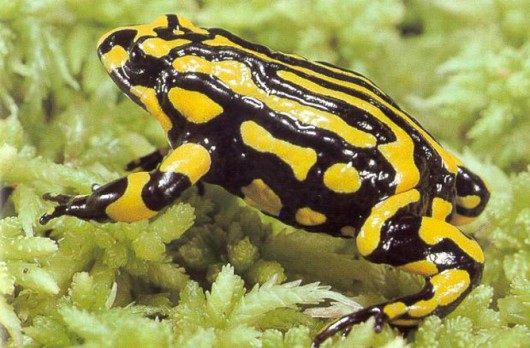 Southern Corroborree Frog (Pseudophryne corroboree)
Endemic to yet critically endangered in the Australian Alps. Southern Corroborree Frog (Pseudophryne corroboree)
Endemic to yet critically endangered in the Australian Alps.
Its demise has been directly caused by habitat destruction from recreational 4WD use, development of ski resorts,
introduced feral animals and human degradation of the frogs’ habitat.
As of June 2004 it was estimated to have a population of just 64.
.
Submission #82 by BirdLife Australia
.
Australia’s leading independent conservation advocate for native birds and their habitats, BirdLife Australia, has its own Threatened Species Committee. In its submission to the review, BirdLife Australia called on Australia’s national environment law, the EPBC Act, to:
.
-
Be accountable
-
Be transparent
-
Deliver on our international commitments
-
Specify measurable ecological outcomes
-
Have a mandate to intervene on matters that are national in scope
-
Be resourced and enforced
-
Give the Australian Community a voice on national environmental matters
-
Be based on independent advice
.
Specifically these were its recommendations in detail:
.
Be accountable
.
a. The Act should require that national environmental accounts are developed (Recommendation 67), produced annually, and include Matters of National Environmental Significance (MNES). Within this the IUCN Red List Index could be used to provide a measure of performance in the threatened species protection and management.
b. The Act should establish an Independent Environment Commission to provide objective, science-based advice to the Minister to improve decision-making and ensure greater transparency and accountability (Recommendation 71). The Commission should be responsible for independent monitoring, audit, compliance and enforcement activities under the Act.
c. The Act should prescribe mandatory decision-making criteria for ecological outcomes (Recommendation 43). All actions should be legally required to maintain or improve ecological outcomes, or to demonstrate a net improvement in national environmental accounts (for each relevant MNES).
d. Regional Forest Agreements require an independent review and a more rigorous approach to auditing. A process for public input and sanctions for serious non-compliance are required. The full protections of the Act should apply to forest activities where the terms of the RFAs are not being met (Recommendation 38).
.
Be transparent
.
a. Transparency in decision-making must be maintained and improved. Current proposals do not go far enough, for example statements of reasons for all decisions made by the Minister and delegates under the Act should be released at time of the decision (Recommendation 44(1)(c)).
b. The Act must provide greater access to the courts for public interest litigation. The Government’s Rejection of Recommendations 48-53 is a key failure of the Government’s response to provide suitable checks and balances for proposals to “streamline” processes.
c. A core element of Hawke’s reform package was to provide for environmental performance audits and inquiries. The Australian Government should be subject to regular environmental performance audit under a new specialist Environmental Performance Audit Unit in the Australian National Audit Office, provided for under the Auditor-General Act 1997.
.
Deliver on our international commitments
.
a. Critical habitat must be protected, with impacts on critical habitat equated to impact on species, and consideration given to the critical habitat required under climate change (Recommendation 12 (1)). However we feel that the critical habitat register should be retained and its remit expanded.
b. The Environment Minister requires powers to develop and implement management plans to protect the values of World Heritage properties, National Heritage Places and Ramsar wetlands where the collaborative processes have not produced effective plans (Recommendation 34).
.
Specify measurable ecological outcomes
.
a. The Act should specify required ecological outcomes. This could be delivered through specified reporting periods for MNES, such as on Species Recovery Plans and Threat Abatement Plans to ensure accountability. The Government agreed the Act should include provisions that enable the auditing of environmental outcomes (performance audits) (Recommendation 61).
.
Have a mandate to intervene on matters that are national in scope
.
a. The primary object of the Act should be ‘to protect the environment’ (Recommendation 3).
b. The Act, and the way it is administered, needs to better reflect the principles of Ecological Sustainable Development (Recommendation 2).
c. The process proposed in the Government response for listing ecosystems of national significance under the Act is too restrictive and inflexible.
d. The National Reserve System should be included as a MNES.
.
Be resourced and enforced
.
a. Cost recovery mechanisms under the Act are needed to ensure that the Environment Department is adequately resourced to ensure operation of the Act and monitor performance (Recommendation 62).
b. A Reparation fund should be established (Recommendation 60). Give the Australian Community a voice on national environmental matters
a. We strongly support the creation of a call in power for ‘plans, policies and programs’ that may have a significant impact on a MNES to better deal with cumulative impacts.
.
Be based on independent advice
a. The quality of Environmental Impact Assessment (EIA) information needs to be substantially improved. An industry Code of Conduct for consultants supplying information for EIA and approval under the Act should be developed and the Minister, or the Environment Commission, should audit assessment information (including protected matters) to test assertions made in EIAs (Recommendation 24).
b. The Environment Commission should also be tasked with establishing a process to free consultants from their commercial dependency on proponents.
.
[Source: ‘Submission to the Australian Senate Standing Committees on Environment and Communications entitled ‘The effectiveness of threatened species and ecological communities’ protection in Australia’, 20130308, by Professor Stephen Garnett(Coordinator – BirdLife Australia’s Threatened Species Committee) and Samantha Vine (Head of Conservation – BirdLife Australia, ^http://birdlife.org.au/].
.
 Margaret River burrowing crayfish (Engaewa pseudoreducta)
[© Photo by Quinton Burham]
With only two known populations, the Margaret River burrowing crayfish is highly endangered.
Even one of these may no longer exist, as there have been no sightings since 1985.
The threats are almost all attributed to human activity.
Land clearing is the biggest danger, as crayfish habitat can be eroded or contaminated by farming, mining and urban development.
Feral pigs also damage habitat.
[Source: ^http://www.australiangeographic.com.au/journal/australias-most-endangered-species.htm] Margaret River burrowing crayfish (Engaewa pseudoreducta)
[© Photo by Quinton Burham]
With only two known populations, the Margaret River burrowing crayfish is highly endangered.
Even one of these may no longer exist, as there have been no sightings since 1985.
The threats are almost all attributed to human activity.
Land clearing is the biggest danger, as crayfish habitat can be eroded or contaminated by farming, mining and urban development.
Feral pigs also damage habitat.
[Source: ^http://www.australiangeographic.com.au/journal/australias-most-endangered-species.htm]
.
Submission #85 by our regular contributors
.
<<We acknowledge the Indigenous Nations of Australia as the traditional owners of its land and waters. We thank them for the ecological wisdom they did and continue to pass to us.
We have read and agree with the contents of the two submissions to the Committee from Marie-Louise Sarjeant, Chris Sarjeant, Sonia Hutchinson, John Marsh and Maxine Jacobson, and from Wendy Radford for BDEC, Stuart Fraser for BFNC and Sara Hill and wish to take this opportunity to register with the Committee our endorsement of them.
.
Introduction
.
<<When about 50 years ago we became involved in environmental issues, we never thought that we will be witnessing in our lifetime the degree of environmental degradation we are witnessing now.
The rate at which the degradation is now occurring is very alarming, as given that global warming and loss of biodiversity exacerbate each other, there is a real possibility that unless we act now, this positive feedback cycle will escalate beyond our ability to prevent it from resulting in the collapse of our life supporting natural ecosystems.
Over the last 20 years that we lived on a property in the forest near Bendigo we personally witnessed the progressive local extinction of the swamp wallaby due to road kills, loss of habitat to development, degradation of the Greater National Park due to fuel reduction burns and weed infestation, including invasive plants escaping from ornamental gardens, replacement of native trees in Bendigo’s streetscapes with exotics and escalation of a thriving population of Indian mynas – and all this, in spite of the biodiversity strategies, environmental protection legislations and scores of submissions, Panel and VCAT hearings.
Why is it then that we are failing to provide effective protection to our biodiversity?
In this submission we will list some of the reasons for this failure.
.
Evidence of the ineffectiveness of threatened species and ecological communities’ protection in Australia
.
The ineffectiveness of threatened species and ecological communities’ protection is evident from the Natural Heritage Trust’s “Australian Terrestrial Biodiversity Assessment 2002” report and from the successive “State of the Environment” reports which show that all the important environmental indicators are getting worse.
The reasons for this ineffectiveness is:
.
Promotion of populations growth
.
Concerns about the unsustainability of population growth and its impact on the natural environment is very well documented (Bartlett 1998, Catton 1982, Lowe 2005, p 59, Suzuki2010, pp 20 and 21) and yet population growth continues to be supported and promoted by politicians (Creighton 2012) and business, while the wide spread misconceptions about it still persist without effective challenge (Lowe 2012).
.
We submit that the Committee recommends that an ecological limit to population growth is determined and implemented into our policy and decision processes
.
Failure to recognize the role apex, or top-order, predators play in the conservation of Australia’s biodiversity
.
The failure by Euro-Australians to recognize the apex terrestrial predators function in sustaining a balance of species that is viable in the long term and in keeping the numbers down of introduced feral species, has and continues to contribute to the decline of Australia’s biodiversity and adversely affects the effectiveness of threatened species and ecological communities protection.
In the case of the avian apex predator, the Wedge-tail Eagle (Aquila audax), the recognition and acceptance of its value to the environment and to farmers took number of years after CSRIO published its research results in the second half of last century.
Unfortunately, in the case of the mammalian apex predator, the dingo (Canis lupus dingo), until recent years “dingoes have rarely been studied to reach a larger understanding of our place in the Australian environment. Dingoes have mainly been studied so humans can maximize the efficacy of control efforts, capitalize on available resources and increase short-term economic gain” (Purcell 2010, p. 117), with the obvious consequent enforcement of people’s misconceptions and detrimental treatment of the dingo.
The adverse effects of the current management under the Fraser Island Dingo Management Strategy as detailed in Marie-Louise Sarjeant et al Submission of 23-11-12 to this Committee and of the mainland controls, especially by aerial baiting (Bullen 2012, Purcell 2010, p. p 3, 116, 137) on the dingo population and its culture as well as on livestock, show the urgency with which the current research (De Bias 2009, Johnson et al 2007, Purcell 2010, Wallach and O’Neill 2008, Brook et al 2012, Wallach and Johnson) needs to be taken seriously, supported by funding and implemented.
We stress here that unlike domestic dogs, cats and foxes that breed twice a year, dingoes breed only once a year, like wolfs do, are self- regulating (Purcell 2010, pp 10 and 113) and do not breed during droughts (Purcell 2010, p 24); they form small packs with hierarchical structure with only the alpha pair reproducing. The alpha pair teaches its offsprings about the packs territory and what and how to hunt, especially how to hunt kangaroos. These characteristics and not its coat colour, skull shape or genetic “purity” makes the dingo so important to Australia’s ecology (Purcell 2010, pp 39, 40, 101). Our disturbing its pack structure and culture is what causes the problem (Purcell 2010, pp3, 116,137). After all, the dingoes coexisted with Aboriginal people for thousands of years without being a problem to humans or ecology. Because their diet consists mainly of kangaroos and rabbits and not as popularly believed livestock (Purcell 2010, p 50), dingoes, like wedge-tailed eagles, are also beneficial to farmers.
We therefore submit that the Committee recommends that in order to improve the effectiveness of threatened species protection, management of key threats to listed species and of Species Recovery Rlans, the dingo needs to be reclassified as protected. New research should be funded and its findings implemented into management and a Species Recovery Plan.
We also submit that, given the Indigenous Peoples’ knowledge of the dingo, its role as the apex predator, the interdependence of species and the importance of maintaining balance (Parker 2007, Rose 1987, Rose 2000, Rose 2011), the Committee recommends that the object 3(2)(9)(iii) of the EPBCA 1999 be taken seriously and Indigenous Peoples’ role in and knowledge of the dingo and its part in the conservation of biodiversity be implemented into the management of the conservation of species and ecological communities.
.
Failure to address our cultural maladaptations, especially our culture of exuberance
.
“The culture of exuberance seemed to impute almost supernatural capabilities to Homo sapiens. It prevented us from seeing that the process of “creating our own habitat” might be a trap, the technology might come to enlarge our resource appetites instead of our world’s carrying capacity” (Catton 1982, p 122).
In the new branch of the study of human ecology, cultural maladaptation is defined as those cultural delusions, i.e. ideas and assumptions that are sheer nonsense, lending to behaviours which are equally nonsensical, which result in activities that cause a great deal of unnecessary human distress, or undesirable damage to ecosystems, or both (Boyden 2004).
Our society’s most deeply entrenched cultural maladaptation is the delusion that “humanity is apart and above natural world and in command of inexhaustible resources”. (Christie 1993)
This cultural maladaptation, or culture of exuberance, which was reinforced by our colonial expansions, technological innovations in food production, harvesting of oceans and access to minerals became the basis of our economy and as such is now fiercely defended and promoted by main stream economists, businessmen and politicians (Catton 1982) making our society more and more dependent on finite resources and responsible for the current unprecedented biodiversity crisis we now find ourselves in.
We submit that the Committee recommends that in order to make it possible to improve the effectiveness of the protection of biodiversity, this cultural maladaptation needs to be urgently addressed as “men who continue to perceive our predicament according to a pre-ecological paradigm simply will not recognize limits imposed by our world’s finiteness” (Catton 1982, p 31).
We further submit that the Committee recommends the development of a program to raise community’s awareness about both the fundamental truth, namely that “the economy is a subset of human society which, in turn, is part of the environment” (ASE 1996, p 5), as well as about the new ecological paradigm (Catton 1998, p 238), so that the most important reason for conserving biodiversity and protecting our natural environment is understood and implemented into our decision processes.
.
The dominance of economy in our decision-making processes
.
“In the short term, of course, financial considerations dominate national decision making. But behind the financial transactions there are real physical processes whose effects accumulate over long periods, and lead to serious environmental problems”. (Cocks 1996/97)
Section 3A(a) of EPBC Act 1999, provides that “decision-making processes should effectively integrate both long-term and short term economic, environmental, social and equitable considerations.”
The fundamental truth that we, the human species, are part of and therefore dependent on the environment while economy is of our making and so is part of our society and therefore dependent on both us and the environment, implies that environment needs to be given priority in our decision-making processes or alternatively, the decision-making processes need to be made subject to environmental constrains dictated by ecological sciences in the same way as they are made subject to constraints dictated by physics.
Yet the reality is that economy still continues to play dominant part in our decision-making processes. If this were the case with physics, then our buildings, houses etc would be collapsing and aeroplanes falling from the sky.
We therefore submit that the Committee recommends that in order to ensure the effectiveness of the protection of biodiversity, the decision-making processes should be given priority to the environment over economy and that such justification as “triple bottom line” and “achievement of balance” are no longer relevant in decision-making processes as the environmental bottom line has been already breached long time ago and the achievement of balance breaches it even more each time it is applied.
.
The emphasis on threatened species and ecological communities in the protection of biodiversity
.
It is now well documented that the conservation of biodiversity including threatened species and ecological communities’ protection, depends on the extent of functioning ecosystems and the ecological connectivity such as biolinks, between them (Tepper 1893, Archer 1993, Milburn 1996, Recher 1999). Yet in spite of the fact that we have cleared and fragmented the native vegetation beyond their ability to sustain their biodiversity, we place emphasis on the protection of threatened species and ecological communities while still continue to issue permits to exploit and clear land for various non-ecological purposes and economic gains.
In Victoria, we even found a way to get around the Victoria’s Biodiversity Strategy’s objective for management of biodiversity goal of ensuring that within Victoria “there is a reversal, across the entire landscape, of the long-term decline in the extent and quality of native vegetation, leading to a net gain with the target being no loss by the end 2001”, by inventing the habitat-hectare measure and designing an offsetting system which, in the case of medium and higher quality of native vegetation can be shown by simple mathematics to always lead when applied to net loss of the native vegetation’s extent.
We therefore submit that the Committee recommends that in order to improve the effectiveness of threatened species and ecological communities’ protection, Prof Harry Recher’s recommended most urgent actions to “end the clearing of native vegetation, reduce grazing pressure, remove inappropriate fire regimes, control feral and native animals whose abundance threatens native species, and restore functional ecosystems, with emphasis on native vegetation, to a minimum of 30% of the landscape” be implemented (Recher 1999) and the restored ecosystems be interconnected by restoring effective biolinks.
The ending of the clearing of native vegetation is very important as it is easier to restore the habitats when remnants are present than when the land is cleared. Also the remnats provide habitat for fauna while restoration is in progress.>>
.
Conclusion
.
When we are healthy, we tend to be unaware of the presence of our organs in our bodies and of the functions they perform. Only when one of our organs fails and we have to replace its functions by artificial means do we become aware of how valuable and well performed its function was.
It seems to us that our attitude to the natural environment is the same as it is to our bodies. The air conditioner, water purifiers and desalination plants should make us aware of the value of the services our natural ecosystems provide us with (Constanza et al 1997 estimated the value of world’s ecosystem services as being more than double the global gross national product, remarking that in a sense it is infinite, as without it the economy would grind to a halt). Yet somehow we fail or refuse to see the connection. The danger is that when eventually we wake up to it, it will be too late to stop the consequences of our abuse of the environment.
It is for this reason that we have included the issue of cultural maladaptation in our submission.
Because a number of important issues, including those relating specifically to the Fraser Island’s dingo and to Bendigo region as well to the ecological reasons for rejecting COAG’s proposal for handing Federal Government’s responsibility for environmental approval to the states are covered in the two submissions to the Committee we are endorsing, we have decided not to duplicate them in our submission.
Finally we would like to draw the Committee’s attention to two books, “Legacy”(Suzuki 2010) and “Resetting the Compass”(Yencken and Wilkinson 2000, in particular chapter 13, “The four pillars of wisdom”), as they explain in a very comprehensive way the issues we have raised in our submission.>>
.
References
.
1. Alexander, N. 2009 – “Concerns heightening for Fraser Island Dingoes”; Ecos 151, Oct.-Nov., 2009, pp 18-19
2. ASE 1996 – “Australia, State of the Environment”, Executive Summery, 23 May.
3. Archer, M. Prof. 1993 – in “Expert says national parks will make mammals extinct” by Tania Ewing; The Age, 5-11-1993, p 4. (note that the title is misleading, it should be “national parks are not large enough to prevent by themselves mammal extinctions”).
4. Bartlett, A.A. 1998 – “Reflections on sustainability, Population Growth and the Environment – revisited”; www.iclahr.com/bartlett/reflections.htm
5. Boyden, S. 2004 – “The Biology of Civilization”; Ockham’s Razor, 12 December
6. Brook, L.A., Johnson, Ch.N. and Richie, E.G. 2012 – “Effects of predator control on behaviour of an apex predator and indirect consequences for mesopredator suppression”; Journal of Applied Ecology, 49: 1278-1286
7. Catton, W.R.Jr. 1982 – “Overshoot, the Ecological Basis of Revolutionary Change”; University of Illinois Press
8. Christie, M.J. Dr. 1993 – “Aboriginal Science for Ecological Sustainable Future”; Australian Teachers Journal, March, no 68
9. Cocks, D. Dr. 1996/97 – in “Making tracks for the future”; Ecos 90, Summer, p 14
10. Constanza, R. et al 1997 – “The value of the world’s ecosystem services and natural capital”; Nature, vol. 387, 15 May, pp 253 to 260
11. Creighton, A. 2012 – “People mean Growth: Turnbull”; The Australian, 3 November
12. De Blas, A. 2009 – “The Dingo’s role revitalized”; Ecos 147, Feb.-March, 2009, pp12,13;
13. Johnson, Ch. N., Isaac, J. L. and Fisher, D. O. 2007 – “Rarity of top predator triggers continent-wide collapse of mammal prey: dingoes and marsupials in Australia”; Proceedings the Royal Society, B, Biological Science (2007) 274, 341-348;
14. Lowe, I. 2005 – “A Big Fix; radical solutions for Australia’s environmental crisis”; Black Inc
15. Lowe, I. 2012 – “Australia’s population debate”; Ockham’s Razor, 19 August
16. Lowe, I. 2012 – “Bigger or Better – Australia’s Population Debate”; Uni. Of Queensland Press
17. Milburn, C. 1996 – “Native daisy sowing seeds of destruction”; The Age 11 of March
18. O’Neill, A. 2002 – “Living with the Dingo”; Envirobook ;
19. Parker, M.A. 2007 – “Bringing the Dingo Home: Discursive Representation of the Dingo by Aboriginal, Colonial and Contemporary Australians”; PhD Thesis, University of Tasmania
20. Parkhurst, J. 2010 “Vanishing Icon: the Fraser Island Dingo”; Grey Thrush Publishing;
21. Purcell, B. 2010 “Dingo”; CSIRO Publishing;
22. Rose, D.B. 1987 – “Consciousness and Responsibility in an Aboriginal Religion”; Chapter 15 in Edwards, W.H. “Traditional Aboriginal Society, a Reader”; McMillan
23. Rose, D.B. 2000 – “Dingo Makes us Human, Life and Land in an Australian Aboriginal Culture”; Cambridge Uni. Press
24. Rose, D. B. 2011 “Wild Dog Dreaming, Love and Extinction”; University of Virginia Press;
25. Suzuki, D. 2010 – “The Legacy, an Elder’s Vision for our Sustainable Future”; Allen & Unwin
26. Wallach, A. and O’Neill, A. 2008 – “Persistence of Endangered Species: Is the Dingo the Key?” Report for DEH Wildlife Conservation Fund;
27. Yencken, D. & Wilkinson, D. 2000 – “Resetting the Compass: Australia’s Journey Towards Sustainability”; CSRIO Publishing.
.
~ Submitted by Stanislaw Pelczynski and Barbara Pelczynska
.
.
“There is something fundamentally wrong with treating the earth as if it were a business in liquidation.”
~ Herman Daly
.
Tags: Australia's Critically Endangered Mammals, Australia's Ecology, Australia's Threatened Fauna, Babyboomer Middle-Aged Men, Bridled Nailtail Wallaby, Christmas Island Pipistrelle, critically endangered, demographic drivers of ecological destruction, ecopolitical spin, Environment Minister, Environment Protection and Biodiversity Conservation Act 1999, EPBC Act Review, Gilbert's Potoroo, Government Ecological Hypocrisy, Great Barrier Reef, Key Threatening Processes, Orange-bellied Parrot, Peter Garrett, Senate Committee, Species Recovery Plans, Threat Abatement Plans, Threatened Species, Threatened Species Scientific Committee, Tony Burke, TSSC, wildlife extinctions
Posted in Threats from Weak Environmental Laws | 2 Comments »
Add this post to Del.icio.us - Digg
|
|
 Common Wombat
(Vombatus ursinus)
A legally protected native animal throughout Australia
[Source: Healesville Sanctuary, Victoria, Zoos Victoria,
^http://www.zoo.org.au/healesville/animals/wombat]
Common Wombat
(Vombatus ursinus)
A legally protected native animal throughout Australia
[Source: Healesville Sanctuary, Victoria, Zoos Victoria,
^http://www.zoo.org.au/healesville/animals/wombat]
 An example of a purpose-built Wombat Gate
If one can afford property at exclusive Mount Wilson with average prices currently $750,000 [^Source]
then one can afford to contribute a few purpose-built Wombat Gates across their property,
constructed by wildlife experts who know what they are doing!
[Photo Source: Rocklily Wildlife Refuge, Taralga, NSW,
^ http://rocklilywombats.com/blog/rocklily-history/]
An example of a purpose-built Wombat Gate
If one can afford property at exclusive Mount Wilson with average prices currently $750,000 [^Source]
then one can afford to contribute a few purpose-built Wombat Gates across their property,
constructed by wildlife experts who know what they are doing!
[Photo Source: Rocklily Wildlife Refuge, Taralga, NSW,
^ http://rocklilywombats.com/blog/rocklily-history/]
 Martin Bryant as a teenager nursing a juvenile Wombat
Bryant reportedly tortured animals as a child.
In 1996, at age 29 Bryant murdered 35 people and injured 21 others
at Port Arthur Tasmania
Martin Bryant as a teenager nursing a juvenile Wombat
Bryant reportedly tortured animals as a child.
In 1996, at age 29 Bryant murdered 35 people and injured 21 others
at Port Arthur Tasmania
 A common Wombat sight
…”Just Roadkill”
A common Wombat sight
…”Just Roadkill”
 Mount Wilson lies in a remote forested wilderness region of the Blue Mountains
And the native Wombats have lived there thousands of years before
Colonial Deforestation
Housing Development
Anglicised Garden Romanticism
[Source: Google Earth]
(click image to enlarge)
Mount Wilson lies in a remote forested wilderness region of the Blue Mountains
And the native Wombats have lived there thousands of years before
Colonial Deforestation
Housing Development
Anglicised Garden Romanticism
[Source: Google Earth]
(click image to enlarge)
 Mount Wilson
Best described as a remote hilltop residential hamlet
Situated on an ancient volcanic hill
Since the 1870s, logged, burned and settled by English colonists
amongst the ‘Wombat Holes’
[Source: Google Earth]
(click image to enlarge)
Mount Wilson
Best described as a remote hilltop residential hamlet
Situated on an ancient volcanic hill
Since the 1870s, logged, burned and settled by English colonists
amongst the ‘Wombat Holes’
[Source: Google Earth]
(click image to enlarge)
 Hillcrest Lane (right), Mount Wilson
Hillcrest Lane (right), Mount Wilson Mount Wilson before the Anglicising
[Source: Mt Wilson/Mt Irvine Historical Society, ^http://www.mtwilson.com.au/]
Mount Wilson before the Anglicising
[Source: Mt Wilson/Mt Irvine Historical Society, ^http://www.mtwilson.com.au/]
 Mount Wilson bushland
Mount Wilson bushland
 NPWS Blue Mountains Heritage Centre
Located towards the eastern end of Govetts Leap Road
outside the nearby township of Blackheath
NPWS Blue Mountains Heritage Centre
Located towards the eastern end of Govetts Leap Road
outside the nearby township of Blackheath
 Bare-Nosed Wombat
a more respectful naming than ‘Common’
Bare-Nosed Wombat
a more respectful naming than ‘Common’
 Situated on Badgers Creek
A place of inspiration to this Editor,
when visited as a child.
Situated on Badgers Creek
A place of inspiration to this Editor,
when visited as a child.
 Wombats are locally territorial, like Humans
Try to relocate them, and they will stubbornly resist – even after repeated flood, drought, bushfire and earthquake
Ask any Human who has endured such tempest.
Wombats are locally territorial, like Humans
Try to relocate them, and they will stubbornly resist – even after repeated flood, drought, bushfire and earthquake
Ask any Human who has endured such tempest.
 The Crown
Disinterested in protecting Australian wildlife
The kangaroo and emu images are but token symbolism
The Crown
Disinterested in protecting Australian wildlife
The kangaroo and emu images are but token symbolism
 .
. .
. .
.
















































































